
Affordable Sailboats You Can Build at Home

Last Updated by
Daniel Wade
September 13, 2023
Key Takeaways
- There are many sailboats that anyone can build from home depending on tastes
- Budget will be the biggest deciding factor on a majority of the process
- Consider kits that come with most of what you need or choose ones that are all-inclusive
- Design complexities and new materials may make the building time process longer
- Plan the best you can ahead of time to save money and your working hours
Buying a sailboat can be expensive, but building your own can save you money. So what are sailboats you can build from home?
Sailboats that you can build from home will likely be a small boat under 20 feet. These could be from many different boat suppliers such as B&B Yachts, Brooks Boat Designs, and Chase Small Craft. Boat plans will vary based on your budget and how much time you have on your hands.
Based on my previous experience, building your own boat will take much longer than if a professional were to do it. You also have to be able to study plans, consider various sailboat designs, and have tons of supplies such as fiberglass tape or fiberglass cloth. On top of that, you will also have to be good with your hands.
Table of contents

Top 10 Affordable Sailboats Anyone Can Build at Home
Building your own pocket cruiser or other styles from boat plans is an impressive feat, as this will need dedicated time and money to assure your boat sails safely. Boat building takes a lot of patience as well, especially since this will not be completed in a fast manner.
Finding boat plans and materials that fit your budget will be key to being able to complete the project. The time it takes to complete these projects will vary on your overall experience and needs. Below are 10 of the most affordable sailboats that you can build in the comfort of your home.
B&B Yachts

B&B Yachts have 14 different boat plans you can choose from to find the boat of your desires. Their shop is located along the Bay River in North Carolina where they construct all of the kits and have a 100 foot dock to show off your project once you complete it.
One popular model to check out is their Core Sound 15, as it is the perfect size for those wanting to build a modest size boat for a handful of people on board. Their website features some videos of completed projects and the plans or kits for purchase.
- 14 different models to choose from plus some dinghies
- Various monohull and multihull options
- Friendly customer service with attractive prices
- Might be too many options for some that are indecisive
- Not ideal for those wanting to have a motor sailer
Brooks Boat Designs

Brooks Boat Designs has a handful of options to consider for your next sailboat building project. They are located in Brookline, Maine and give the option to buy the kits or have them build one from scratch for you. They have plenty of knowledge, so do not be shy to ask about modifications or custom features you are looking for.
Depending on your specifics, they can attempt to accommodate some of their plans to help fit your desired outcome. By checking out their site, you can see many examples of their construction in progress and what the boats will look like when completed.
- Offers a variety of kits
- Plans vary around $50 and up, while materials will obviously add more costs
- Some plans can be rowing boats that can convert to sailboats
- Might take a while to hear back from them, as their contact section is a little outdated
- Their plans may not accommodate a ton of extras for your taste
Chase Small Craft

Chase Small Craft offers a simple process for building boats. Their kits are equipped with everything you need and will help save you time than just buying the materials outright and other parts you could need. This is arguably one of the best bang for buck instances if you want to save time and money searching for pieces to your boat.
They are located in Saco, Maine and will ship everything to your home from there. All the necessary materials are included and all you need are the proper tools and working space.
- All-inclusive kits with what you need
- Tons of knowledge on their site for boat building
- Easy process to order and customize
- Complete kits can range over $20,000 for larger boats
- Kits may take up to eight weeks to ship out
Chesapeake Light Craft

You can expect high-quality boat kits from Chesapeake Light Craft . They feature 18 different sailboat kits that vary from eight to 20 feet in length. This should be more than enough to find one for you if you are newer to boat building.
They also have a wide variety of other kits in addition to the sailboat, in the event that you wanted to order a small kayak or paddleboard in addition to your sailboat. The prices vary considerably when considering a small or larger boat, so check the complete list of options to in order to potentially fit your needs.
- Plenty of sailboat offerings to choose from
- Different beautiful hull form options to consider
- Easy to build and perfect for sailing
- Only has basic materials needed for kit, so you may need to purchase other items
- Has epoxy shipping fee no matter if you pick up item
Dudley Dix Yacht Design
Dudley Dix Yacht Design has an extensive list of plywood and single skin sailing boat options. They have plenty of sail plans and kits to consider depending on your goals. These follow a classic look for sailboats, which are aesthetically pleasing.
If you are wanting one to accommodate a small family, they have more than plenty to look through. The cost is not as bad compared to others, but keep in mind that you may need to throw in your own supplies or specific tools to get the job done.
- Plans start at $30 and range up to $7,500 or more for kits
- More than enough of options to consider
- Affordable variety of sailboat offerings
- Might be too many options for those new to sailing
- Most are wood without the use of aluminum or steel
Farrier Marine

If you are in search of a multihull to build, then Farrier Marine is what you need. They offer a unique folding catamaran that is trailerable and give you the option to build it yourself. This not only makes it an appealing option, but anyone can take this multihull boat wherever they want with ease.
It features a thorough construction guide once you receive all of the materials. These also come with stainless steel fasteners and an aluminum mast for high-quality materials. Pricing will vary since you must request which model type you are considering.
- Ability to build a unique catamaran
- In-depth construction guide to help
- Easily handled and trailerable
- Price may be too high
- Limited offerings since only a few multihull options
Glen-L Marine Designs

Building a boat from Glen-L Marine Designs can save you time and money. They feature an easy system to order and receive the kits, as well as an in-depth guide to building them. This is an appealing option compared to most boat kit sellers.
The beauty about Glen-L is that anyone can build these from scratch, so you do not have to be the best boat builder in the world to get it done. They offer guides and helpful insights from their team to point you in the right direction. Plans vary around $15, while kits can range well over $1,000 depending on boat size.
- Nearly 50 designs to choose from
- Complete guide to help anyone build it
- Plenty of price points depending on size
- Might be overwhelming with the amount of options
- Could take a while to get parts since they are popular
John Welsford Boat Designs

John Welsford Boat Designs invites new and veteran boat builders that want a taste of quality small wooden boats. The boat plans are designed to meet your specifications and are catered to your desires.
There are seven sailboat designs to choose from so you do not feel overwhelmed in the process. However, they do not sell kits all the time, so you would need to have the materials or be on the lookout for the best prices when they are available.
- Seven sailboat plans with different sizes
- Quality boat builder and supporting community
- In-depth knowledge provided to you when you order
- Might be too small of boat size
- Kits are not always available
Iain Oughtred
There are plenty of options on the wooden boat store, but you should narrow down your search for Iain Oughtred’s line of sailboat kits and plans. There are 25 different plans to choose from, which should accommodate most everyone looking to build their own boat.
While they do offer some kits, they do not routinely offer sailboat kits. You would need to purchase all of the materials if you are considering one of their sail plans. Keep this in mind if you are considering, as you would need to hunt down the parts yourself.
- 25 different sailboat plans to look through
- Various sizes to contemplate for you sailing needs
- Prices will vary but are not bad compared to market
- No sailboat kits, only plans
- Newer boat builders might find too many options unappealing
Paul Gartside Boat Builder and Designer
Gartside Boats is a boat builder company based in Long Island, New York that showcases a variety of boats from traditional and newer methods of boat building. Within that variety, they have boat plans meant for six to 50 feet in length.
With an abundance of options, you will need to contact them regarding prices and any customizable options. Kits may vary as well, as they typically design in-house and build for you.
- Experienced boat designer that can accommodate with custom plans
- Many options are trailerable
- Can have plans for up to a 50 foot boat
- You will need to contact them for prices
- Customized options may make process more complicated for new boat builders
How Much Does it Cost to Build a Sailboat at Home?
As you have likely already done so, the math between building your own boat and buying one may be a huge difference. Likewise, you may even enjoy the challenge of taking an older boat that is gutted and restoring with parts from a kit to build one new again.
But how much does it cost exactly to build a boat from the comfort of your own garage or workshop? The prices are going to vary dramatically depending on your situation and material needed to get the job done. In addition, the time that it takes to complete this will also vary.
Sail plans are rather inexpensive if you are aiming to build a small boat. These plans allow you to see the workings of the boat design and what you need to build the boat.
Without these plans, you will not know the exact details of the design and it can cause major issues with the boat’s hull or other areas of the boat. Think of these as the backbone or instructions of the boat’s infancy before being built.
Price Per Square Foot
You should assume to pay anywhere between $300 to $600 per square foot if you are interested in building a boat. Buying a kit outright can be a good way to save time, but oftentimes these do not come with everything you need.
Instead, you should try to source as much of the materials at the best price as possible. Thinking ahead is part of the process and you might be able to score a deal at a lumber yard or hardware store for parts.
Boat Designs Matter
The design of the boat will be much different from one boat to the next, regardless if they are the same size in length. If you are pondering boats that range anywhere between 16 and 20 feet, you should factor in the shape of the hull, any rigging, and various appendages.
Prices tend to increase when there are more complexities within the designs. If you are considering a kit with more details than others, you will also have to pay more for the designs on that as well.
Kits Can Differ
It is important to understand that all kits are not going to be the same. As you gander at sailboat kits online to stitch together, you need to thoroughly look over to see if you have everything you need before buying.
It would also be at your advantage to ask the seller if any additional parts or supplies are needed. This may change your dynamic on the kit buying process and you may pass up one for another if it has everything you need. An all-inclusive kit may cost several hundred, if not thousands, of dollars more to have the convenience of everything in the bundle.
Construction Approaches
Some boat plans may require you to have certain tools to get the job done. This means special saws or planers, which the average person simply does not have.
Purchasing specialty tools might be expensive upfront and hard to find depending on what it is. Your best bet would be to check locally for others trying to sell their tools or consider a boat plan that does not require extensive tools to finish the job.
How Long Does it Take to Build a Sailboat?
An easy to build sailboat could take a while to build from scratch. Many different variances come into play that are difficult to pinpoint for everyone. But how long is that exactly and how will your experience play into this?
A fun project to sail in the wind could take you several months to well over a year depending on the boat plan and how big your boat is going to be. In addition, the materials all need to be accounted for prior to starting in the event a hardware store does not have them in stock.
Time Varies
The time that passes for simple boat designs on small sailing vessels can be done in a few weeks. This is assuming you have everything you need and work non-stop around the clock.
Certain complex situations may make the process long, such as the difficulty of working with some materials. If you are a skilled laborer, it may take you half the time compared to a novice. The amount of time it can take will vary on your availability and skill level.
Planning ahead will undoubtedly offer the most time-saving features. It also helps if you can tackle parts of the project at your own pace.
Complexity of Design
The design of the boat may make the construction process longer. For example, it may take you longer to build a catamaran compared to a similar lengthed monohull.
More complex designs might require more materials, therefore making the process a bit longer to complete. Furthermore, you will also need more experience working with difficult designs and that will affect you more as a newbie.
Be sure to manage your expectations well and do not allow yourself to become too stressed over this fun project. If you can, seek expert boat building advice from a local builder or the company you purchased sail plans through.
Quality Materials
The quality of the materials will matter significantly when building a boat and will greatly affect the time it takes to construct it. Handling fiberglass or carbon fiber might require specialty tools, while wood also demands a certain level of craftsmanship.
If you are not skilled at working with the material at hand, it might affect the quality of the build and you may have to go back to fix mistakes. This will definitely add more time to your project, because mistakes are bound to happen with your first project.
To save time, consider adding the tools and materials throughout the year or as often as your budget allows. You may want to try testing your skills on fiberglass or other materials to get a feel for how to work with it.
Related Articles
I've personally had thousands of questions about sailing and sailboats over the years. As I learn and experience sailing, and the community, I share the answers that work and make sense to me, here on Life of Sailing.
by this author
Best Sailboats
Learn About Sailboats
Most Recent

Best Small Sailboat Ornaments
September 12, 2023

Best Small Sailboats With Standing Headroom
December 28, 2023
Important Legal Info
Lifeofsailing.com is a participant in the Amazon Services LLC Associates Program, an affiliate advertising program designed to provide a means for sites to earn advertising fees by advertising and linking to Amazon. This site also participates in other affiliate programs and is compensated for referring traffic and business to these companies.
Similar Posts

Discover the Magic of Hydrofoil Sailboats
December 11, 2023

Best Bluewater Sailboats Under $50K

Hunter Sailboats: Are They Built for Bluewater Cruising?
August 29, 2023
Popular Posts

Best Liveaboard Catamaran Sailboats

Can a Novice Sail Around the World?
Elizabeth O'Malley
June 15, 2022

4 Best Electric Outboard Motors

How Long Did It Take The Vikings To Sail To England?

10 Best Sailboat Brands (And Why)
December 20, 2023

7 Best Places To Liveaboard A Sailboat
Get the best sailing content.
Top Rated Posts
Lifeofsailing.com is a participant in the Amazon Services LLC Associates Program, an affiliate advertising program designed to provide a means for sites to earn advertising fees by advertising and linking to Amazon. This site also participates in other affiliate programs and is compensated for referring traffic and business to these companies. (866) 342-SAIL
© 2024 Life of Sailing Email: [email protected] Address: 11816 Inwood Rd #3024 Dallas, TX 75244 Disclaimer Privacy Policy
MorningChores
20 Budget-Friendly DIY Boat Plans for Loads of Water Fun
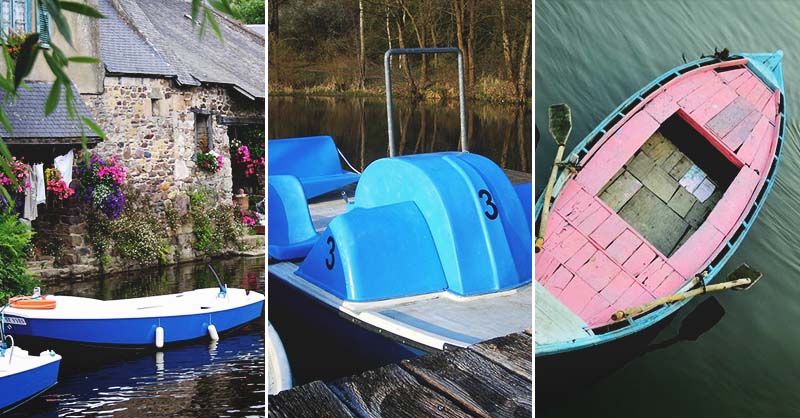
Do you enjoy spending a day out on the water every now and again? But does your budget allow you to purchase a new boat?
Well, even if you’re working on a meager budget, you could still own a boat. “How?” you might ask.
Rather simply in fact… make your own. I probably wouldn’t have thought of this idea either until a few months ago when my husband developed the itch for a boat.
He traded for a boat with a title, but it didn’t run. We’ve spent quite a few dollars and hours into making it work, and now we have a decent boat to enjoy on the water.
If you aren’t into fixing something up, I’m going to bring you some of the internet’s best ideas for making your own DIY boat. Here they are:
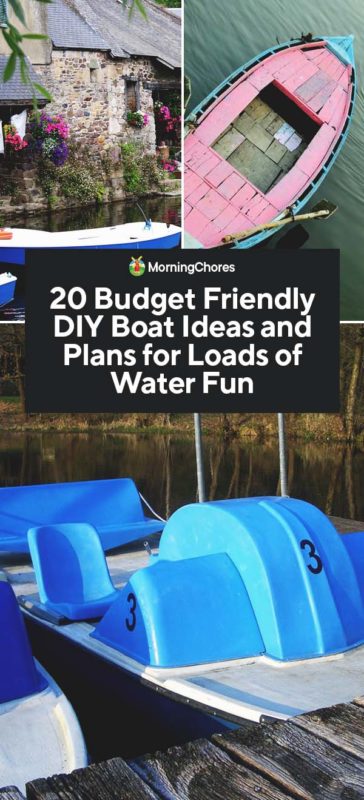
1. The DIY Tiny House Boat

We’re going to jump right in with a doozy to choose from. If you’re in the market for not only a boat but a houseboat, you may be wondering if this could ever fit in your budget.
Well, when you see this wood framed pontoon tiny houseboat , you’ll soon learn it can become a reality for you with a little hard work.
2. Basic Wooden Boat

Whether you need a small fishing boat or a smaller boat to paddle around a pond, these plans are great for either.
The plans for this boat walk you through each step of the process. If you’re a beginner in the world of carpentry, this boat could still be feasible for you.
3. PVC DIY Kayak

I wasn’t aware of how expensive kayaks could be until our oldest recently caught the urge to purchase one. Suddenly, I realized how much money a person could invest in one.
However, this kayak appears to be quite buoyant and should be quite a bit cheaper because it’s constructed from PVC pipes . How neat does it look?
4. Recumbent Pontoon Pedal Boat

Do you enjoy renting a paddle boat and heading out on the water? Then you’ll love this boat. It’s a DIY version of a paddle boat.
However, it has large floats on the side which makes it a smaller version of a pontoon boat . Also, it’s made to recline for a more relaxing ride.
5. Plywood Canoe

Canoes are a fun way to go up and down a river or other smaller bodies of water. If you’d like to have one, consider building it.
You can use these plans which show you how to construct a canoe out of plywood. This should make it more affordable yet functional too.
6. DIY Pontoon Boat

Pontoon boats are amazing boats to own. They’re great for fishing and luxurious enough to be a comforting way to cruise the water on a gorgeous day.
If you’d like to own one but can’t afford to buy, consider using these tips to help you build a pontoon boat all on your own.
7. Flat Bottom Boat Plans

One thing I’ve learned over the past few months of renovating a boat, is you don’t need anything fancy for a fishing boat – unless you want it to be fancy.
However, if you’re in the market for something simple and functional, the plans for this flat-bottomed boat should do it.
8. PVC Johnboat

A Johnboat is a great way to get out on the water and have lots of fun. They’re also functional enough to make a nice fishing boat too.
Either way, if you’re in the market for a fishing boat, consider building your own johnboat with these plans.
9. DIY Simple Wooden Boat

This option doesn’t come with plans which I could find. However, it could still be used as inspiration for building your boat.
Again, these boats would be good options if you’re someone looking for an inexpensive way to go fishing.
10. Homemade PVC Raft

This PVC raft is another option which doesn’t come with plans, but it looks simple enough to build. If you have experience in carpentry, you should be able to figure it out rather quickly.
However, this looks like a fun way to get the whole family out on the water uniquely and cost-effectively.
11. The DIY Pontoon Double Hulled Kayak

This pontoon boat is built in an abnormal but intriguing way. Instead of having typical floaters on the bottom of the boat, they used kayaks.
From there, the rest of the boat was built of foam insulation and PVC pipe. When you get creative, you can build a boat with little expense.
12. The Fishing Punt

This is another cost-effective option for a fishing boat. However, there’s no guesswork on this one. The plans are laid out and easy to read.
Whether you’re an experienced carpenter or someone who has recently begun to build things, this could be a viable option for you.
13. Inflatable Raft Fishing Boat

Are you struggling to come up with enough room in your budget to build a new fishing boat? What if you could use your inflatable raft as a boat?
Well, thanks to this idea, you can. The person who created this put a plywood bottom in a raft and turned it into an amazing little fishing boat for little money.
14. Single Plywood Boat

If you don’t need a larger boat, this could be the answer for you. It’s cost-effective because the whole thing is built from one sheet of plywood.
Even though this boat isn’t the biggest, it would make a great fishing boat for a one-person fishing trip .
15. Zip Tie and Ply Mini Boat
If you’d like to get out on the water for a fun day of fishing or sight-seeing, consider building this unique mini-boat .
It’s made from zip ties and plywood. Though it may sound a little sketchy on the surface, it seems quite buoyant and inexpensive too.
16. The Homemade Pontoon

When I saw this boat , I instantly sent it to my husband and said, “Can you build this? I may need it a little bigger to fit the kids and dog on board.” This should tell you; I love it!
But it actually is a cool idea. It looks comfortable for both cruising and fishing. Plus, it should be possible for most budgets.
17. PVC Pontoon Boat
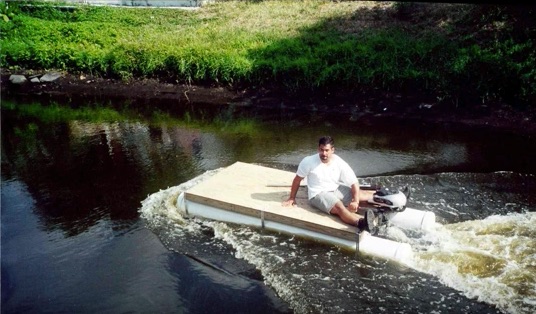
Some of you may be looking at these ideas and saying, “This is great, but I’d prefer to have a motor attached to my boat.”
Well, you’re in luck. This pontoon boat is easy to build and also shows you how to attach a motor to keep you from having to paddle everywhere you go.
18. The Micro Houseboat

If you’ve ever searched for a houseboat, you know how expensive they can be. But don’t give up on your dream yet.
Instead, look into building this tiny houseboat . It has a gorgeous interior and would make a great full-time home or a small vacation home.
19. DIY River Raft

Who says you have to build something overly complicated to enjoy a day out on the river? Well, you don’t.
Instead, build this simple raft . It’s constructed from PVC pipe and has a few seats add onto it. It looks buoyant and can help you to have many enjoyable days out on the water.
20. Seafoam Kayak

Would you like a light-weight kayak you can build yourself? Consider creating this kayak made from sea foam.
It only weighs 16 pounds and is built to be eight feet long. This could be a great way to enjoy many days out on the water without much fuss.
Now you have 20 different options for a DIY boat. You can choose between kayaks, johnboats, houseboats, tiny homes, pontoons, and much more.
We hope you’ll find something on this list to inspire you and be able to create something you can enjoy all summer long.
Was this article helpful?
What went wrong.
This article contains incorrect information
This article does not have the information I am looking for
How can we improve it?
We appreciate your helpful feedback.
Your answer will be used to improve our content. The more feedback you give us, the better our pages can be.
Follow us on social media:

The 10 Best Herbs for Making Scented Candles

How to Make a Broom with Straw or Broomcorn Stalks
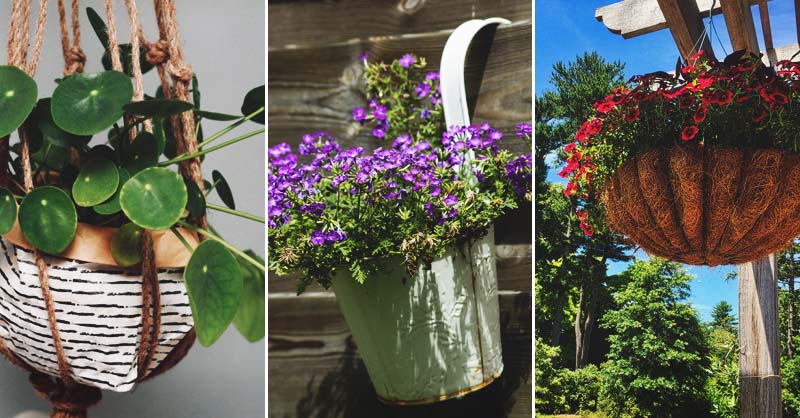
14 DIY Hanging Baskets to Display Your Floral Masterpieces

34 Creative DIY Easter Basket Ideas for Every Age
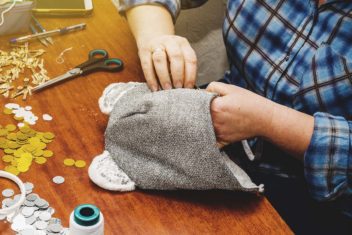
50 Beginner-Friendly DIY Sewing Projects
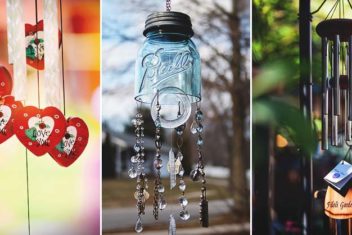
33 Charming DIY Wind Chimes to Brighten up Your Day

15 Tips and Ideas to Help You Create Decorative Garden Fences

18 Free DIY Garage Plans with Detailed Drawings and Instructions
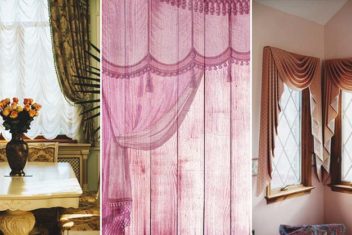
60 DIY Curtain Ideas That Will Improve Your Room in a Flash

The Different Types of Yarn and Which Is Right For Your Project

Learn How to Crochet for Beginners from These 25 Fabulous Tutorials

17 DIY Dog Crate & Kennel Ideas Your Pup Will Surely Love

Step-By-Step Guide: How to Build a Wooden Sailboat – Complete DIY Tutorial
Alex Morgan
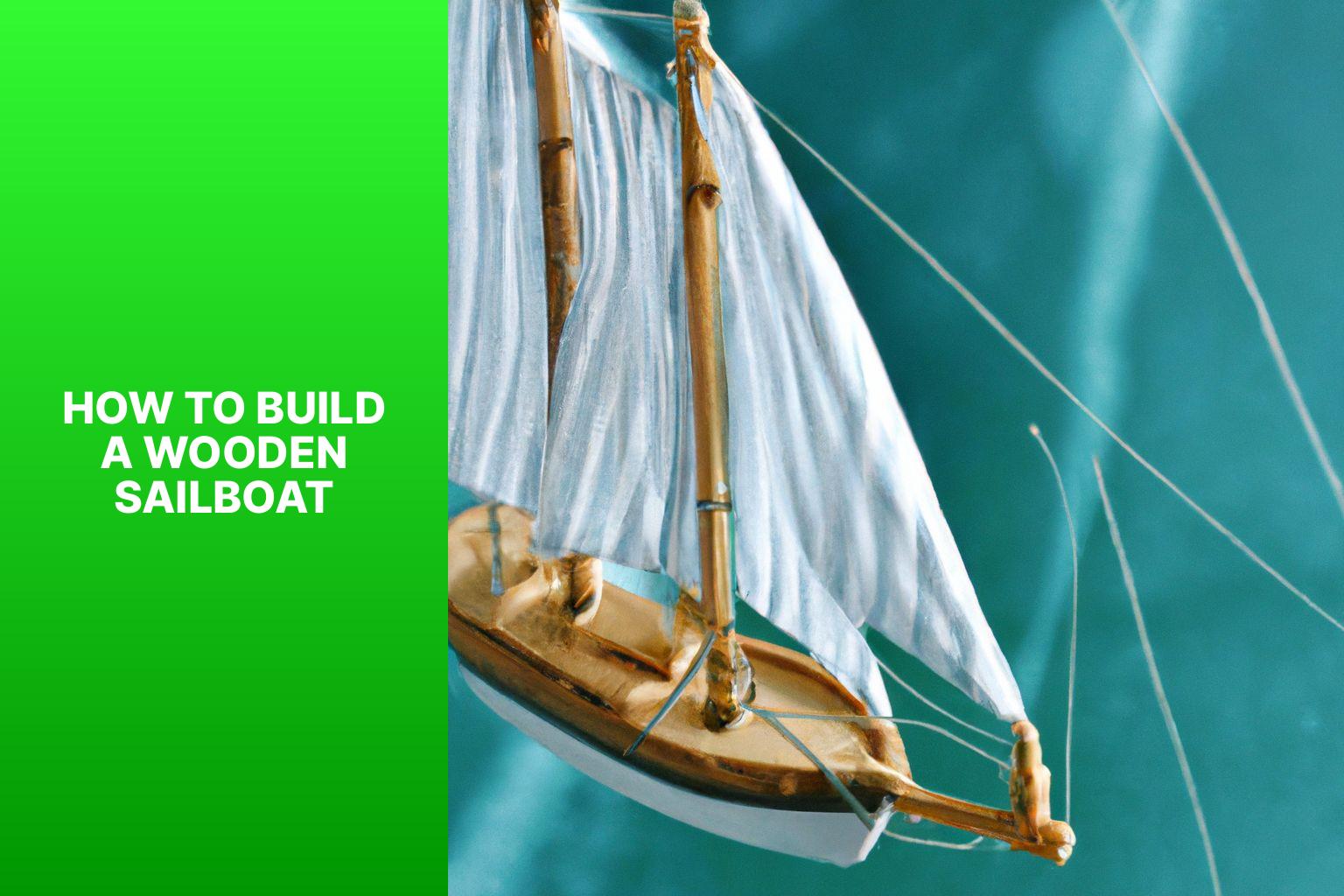
Building a wooden sailboat is a rewarding and fulfilling endeavor that allows you to create your own vessel for sailing adventures. Whether you’re a seasoned sailor or a woodworking enthusiast, constructing a wooden sailboat requires careful planning, attention to detail, and a love for craftsmanship. This comprehensive guide will take you through the step-by-step process of building a wooden sailboat, from choosing the right design and gathering the necessary materials to assembling the framework, building the deck and cabin, and installing the sails and rigging. We will also discuss the finishing touches and regular maintenance required to keep your wooden sailboat in optimal condition for years of enjoyment on the water. Let’s dive into the world of wooden sailboat construction and embark on this exciting journey together.
Key takeaways:
Key takeaway:
- Choosing the right design and plans is crucial: Research different sailboat designs and select suitable plans based on your skill level to ensure a successful project.
- Gather the necessary materials and tools: Pay attention to wood selection and preparation, as well as acquiring the tools and equipment needed for building your wooden sailboat.
- Attention to detail in the construction process is important: Prepare and assemble the framework carefully, focusing on lofting, laying out the keel, constructing the ribs, and the hull structure to ensure a sturdy and reliable sailboat.
Choosing the Right Design and Plans
When it comes to building a wooden sailboat, one of the crucial steps is choosing the right design and plans. In this section, we’ll take a deep dive into the world of sailboat designs and explore the vast array of options available. From researching different sailboat designs to selecting plans that match your skill level, we’ll guide you through the exciting process of bringing your wooden sailboat dream to life. So, hop aboard and let’s set sail on this exhilarating journey of craftsmanship and adventure.
Researching Different Sailboat Designs
When conducting research on sailboat designs, it is important to take into account a variety of factors in order to select the most suitable design. One of the primary considerations is whether you prefer a monohull or a multihull sailboat. Monohulls are more commonly found and offer superior performance when sailing upwind, whereas multihulls provide both stability and speed.
Another aspect to consider is your level of sailing experience. If you are a beginner, it is advisable to seek out designs that are easier to handle and forgiving. On the other hand, experienced sailors may gravitate towards performance-oriented designs that are ideal for racing or long-distance cruising.
It is crucial to think about how you intend to use the sailboat. Are you looking for a day sailer , a cruiser , or a racing boat ? Each design comes with its own set of distinctive features and characteristics.
Determining the appropriate size of the sailboat is another crucial step, which should be based on the number of people and activities you plan to have on board. You must also decide whether you prefer an open cockpit or an enclosed cabin .
To find the perfect sailboat design that aligns with your sailing goals and preferences, it is imperative to thoroughly research various options and take into consideration all of these factors. By doing so, you will be able to make an informed decision and select the ideal sailboat design.
Selecting Suitable Plans for Your Skill Level
When it comes to building a wooden sailboat, it is crucial to select suitable plans that match your skill level. This is important as it ensures that you have the necessary knowledge and expertise to effectively complete the construction. In order to help you with this, here is a table that outlines the different skill levels and the corresponding plans:
| Skill Level | Suitable Plans |
|---|---|
| Simplified plans with detailed instructions and minimal complex techniques. | |
| Plans that require a moderate level of woodworking skills, including more intricate joinery and techniques. | |
| Advanced plans for experienced woodworkers with in-depth knowledge of boat building and complex woodworking techniques. |
Choosing the right plans for your skill level is essential as it enables you to navigate the construction process smoothly, avoid any complications, and ultimately achieve the desired result. It is crucial to honestly evaluate your woodworking skills and then select plans that align with your abilities. Keep in mind that building a wooden sailboat demands patience , attention to detail , and a willingness to learn and improve your woodworking skills.
As a pro tip, if you are a beginner, it is advisable to start with simpler plans and gradually work your way up to more complex projects. This allows you to gain experience and confidence in your woodworking abilities over time. So always remember to select suitable plans for your skill level and enjoy the process of building your wooden sailboat.
Gathering the Necessary Materials and Tools
When it comes to building a wooden sailboat, gathering the necessary materials and tools is key . In this section, we’ll dive into the exciting world of selecting and preparing the right wood for your sailboat, as well as the essential tools and equipment you’ll need to bring your project to life. So, start sharpening your creativity and let’s sail away into the realm of wooden boat construction!
Wood Selection and Preparation
Incorporating the provided keywords naturally in the provided text:
1. Conduct research on the different types of wood used in boatbuilding, such as mahogany , teak , or oak . This will help you make an informed decision regarding the most suitable wood for your sailboat.
2. Determine the specific requirements of your sailboat design in order to guide your wood selection process. Each design may have different needs and preferences when it comes to the type of wood to be used.
3. Take into consideration the durability and resistance to rot of the wood options available. This is crucial to ensure the longevity and overall quality of your sailboat. Choosing a wood that can withstand exposure to water and other elements is essential.
4. Look for straight , dry , and defect-free wood. This will contribute to the structural integrity of your sailboat. Any defects or irregularities in the wood may compromise its strength and performance.
5. Calculate the amount of wood needed based on the specific design and measurements of your sailboat. This will help you estimate the quantity of wood required for the construction process.
6. Mill or cut the wood into the required dimensions and shapes as outlined in the sailboat design. This step is crucial for achieving the desired structure and appearance of your sailboat.
7. Prior to assembly, it is important to sand the wood surfaces thoroughly. This will remove any rough edges or splinters, ensuring a smooth and safe finish.
8. Apply a protective coating or sealant to the wood in order to prevent water damage. This will help preserve the wood and extend its lifespan .
By following these steps, you can ensure that the wood selected and prepared for your sailboat construction is suitable and of high quality.
Tools and Equipment Needed for the Project
When embarking on the construction of a wooden sailboat, it is crucial to have the appropriate tools and equipment to ensure successful completion.
To accurately measure and obtain precise alignment and dimensions, essential measuring tools such as a tape measure , combination square , and level are indispensable.
For shaping wooden components, cutting tools like a circular saw or table saw , jigsaw , and hand saw are necessary.
Joinery tools, including a chisel set , mallet or hammer , and drill with different-sized bits, are vital for smoothly joining parts together.
To achieve a polished finish, sanding and finishing tools such as sandpaper with varying grits, sanding blocks , and a random orbital sander are crucial.
Additionally, brushes and rollers are required for the application of finishes.
When it comes to safety, it is imperative to prioritize the use of safety goggles , ear protection , a dust mask , and work gloves to ensure personal protection during the construction process.
When selecting tools and equipment, it is essential to invest in high-quality items that are specifically designed for the tasks involved in wooden sailboat building.
By doing so, not only will efficiency be maximized, but the overall quality of the finished boat will also be greatly enhanced.
Preparing and Assembling the Framework
As we delve into the world of building a wooden sailboat, we now find ourselves in the exciting phase of preparing and assembling the framework. In this section, we’ll discover the essential steps that go into setting up the lofting and laying out the keel , as well as the intricacies of constructing the ribs and hull structure. Get ready to immerse yourself in the hands-on process of bringing this magnificent vessel to life!
Setting Up the Lofting and Laying Out the Keel
To properly set up the lofting and lay out the keel for a wooden sailboat, it is important to follow these steps in a systematic manner:
- Firstly, prepare the lofting area by clearing a large, flat space where the plans and measurements will be placed.
- Next, securely attach the keel stock to the lofting platform, making sure it is both level and aligned with the boat’s centerline.
- Using battens, rulers, and pencils, transfer the measurements and lines from the boat plans onto the lofting platform.
- Ensure the accuracy of the waterlines, buttock lines, and other reference lines on the lofting platform by drawing them according to the measurements provided in the boat plans.
- Utilizing the dimensions indicated in the plans, measure and mark the positions of the keel, stem, and transom on the lofting platform.
- Thoroughly examine and adjust all lines and measurements to guarantee their accuracy.
- Identify the locations where any additional frames, bulkheads, or structural elements will connect to the keel, by marking them accordingly.
- Prior to proceeding, double-check all marks and measurements to ensure their accuracy.
The process of setting up the lofting and laying out the keel is an integral step in the construction of a wooden sailboat. It serves as the foundation and reference points for the boat’s overall structure. It is crucial to pay close attention to detail and maintain accuracy throughout the build. By following these steps, you will be on your way to constructing your very own wooden sailboat.
Constructing the Ribs and Hull Structure
When constructing the ribs and hull structure of a wooden sailboat, follow these steps:
– Measure and cut the ribs: Use the plans as a guide to mark and cut the dimensions on the wood. Cut the ribs accurately.
– Attach the ribs to the keel: Position and attach the cut ribs evenly along the keel using marine epoxy and screws.
– Install chines and stringers: Attach the chines to the bottom edge of the boat and install the stringers along the sides for strength.
– Attach the planking: Cut and fit planks to cover the rib and stringer structure, securing them tightly.
– Reinforce the joints: Apply epoxy and fiberglass tape over the joints to strengthen the structure.
– Shape the hull: Use tools to shape and smooth the hull, paying attention to fairing for optimal hydrodynamics.
– Apply a protective finish: Coat the hull and ribs with marine-grade varnish or epoxy for durability.
– Perform a thorough inspection: Check for defects, cracks, or imperfections and make necessary repairs before moving forward.
The process of constructing wooden sailboats has evolved over time, combining traditional techniques with modern materials and tools. Craftsmanship, attention to detail, and an understanding of wood’s properties are still essential in constructing the ribs and hull structure. This blend of artistry and engineering ensures sailboats can withstand the demands of the sea while providing a smooth and enjoyable sailing experience.
Building the Deck and Cabin
Let’s dive into the exciting world of building a wooden sailboat! In this section, we’ll focus on the crucial element of constructing the deck and cabin. Get ready to explore the process of creating the deck framework and adding those essential interior features . From laying the foundation to crafting a cozy cabin space , we’ll uncover the key steps and considerations for bringing your wooden sailboat to life. So, grab your tools and let’s set sail on this exhilarating construction journey !
Creating the Deck Framework
When creating the deck framework for a wooden sailboat, follow these steps:
- Measure and mark the desired deck size and shape on the boat’s frame.
- Cut and shape the wooden planks or panels to match the marked measurements.
- Align the planks or panels horizontally across the frame, ensuring they are straight and evenly spaced.
- Secure the planks or panels to the frame using screws or nails, ensuring tight fastening.
- Add additional support beams or joists underneath the deck for added strength and stability.
- Sand the deck surface to create a smooth and even finish.
- Apply a weather-resistant sealant or paint to protect the deck from moisture and UV damage.
- Install necessary features or fixtures on the deck, such as hatches, cleats or railings.
Pro-tip: Enhance the deck’s strength and durability by adding epoxy or marine adhesive between the joints before securing the planks or panels.
Installing the Cabin and Interior Features
When building a wooden sailboat, it is important to pay attention to every step, including the installation of the cabin and interior features. To install these features, follow the following steps:
1. First, measure and cut the materials for the cabin walls, floor, and ceiling.
2. Next, securely fit the cabin walls in place.
3. Then, attach the floorboards to the cabin base using screws or nails.
4. Align and install the cabin ceiling.
5. If desired, add insulation for extra comfort.
6. Attach interior features such as cabinets, storage compartments, and seating areas.
7. Install windows and hatches to allow for natural light and ventilation.
8. Properly wire the cabin for electricity, ensuring that lights and outlets are installed and functioning.
9. Finish the interior by sanding and applying a protective coat of varnish or paint.
10. Ensure that all installations meet safety standards.
Precision and attention to detail are key when installing the cabin and interior features of a wooden sailboat. By carefully measuring, cutting, and fitting each component, you can ensure a secure fit. It is important to optimize the layout and functionality of the interior features to create a comfortable living space with ample storage. The addition of windows and hatches will enhance comfort and enjoyment by providing natural light and ventilation . If electricity is needed, proper wiring is essential to ensure necessary lighting and power outlets. Finishing the interior with a protective coat of varnish or paint will not only enhance aesthetics but also provide durability.
Remember, the goal is to create a cozy retreat for sailors, so it is important to put in the necessary effort to install the cabin and interior features correctly.
Installing the Sails and Rigging
Set sail with confidence as we dive into the exciting world of installing the sails and rigging for your wooden sailboat. Discover the key considerations in choosing the perfect sails and master the art of setting up and adjusting the rigging. With expert tips and tricks , this section will equip you with the knowledge to navigate the waters with ease and experience the thrill of sailing your wooden masterpiece .
Choosing the Right Sails
When choosing sails for your wooden sailboat, consider the following factors:
– Type of sailing: Determine if you plan to cruise , race , or do both. Different sails are designed for specific purposes.
– Boat size: The size of your sailboat determines the size and number of sails you need. Larger boats require bigger sails , while smaller boats may need fewer and smaller sails .
– Wind conditions: Consider the typical wind conditions in your sailing areas. Different sails perform better in light winds , heavy winds , or various wind conditions.
– Sail material: The material of the sails affects durability and performance. Material choices include Dacron , laminate , and nylon . Each material has different trade-offs between longevity, performance, and cost.
– Reefing options: If you sail in varied or unpredictable wind conditions, choose sails with reefing options. Reefing allows you to adjust the sail area for stronger winds, improving control and safety.
– Manufacturer reputation: Research sail manufacturers for their reputation and reliability. Read reviews, seek recommendations, and consider warranty and customer support.
By considering these factors, you can make an informed decision when choosing sails for your wooden sailboat. Remember, the right sails greatly impact your sailing experience, so take your time and choose wisely.
Setting Up and Adjusting the Rigging
When setting up and adjusting the rigging of a wooden sailboat, it is important to follow these steps to ensure proper and safe rigging.
To start, attach the mast to the deck using a mast step or mast partner for stability and support. This will provide the foundation for the rigging.
Next, secure the standing rigging , which includes the shrouds and stays , to the mast. This will help distribute the forces from the sails and ensure the stability of the mast.
Connect the forestay to the bow of the sailboat. This will keep the mast in line and control the position of the headsail.
To counteract forces from the headsail and maintain rigging tension, attach the backstay to the stern of the boat.
Use turnbuckles or rigging screws to adjust the tension in the standing rigging. This will ensure proper alignment and support of the mast.
Install the running rigging , including halyards and sheets , to control the position and tension of the sails.
Before and during sailing, it is important to regularly check the tension in the rigging to ensure performance and safety.
Make any necessary adjustments to the rigging during sailing in order to optimize the shape of the sails and enhance the performance of the boat.
By following these steps, you will be able to properly set up and adjust the rigging of your wooden sailboat, allowing for safe and enjoyable sailing experiences.
Finishing Touches and Maintenance
When it comes to completing your wooden sailboat and keeping it in top shape, this section has got you covered. We’ll dive into the art of applying exquisite finishes to the hull and deck, giving your sailboat a stunning appearance. And don’t worry, we won’t neglect the nitty-gritty details of regular maintenance and care, ensuring your wooden vessel remains seaworthy for years to come. So, let’s get ready to add those finishing touches and keep your sailboat sailing smoothly !
Applying Finishes to the Hull and Deck
When building a wooden sailboat, applying finishes to the hull and deck is crucial for durability and aesthetic appeal. Here are the steps to follow:
1. Prepare the surfaces: Sand down rough spots, fill in cracks and imperfections, and ensure a smooth and clean surface.
2. Choose the right finish: Consider the type of wood and desired look. Varnish provides a glossy and traditional appearance, while paint offers different colors and styles.
3. Apply the primer: Enhance adherence and create an even surface for the final coat by applying a primer.
4. Apply the finish: Use a brush or roller to apply the chosen finish coat to the hull and deck. Follow the manufacturer’s instructions for drying times and application techniques.
5. Allow for drying and curing: Follow the manufacturer’s instructions for drying and curing to ensure the finish is fully set and provides maximum protection.
6. Inspect and touch up: After drying, inspect the hull and deck for missed spots or imperfections. Touch up any areas that require additional finish for a seamless and polished look.
By following these steps and applying finishes properly, you can protect and enhance the hull and deck of your wooden sailboat, ensuring it looks beautiful and lasts for many years.
Regular Maintenance and Care for Your Wooden Sailboat
Regular maintenance and care for your wooden sailboat is crucial for its longevity and performance. Here are the steps to follow:
1. Inspect the hull and deck for damage like cracks or rot. Promptly repair any issues to prevent further damage.
2. Clean the boat regularly with mild detergent and freshwater to remove dirt, salt, and grime that can accumulate over time.
3. Apply a protective coating to the hull and deck using marine-grade varnish or paint to prevent water penetration and protect against UV damage.
4. Check the rigging and sails for wear or damage. Replace worn-out lines or rigging components for safe sailing.
5. Inspect wooden components such as the mast, boom, and rudder for rot or decay. Replace or repair as necessary to maintain structural integrity.
6. Keep the interior of the sailboat clean and dry to prevent mold and mildew growth. Use a dehumidifier if needed.
7. Regularly check and maintain the boat’s systems , including electrical, plumbing, and navigation equipment. Address any issues promptly.
8. Store the wooden sailboat in a suitable location, such as a covered boat dock or boatyard, when not in use. Protect it from extreme weather conditions.
Pro-tip: Establish a regular maintenance schedule and keep a detailed record of all maintenance and repairs. This will help you stay organized and ensure your wooden sailboat remains in optimal condition.
Some Facts About How To Build A Wooden Sailboat:
- ✅ Building a wooden sailboat can take approximately 100 hours over a span of 3 months. (Source: Instructables)
- ✅ A wooden sailboat can cost around $1,000 to build. (Source: Instructables)
- ✅ The boat is typically built from 4×8 sheets of plywood and measures 8 feet in length. (Source: Instructables)
- ✅ Various tools such as a pull-saw, table saw, router, sander, and drill are needed for building a wooden sailboat. (Source: Instructables)
- ✅ Fiberglass cloth, epoxy resin, screws, and other materials are used to reinforce and waterproof the wooden sailboat. (Source: Instructables)
Frequently Asked Questions
1. how long does it take to build a wooden sailboat.
Building a wooden sailboat typically takes about 100 hours spread over approximately 3 months.
2. What materials are needed to build a wooden sailboat?
To build a wooden sailboat, you will need 4×8 sheets of plywood, epoxy resin, oak plywood, various tools (such as a pull-saw, table saw, router, etc.), fiberglass cloth, screws, fasteners, and other supplies like glue, clamps, and mixing cups.
3. How much does it cost to build a wooden sailboat?
The estimated cost of building a wooden sailboat is around $1,000, including the materials and tools needed for the project.
4. Can I learn to build a wooden sailboat if I have no prior experience?
Yes, building skills can be learned gradually, and mistakes can be avoided along the way. With patience and guidance from boat building plans, even beginners can successfully build a wooden sailboat.
5. How long is the wooden sailboat described in the reference?
The wooden sailboat described in the reference is an 8-foot long pram, featuring classic lines and made from 4×8 sheets of plywood.
6. Can I launch the wooden sailboat in any body of water?
Yes, the wooden sailboat is designed to be light enough to fit in a small pickup truck or be rolled to a local lake on a dolly, making it suitable for various bodies of water.
About the author
Leave a Reply Cancel reply
Your email address will not be published. Required fields are marked *
Save my name, email, and website in this browser for the next time I comment.
Latest posts

The history of sailing – from ancient times to modern adventures
History of Sailing Sailing is a time-honored tradition that has evolved over millennia, from its humble beginnings as a means of transportation to a beloved modern-day recreational activity. The history of sailing is a fascinating journey that spans cultures and centuries, rich in innovation and adventure. In this article, we’ll explore the remarkable evolution of…

Sailing Solo: Adventures and Challenges of Single-Handed Sailing
Solo Sailing Sailing has always been a pursuit of freedom, adventure, and self-discovery. While sailing with a crew is a fantastic experience, there’s a unique allure to sailing solo – just you, the wind, and the open sea. Single-handed sailing, as it’s often called, is a journey of self-reliance, resilience, and the ultimate test of…

Sustainable Sailing: Eco-Friendly Practices on the boat
Eco Friendly Sailing Sailing is an exhilarating and timeless way to explore the beauty of the open water, but it’s important to remember that our oceans and environment need our protection. Sustainable sailing, which involves eco-friendly practices and mindful decision-making, allows sailors to enjoy their adventures while minimizing their impact on the environment. In this…
How to Build a Wood Sailboat

Introduction: How to Build a Wood Sailboat
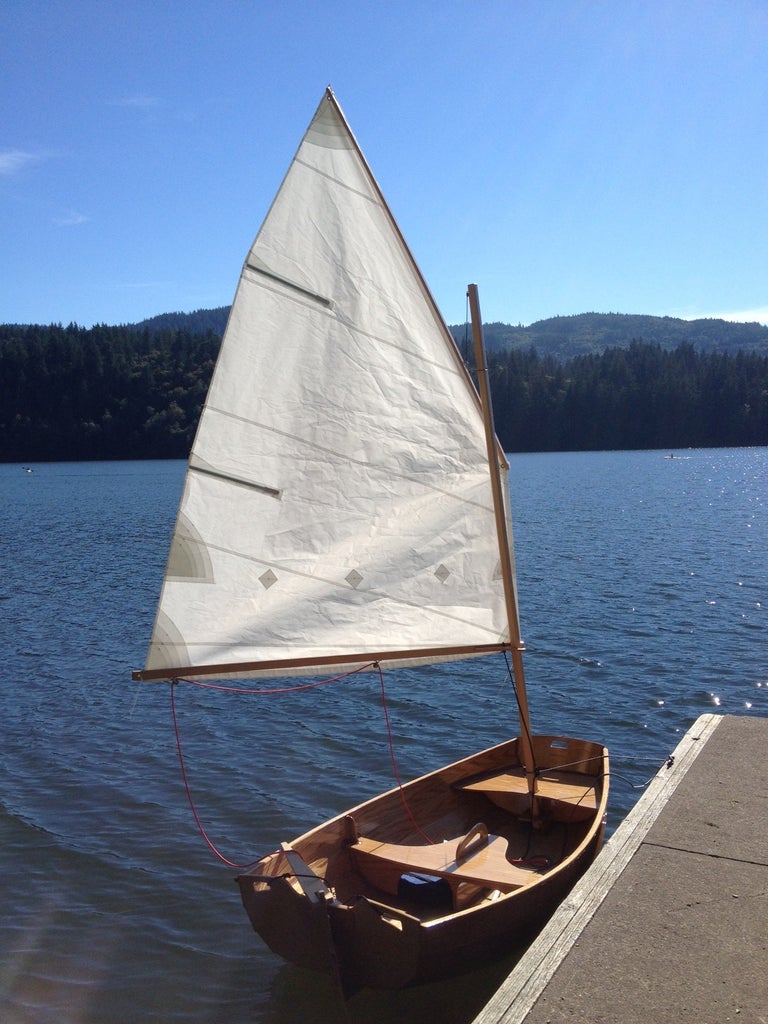
I've been wanting to combine my two favorite hobbies - woodworking and sailing for a long time, so I thought I'd build a boat. It's got classic lines and looks so dazzling in the sunshine that people constantly stop me at the boat ramp to ask me about it. There's something unbelievably rewarding about building something like this from scratch. This is definitely a boat that is much better built than bought . Here's how I did it.
The boat takes about 100 hours to build. I did it over 3 months, working a little bit just about every day and full days when my schedule permitted.
It will take about $1,000 in total to build if you buy everything at full retail cost (not including tools you might need to buy), but you can spread that across the length of the project. For example, you only need to buy one $30 sheet of plywood at a time, take it home, draw out the parts (loft) that fit on just that sheet and cut them out. That will take a couple of hours right there. Some boating supply stores (chandleries) might let you setup an account which might give you a discount if you tell them you're building a boat.
All of the skills needed to build a sailboat can be learned slowly, one step at a time. For example, if you've never fiber-glassed plywood before, just practice on a small piece first to get your confidence up. This was my first boat build, so I did a lot of learn as you go . Not only am I going to show you the right way to successfully build your own sailboat, but I'm going to share with you the mistakes I made along the way to hopefully save you from repeating them.
The end result will be a very attractive little 8 foot long pram, that is easily made out of 4x8 sheets of plywood that is light enough to put in the back of a small pickup truck or roll down to the local lake on the optional dolly. Anything longer would require you to either make a scarf joint (which is a bit tricky) or buy longer sheets of plywood (which is considerably more expensive).
What you will need:
Boat building plans
8 panels of 1/4" oak plywood 4'x8'
Pencil, Sharpie, ruler, tape measure, yard stick, etc.
Long flexible straight edge
Box of 1" brad nails
2 gallons of epoxy resin
1 gallon of epoxy hardener - SLOW
1 quart silica thickener
5 quarts wood flour thickener
1" masking tape
Japanese pull-saw
Table saw (helps, but optional)
Round-over router bit
Flush trim router bit
Palm/random orbital sander
220 sanding discs
Combination square
Drill bit set
Drill bit extension
Basic hand tools
Small diameter wire or zip ties
Wire cutter
12 C-clamps - 3"
Mixing cups, mixing sticks, rubber/nitrile gloves
16' x 60" of 6oz fiberglass cloth
2" plastic spreader
Gallon of waterproof glue
Glue roller
Silicone bronze screws
Stainless steel fasteners
Small blocks
Gudgeon & pintle - dinghy size
Patience - large
Elbow grease - large
For more detailed explanations on each step and more specific info/reviews on the materials and parts used, check out my boat build blog: www.Midnight-Maker.com
Step 1: Cutting Out the Parts...
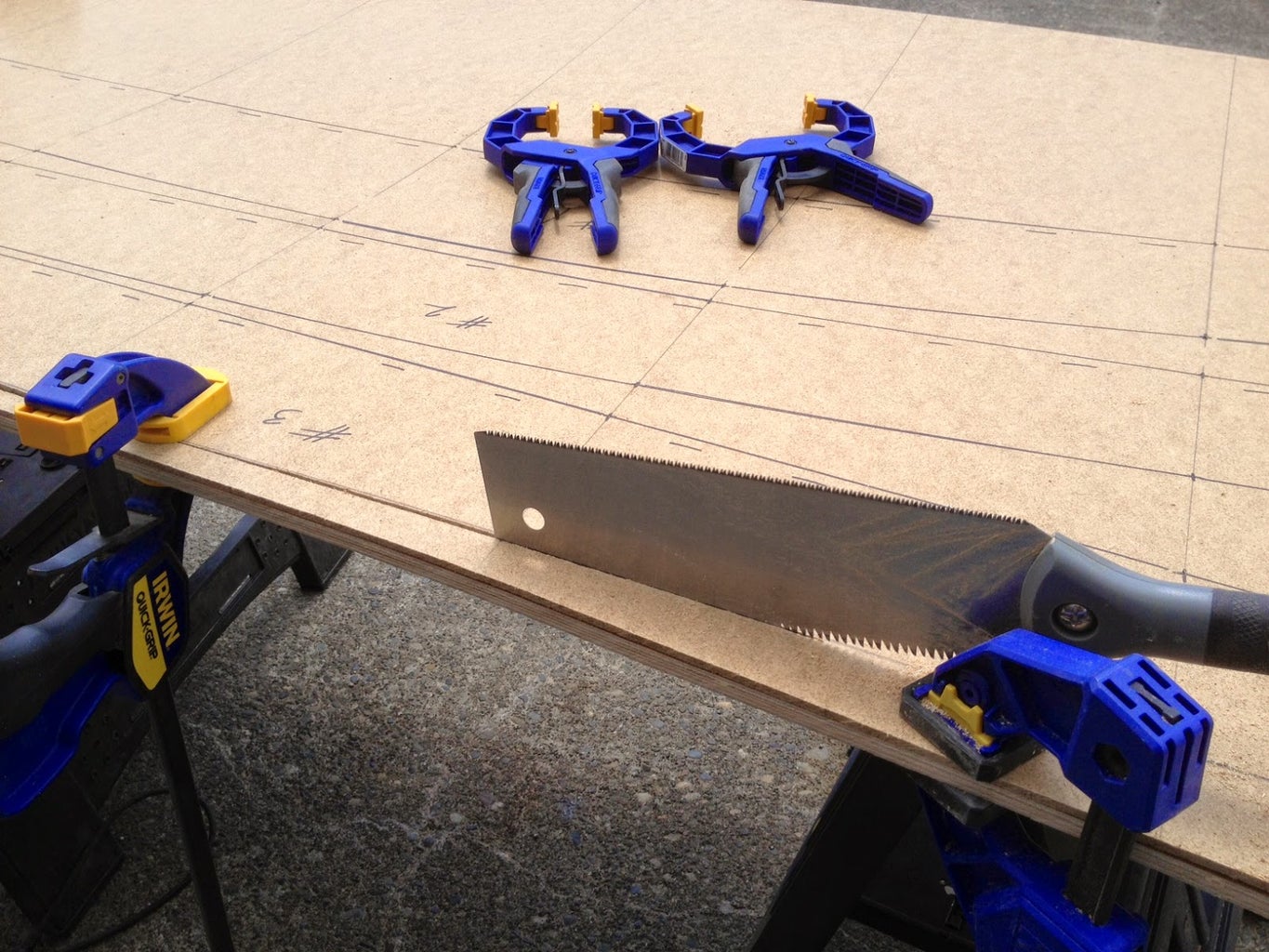
First, you'll need boat building plans. I purchased some very nice ones from a popular boat building website because I had a specific style in mind to build, a "pram". It's a Norwegian design with lots of buoyancy in the bow and building a pointy boat is a little more difficult. There are a bunch of free boat building plans (search "dinghy") online. Also, I wanted my boat parts to fit in a standard (read cheap) 4'x8' sheet of plywood. It also had to be light enough for me to load/unload/move myself. This boat weighs in at about 70 pounds. When on the custom dolly I built, it's very easy to move from the parking lot to the lake.
Next, you'll need to draw out the parts of the boat full-sized onto the plywood (lofting). I actually did this step on hardboard/masonite because I wanted to make templates of all the parts in case I ever wanted to build another one.
This step requires you to be very meticulous. Carefully transfer the measurements (offsets). They may or may not look correct because it's very non-intuitive to look at curved boat parts that are laying flat. Some parts actually bend the opposite way you think they should. To make the curves, I nailed a bunch of 1" brads into the panel and used a long, flexible straight edge (yard stick, etc.) bent to follow the curve, then I traced the curve with pencil/Sharpie. Once I removed the brads, I had perfectly smooth curves. Keep in mind that with the side panels that are symmetrical to both sides of the boat, only draw out one version and cut two stacked sheets at a time. This ensures the boat will not be lop-sided. Make sure to immobilize the two sheets together with screws outside of the boat parts or use double-sided tape/clamps, etc. to keep the parts registered properly.
Using a Japanese pull-saw allows you to control the cuts very carefully and it can follow the graceful curves. They cut on the pull stroke which means they're very easy to control. Make sure you leave a bit of your cut line, meaning cut just outside the line. This allows you a bit of a safety margin and you can always sand to the line to sweeten it up. This is where the elbow grease really kicks in. It takes hours to cut out the hull panels by hand, but it's worth it. I tried cutting the first part out with the jigsaw and it wandered all over the place and quickly cut inside the line before I knew it. Also, a jig saw blade can lean to one side which could mean two panels might not be the exact same shape. Using hand tools is a classic way to do woodworking and is a very gratifying process. With hand tools, things happen slow enough for you to be in total control, whereas power tools can quickly do unexpected damage. With the understanding that you're building a classic boat, using hand tools wherever possible is part of the philosophy.
The plans I bought were in metric and called for 6mm (1/4") and 9mm (3/8") plywood, but I wanted to make everything out of 1/4" plywood so the thicker parts in the plans were glued together with two layers of 1/4" (so at 1/2" they were a bit thicker than designed). I actually liked this because it made the boat feel sturdier and of course it was cheaper that way. The trade-off was that the boat would be a bit heavier.
For any of the parts that need to be doubled-up/laminated (e.g. the transoms), now is a good time to do that. Make sure you use "waterproof" glue instead of "weatherproof" glue like I did...
Spread a thin layer of glue over one of the "bad" sides (plywood usually has a good side and a bad side, glue bad sides together so good sides show on both outside faces), making sure it's completely covered (I used a special glue roller), then carefully place the other half on top. Align all of the edges together, then clamp them in place. Now put heavy things carefully on top to press the parts together. The glue should be dry in about 6 hours.
NOTE: It's considerably easier and safer to do any woodworking processes to the parts before you assemble the boat. This way, you can safely clamp pieces to the work bench and cut out handle holes, etc. Since my boat is a "lapstrake" design, I had to route a rabbet (groove located on the edge) carefully on the bottom edge of each side panel. This creates a shoulder for the parts to sit on, positively locating them while you're stitching the panels together. Likewise, the grab handles in the transoms are much easier to cut out before putting the boat together.
Also keep in mind that any mistake will be considerably more painful the further you are along in the build. For example, if I biff cutting out the grab handle holes while they're just loose pieces rather than when they're a permanent part of the boat, it's much easier to recover - just make another transom. If you had to patch a hole in the boat, it would be difficult and possibly never look perfect. No pressure...
Step 2: Assembling the Hull...
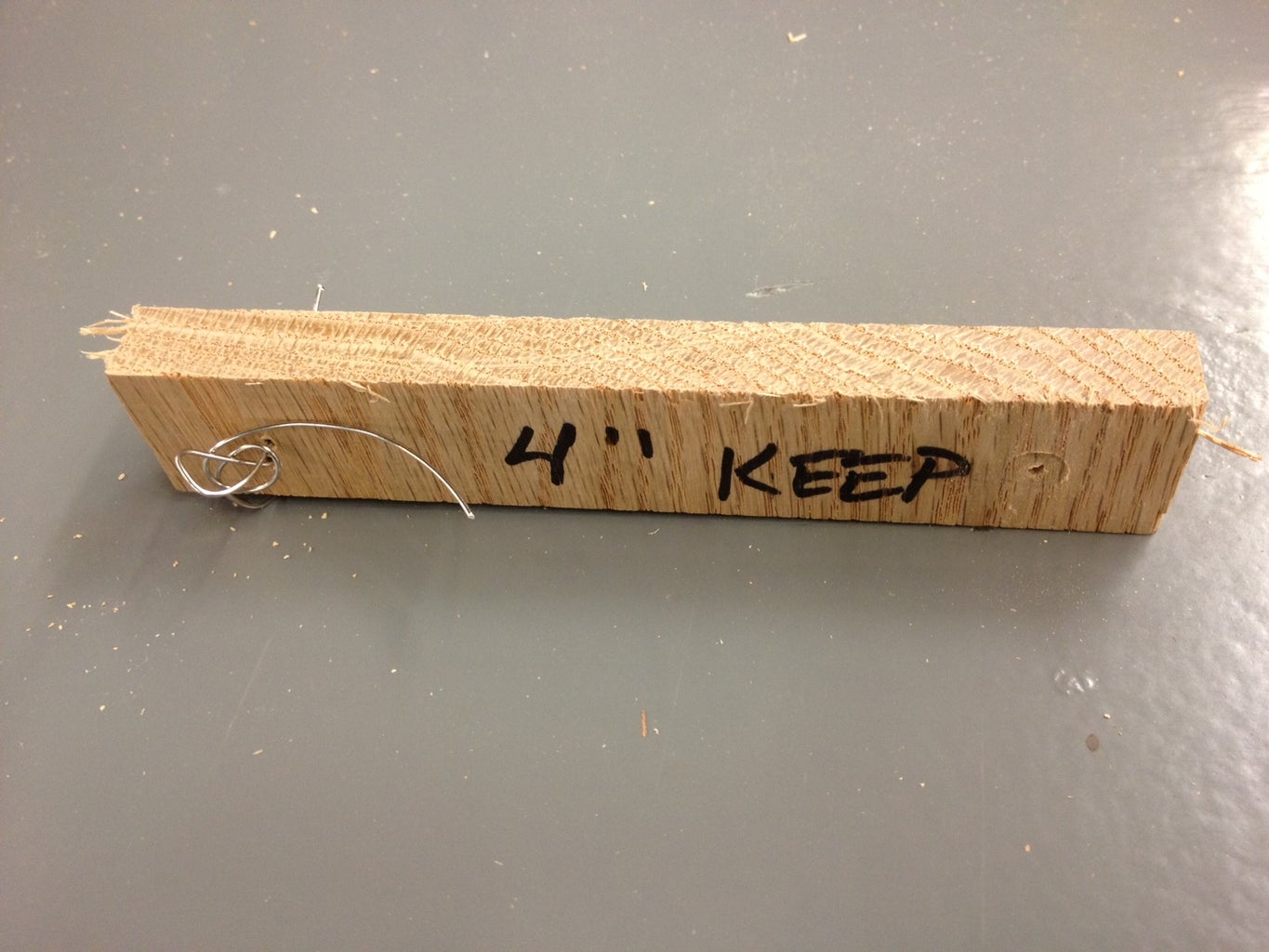
Once you have the bottom and sides cut out, you can start to "stitch and glue" the hull together. This is a technique used usually for smaller boats to be able to pull the hull form together without the need to build a frame or mold (which can take almost as long and as much wood as the boat itself).
I built a gauge stick to make sure my holes were perfectly spaced at 4" at 1/2" in from the plywood edge. It was 1" wide so either edge was the required 1/2" from the centerline. I worked my way down one side of each of each mated seam and drilled all those holes at once while the panels could lay flat on the bench. Make sure to use a backer block to prevent tear out on the back side, even with such a small drill bit.
With one mating panel drilled with a 1/16" drill bit, hold the mating panel in it's relative position. I used some spare twine to wrangle my panels into the proper orientation as I was marking them. Make a pencil mark where the mating hole should be, remove the pre-drilled panel and drill the second set of holes 1/2" in from the edge. This makes sure there's enough strength to hold the boat together.
The first pass on the stitches is just to get the hull together structurally. You can always go back and make the stitches fancier/tighter and tweak the position of the panels.
The stitches go from the inside out. Cut 6" lengths of wire and bend them into long, narrow U's that are the width of the distance between the holes. Stick the ends through the holes and carefully twist the tails together on the outside of the hull, making sure not to damage the plywood. If you're using zip ties, then the holes you drill will need to be bigger and you'll have to start on the outside, go in, turn around, then back out, then "zip".
Make sure your panels' rabbet shoulders are resting securely on the mating panel and carefully tighten all the stitches. For my boat, once I had two panels stitched to the bottom panel on each side, it was time to attach the transoms (ends). Once all of the exterior parts are stitched together, you should have something that looks like a boat. It will be a little rickety at this stage, but that's okay.
NOTE: In the photos I took of my build, you'll notice that the transom doublers (reinforcers) aren't in place. That was because I was following the instruction manual, but I think that was a mistake, so I highly recommend laminating (gluing) the doublers to the transoms before you stitch the boat together.
Step 3: Reinforcing the Hull Joints...
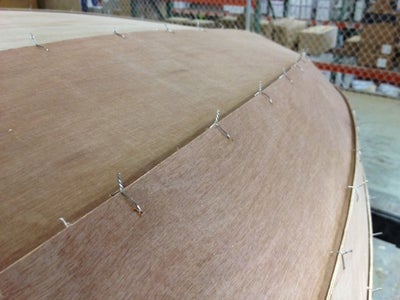
Now that the hull is stitched together, flip it over upside down. You'll be surprised at how stiff it is, considering how difficult it was to wrangle all those panels into position. Be careful, there's lots of poky wire ends sticking out all over the place.
I used a technique called "tabbing", meaning I made small, structural tabs from thickened epoxy that fit between the stitches, then I removed the stitches and made one long, larger fillet to connect the hull panels together.
Make sure your panels are perfectly aligned and tightened. I used a nipper to lop off most of the tails so they wouldn't get in the way, but that left very sharp spikes.
Make sure your boat is square. Take diagonal measurements from corner to corner, make sure the boat parts are parallel to each other, etc. because if there's a twist in your boat, the next step will make it permanent, which will affect the boat's performance.
Now mix up a batch of epoxy and silica thickener according to the manufacturer's directions (meaning each type of epoxy has a different resin to hardener ratio) until it's between the consistency of thick ketchup, but runnier than peanut butter (make sure to mix the 2 parts of epoxy together first very well before adding a thickener). Too thick and it won't fill the void, too thin and it'll run down inside the boat. Both are bad. I used a small syringe to inject the mix into the V intersection between the panels and checked underneath/inside to see if there were any runs.
Once the epoxy has partially set, use a glove wet with denatured alcohol to smooth out the "tabs" so they fit inside the V groove and don't extend above the intersection between the panels. This will give you good practice for the seams that will show on the finished boat. Be careful of the wire spikes.
Repeat this process for every seam on the hull. Let it cure overnight.
Once the tabs have cured, carefully remove the stitches. If the wire seems to be epoxied permanently to the hull, heat the wire with a lighter. That will soften the epoxy enough to pull the wire out. Be careful not to scorch the boat (you don't want a Viking funeral). Now repeat the thickened epoxy process for each overlap, except this time each seam will need to be one long, smooth joint. Let it cure overnight. This goes a long way in making the boat hull structural.
Step 4: Fiberglassing the Hull...

Now that you've got a permanent hull shape, it's time to make it waterproof and rugged. Fiberglass and resin over plywood is a tried and true Do It Yourself boat building technique which makes it strong and light.
Mask off the bottom panel and roll out your fiberglass cloth. Smooth the cloth out very carefully so as not to snag or tweak the fibers' orientation. Mix up an unthickened batch of epoxy (it will be the consistency of syrup). Starting at the stern, pour a small puddle of epoxy and spread it out nice and thin. You should be able to squeeze most of the epoxy out of the cloth, leaving only saturated cloth with no dry spots (which will appear white) but the weave should still be showing (meaning no extra epoxy is pooling). You should easily be able to see the wood grain through the cloth now.
Let the epoxy partially cure and using a razor, slice the dry fiberglass cloth away on the taped seam. Then remove the masking tape. Let the epoxy cure overnight.
Flip the hull over and mix up a batch of epoxy that is the consistency of peanut butter. I masked off the joint, but this step is optional, but keep in mind that it will be visible if you plan on finishing the interior bright (varnished wood). It's not as critical if you're painting the interior. With a plastic spreader, carefully make a large radius transition (fillet) between the bottom panel and the first side panel (garboard). Remove the masking tape when the epoxy mixture is partially cured and carefully scrape/wipe any unwanted mixture. It's much easier to remove now than having to sand it all off later. At this point, it's also a good time to fillet the transoms to the sides using 3/4" radius tabs between stitches and 1" finished fillets after you've removed the stitches. Let the fillets cure overnight.
Now, repeat the entire fiberglassing process on the inside. Except instead of just doing the bottom panel, make sure both the bottom and the garboard are fiberglassed. This is basically the waterline of the boat. The fillet should allow the fiberglass cloth to smoothly make the bend between boards. Remove the excess cloth when partially cured and let sit overnight. Some people fiberglass up onto the transom at this stage which will make the boat stronger, but that means you have to have already filleted the transoms to the bottom.
Step 5: Installing Interior Parts...

The bulkheads get stitched in place just like the panels. They will make the already stiff (and much heavier boat) completely structurally sound and push/pull the sides into their final shape. Then make 3/4" "tab" fillets between the stitches to lock them in place, remove the stitches and make long, smooth 1" fillets. The smaller fillets will get covered by the larger fillets. I used two different modified plastic spreaders to do this step. Each spreader was cut with a box knife and filed/sanded into its final shape.
While you're doing the previous steps, if you're in a time crunch, go ahead and build the daggerboard trunk. It's made of numerous parts that are pre-coated with a couple layers of unthickened epoxy, then glued together with silica-thickened epoxy. This makes it strong and waterproof as it will be below the waterline so must be completely waterproof.
The daggerboard trunk is the most important part of the boat, especially if you're making a sailboat version (this boat can easily just be used as a rowboat). Not only does it support the center seat (thwart), but it has to transfer all of the force from the sail to the water and if you run the boat aground, it takes all the shock loading from the daggerboard.
The daggerboard gets filleted into place like everything else. Make sure it's perfectly on the centerline of the boat as that will affect its sailing characteristics.
Next, let's make the daggerboard slot in the center thwart. I set up a straight edge with a spiral upcutting router bit. Make sure to enlarge the slots at the end of the center thwart so that it can fit around the fillets of the center bulkhead. Now is the time to ease the edges of the center thwart because you'll be sitting on it a lot, so it needs to be comfortable. Because it's so thin, I only routed the top edge of the center thwart that shows and just hand sanded the edge underneath (it's very problematic to use a round-over bit on the second side of a thin board). Paint all of the thwarts with three coats of unthickened epoxy, especially the undersides. Once the woodworking is done, the thwart can be epoxied into place with peanut butter (or you can jump to cutting the daggerboard slot in the bottom of the hull). Make sure the thwart fits snugly in place. Drop dollops of peanut butter on the top edges of the center bulkhead and daggerboard case and spread it out evenly (make sure none gets inside the slot to interfere with the daggerboard). Firmly seat the thwart (pun intended) into the goop and weight it down. Let it cure overnight.
While you've making sawdust, cut out the mast hole (partner) in the forward thwart by drilling holes in the four corners (for the square mast we're going to make), then cut out the sides, file it smooth, then round over the top edge with the router.
Any time after the bulkhead thwart fillets have cured, you can seal the airtank chambers. Paint the bottom, sides, inside of the bulkhead and transom up to the level where the thwart will be.
Step 6: Rail & Sailboat Parts...

There are several processes in this boat building instructable that can be done concurrently. While you're waiting for the epoxy on one part to cure, you can be doing woodworking or epoxying another part. This step illustrates that point. While you're waiting for the epoxy on the rub rail (outwale) to cure, you can be fabricating the sailboat accessories (e.g. daggerboard, rudder, tiller, spars, etc.).
In order for the outwale to be thick/strong enough to be effective, you'll need to laminate it in two strips on each side. You can't bend a single piece that thick around the curvature of the hull without either breaking the wood or softening it by steaming it which is a complicated process.
Take a strip that's half the final thickness and a little longer than the boat edge (I made mine a bit beefier), mix up some peanut butter with the colloidal silica and carefully spread it on the inside of the strip. Starting at the stern, clamp it in place, perfectly align it with the top edge of the plywood. Now you have a long, springy lever to bend the wood strip along the compound curve. It dips both vertically (shear), and bows out at the widest part of the boat (beam), then back in toward the bow. At least every foot, clamp it as you go, moving forward. More is better. Toward the bow, the strip will get stiffer as it gets shorter. Once clamped in place, scrape/wipe off all the squeeze-out. It's much easier to remove now than after it hardens. Let it sit overnight. You'll have to repeat this three more times, meaning this step takes four days (if you're using "slow" epoxy hardener).
During those four days that you're dealing with the outwale, you can make major progress on the sailboat parts. They're completely separate from the hull. If you're just making a rowboat, then you can skip making these parts.
The daggerboard and rudder are cut out and laminated. Then a bevel is ground onto the leading and trailing edges to make it slice through the water more efficiently. Then they're covered in layers of epoxy. The mast step is assembled. This has to be very strong because all of the force of the sail is transmitted to the boat through the mast step and the mast is a very long lever arm. The rudder cheek plates and tiller also have to be assembled similarly to the daggerboard case.
NOTE: Whenever there's a hole to be drilled into any part of the boat, you must take additional steps to make sure the water doesn't penetrate and damage the wood. The correct procedure is to drill an over-sized hole, completely fill that hole with epoxy (I usually put a piece of masking tape on the back side to act as a dam), then once the epoxy cures, re-drill in the center of the epoxy plug the correct hole size. That makes each hole in the boat possibly a 2 day process, so plan accordingly. You can also use 5 minute epoxy to knock out a bunch of holes quickly, but be careful, they're not kidding. This stuff gets rock hard very quickly and will permanently glue anything touching. This is exactly how you drill the hole for the pivot point for the rudder/cheek plate assembly. If the pin is 1/4", then drill 1/2" hole and fill that with epoxy. Now the 1/4" hole will fit nicely in the center and be completely waterproof.
Since all the parts need several coats of unthickened epoxy and they just about all have holes in them, I hung them up with some twine and painted them on all sides, one layer at a time, for several days. Make sure the rudder doesn't get too thick to fit inside the cheek plates.
Step 7: Making the Spars...
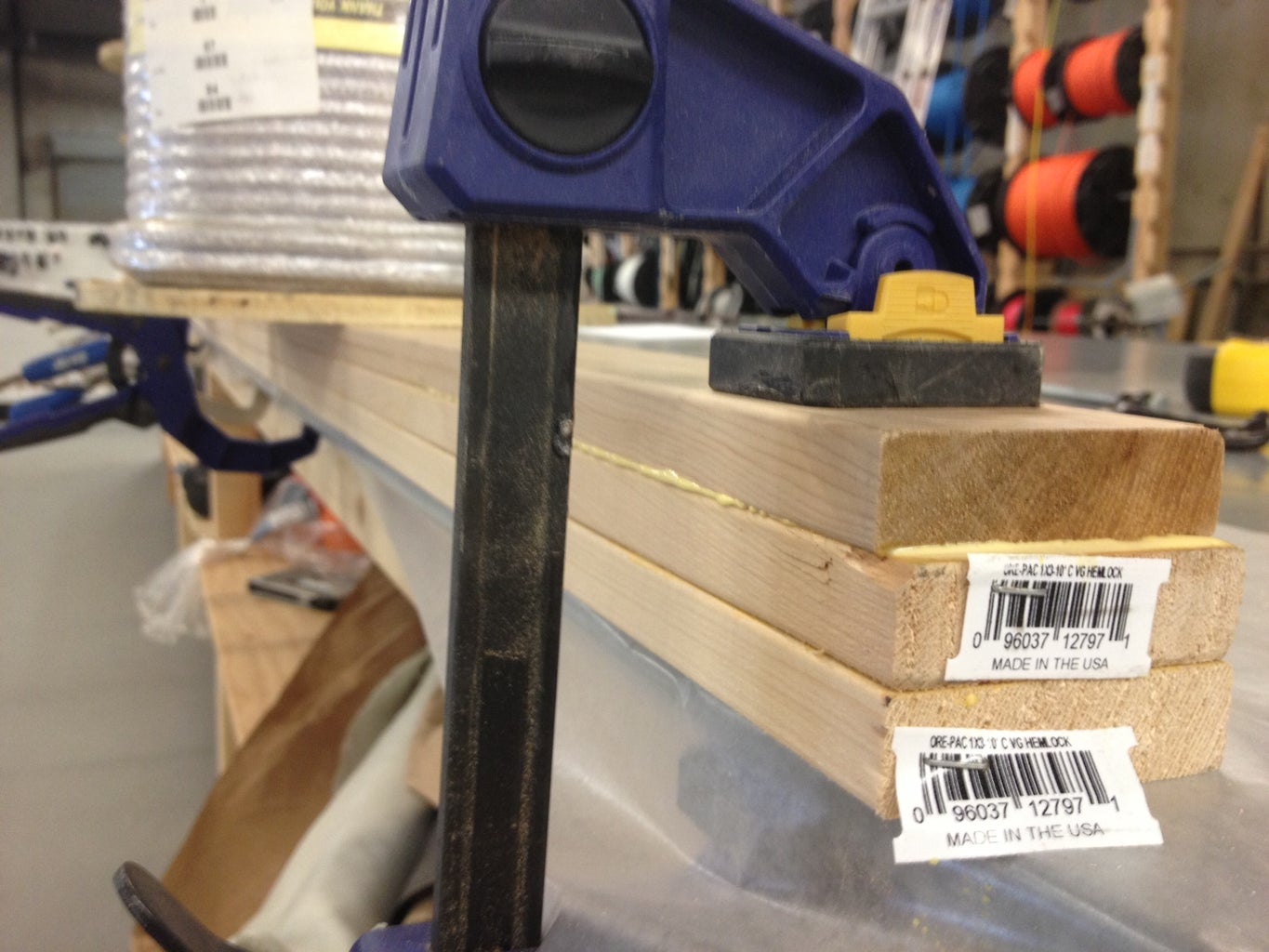
More sailboat parts you can make while waiting for other parts to cure are the spars, the structural parts that support the sail. The mast is another glue up. I used 3 - 1x3's of hemlock. A relatively soft wood, but with a nice tight grain with no knots. A mast would break at a knot, regardless of how strong the wood is. Using the waterproof glue, align the pieces as perfectly as you can then clamp up the assembly and let dry overnight. Then run it through a table saw to get the final dimensions. Use a router and a round-over bit to ease the edges. Cut to length and sand the sharp corners. It should fit easily, but snugly into the forward thwart.
The boom (bottom of sail) is a little more complicated. Cut out the gooseneck (boom pivot point) by using a hole saw first, making sure to clamp it securely to the workbench, then cut out the profile. This gets attached to another piece of 1x3 hemlock, after it's been cut to length and the edges have been rounded over.
The yard (top of sail) is easy. Just cut to length and round over the edges. Drill and fill any holes in the spars at this time. You'll need at least one hole on each end to lash the sail grommets to.
This time, everything gets covered with several coats of varnish, epoxy is not necessary. The varnish protects the wood from water and UV damage.
The reason we had to make at least the mast at this point is because we'll need it in the next step to establish the location of the mast step.
Step 8: Finishing Up the Interior & Exterior...

Once the outwales are successfully attached, trim them flush with the face of the transom(s). While you're at it, use a flush cut saw (with no sawtooth offset to mar the wood) to trim the sides flush with the transom. This will show you how well your injected silica mix worked earlier. Now you're ready to install the mast step.
The mast step must be precisely located on the floor (sole) of the boat to give the mast the proper angle (rake). This is very important because it directly affects the boat's ability to sail upwind. Using your mast, insert it into the forward thwart (partner) and into the mast step. With the mast at a 3° angle (mostly vertical but with a small, yet noticeable and graceful tilt toward the stern of the boat), trace the location of the mast step. Use a combination square to make sure it's perfectly aligned side to side (athwartship). You can now set the mast aside. Drill and fill holes in the bottom of the boat so that you can securely screw the mast step from the outside of the hull. The mast base must also be epoxied to the sole with peanut butter. After it's screwed into place but before the epoxy cures, make sure to test fit the mast again and verify the rake angle is correct. It would be a little messy at this point if you had to tweak it, but at least you wouldn't have to cut it off.
Now comes the most unpleasant part of the whole build. On your hands and knees, make a 1" radius fillet on the underside of every part in the boat. I didn't worry about making these pretty, just structural and water tight (these create the flotation tanks that keep the boat from sinking if you capsize). Let that cure overnight.
Next is the scariest part of the build, making the slot in the hull for the daggerboard. Using a drill bit extension, from the inside of the boat, reach down through the daggerboard case and drill a hole at each end of the slot through the bottom of the boat (make sure to use a backer board). Drill a couple holes in between, then take a jigsaw and connect the dots. This weakens the hull enough so that the router won't tear out any extra wood. Note, this step can easily be done prior to affixing the center thwart. Using a flush trim/laminate router bit, let the bearing run around the inside of the daggerboard case. This will make the hole in the hull perfectly match the slot. This is important because you don't want a shoulder on the inside for the daggerboard to hit and you don't want to damage the waterproof lining of the case. Last, ease the sharp edge of the daggerboard slot with the router and a small radius round-over bit.
The skeg must be cut to fit the curve of the hull (rocker), then using silicone bronze screws, attach it to the hull using the same drill and fill/peanut butter techniques. Make sure to snap a chalk line on the centerline of the boat for reference. Then make a 1" fillet where it meets the hull which will support the skeg and make it strong. The skeg keeps the boat tracking straight in the water. I optionally used some fiberglass cloth to cover the skeg and overlap onto the bottom to make the entire assembly stronger and more waterproof. The skeg will take the brunt of the abuse when launching, beaching, loading and unloading, etc. I also installed a stainless steel rubstrake on the aft end of the skeg with this in mind. In wooden boat building, silicone bronze screws are often used because they won't corrode when encapsulated like stainless steel screws can.
Install the skids parallel to the skeg. These are solid pieces of hardwood because they will also take a lot of abuse when the boat is sitting on shore, protecting the thin hull from rocks, etc. They get installed the same way as the skeg, although it's a little tough to bend the wood along the rocker. Scrape off the excess peanut butter once they're screwed in place.
I also installed the optional outboard motor pad at this point because I plan to use an electric trolling motor on the back to quietly putter around the lake in the evenings to relax with the family after work.
That should be the last parts that go into making the boat!
Step 9: Finishing the Hull...

Now comes the last dash to the finish line. One of the more tedious steps is that you now have to sand the entire boat. I actually built the entire boat inside, but for the sanding stage, I took her outside. Several hours of sanding all of the fillets nice and smooth. Everything will show in the finished product whether you paint the boat or leave it "bright" (unpainted). If you've been careful about cleaning up the peanut butter as you go, you should be able to sand the boat with mostly 220 grit. Be careful not to sand through the thin veneer of the plywood. After the sanding is done (make sure to use a dust mask), vacuum the entire boat and then wipe it down with a tack cloth to remove any dust. I also reversed the hose on the shop vac and used it to blow the sawdust off since I was outside.
Next, you must coat the entire interior and exterior with 3-4 coats of unthickened epoxy. This makes the entire boat waterproof. It will also give you an idea of how beautiful the wood will look when varnished. This is why a lot of boat builders decide to leave their boats bright so the beauty of the wood shows through.
Mix up 1 cup batches of unthickened epoxy and pour out large puddles onto the surface. Taking a foam roller, distribute the epoxy in a smooth coat. Now take a wide foam brush and gently smooth (tip) the rolled out surface. This should remove any lap marks or bubbles. Move along to the next area, making sure to not touch the wet parts. Also, make sure no dust or bugs get on your finish or it'll mean even more sanding later.
Start with the exterior first. It'll be much easier to get good by practicing on the convex surfaces. The interior is more tricky because you want to prevent sags and pooling by only applying very thin coats.
Make sure to check with the manufacturer's directions during this step in case you have to deal with "blushing", a thin layer that can sometimes form on the surface of epoxy when it cures. This could cause your layers to not stick to each other. If your epoxy does blush, it's easy to just wipe the entire boat down with a rag soaked in acetone after each coat has cured. Some people sand between coats of epoxy. This is how you would make an extremely smooth/shiny finish, so if you want your boat to be museum quality, invest the effort. I'm planning on banging my boat around so opted out of an extreme, fancy, mirror finish.
I was originally going to paint the exterior of the hull, which would require priming and painting, but I'm leaving it bright for the time being. The good news is that you can always paint later if you change your mind, but if you paint it and change your mind, it's tough to go back. There aren't a lot of pics of this step, which took a couple of days because there wasn't much visible progress after that first coat went on. At this point, any surface that's not painted should be varnished using the same "roll and tip" method as the epoxy, with the optional sanding between coats. Note that epoxy has no UV resistance, so to keep your boat from getting sunburned, you must either paint or varnish every surface. Giving a boat a "museum quality" paint and/or varnish finish can literally take as long as building the boat.
Step 10: Making the Sail...

Another step you can do while other parts are curing is make the sail. This particular design uses a "lug" sail, a classic looking sail for small boats with wood masts. It increases the sail area (therefore the force generated by the wind) without it having to be as tall as a modern sailboat mast made of aluminum. There is a kit from an online sailmaking company that you can get for a reasonable price. The Dacron cloth panels are all cut out by a CNC machine, so they fit perfectly together. I used a regular, domestic sewing machine, not an industrial one. The only time I had trouble was when sewing through all 7 layers at the reinforcement patches. When I got to those parts, I had to manually push down on the foot of the sewing machine with a flat-bladed screwdriver (minus) to help push the needle through the Dacron. We jokingly call Philips head screwdrivers "plus".
The panels/parts all come labeled. The directions were a bit confusing because they suggest you make sub-assemblies after the fact to make wrangling the large sail easier but they mention it after you've already sewn the large panels together. It's important to understand what parts go together while the panels are still small and more manageable. For example, the batten pockets are tricky enough to build on a single panel, much less the finished sail. Building the sail was about as difficult for me as building the boat, but it was worth it.
The lug sail gets reinforcement patches on all four corners where you attach it to the spars (bend), and there's also a reefing point for when the wind starts to pick up (freshen). Modern sails have three corners (Marconi rig).
I opted for the less expensive white Dacron sail kit, but there's also a classic red (tanbark) colored kit that's $100 more expensive. Before I sewed a single stitch, I carefully traced every part of the sail kit onto painter's tarp poly film so I can always use the templates to build another sail, all I need to do is buy the tanbark cloth.
Step 11: Rigging Your Sailboat...

This seems to be the trickiest part for most people, probably because there are numerous ways it can be successfully rigged, depending on your experience, preferences or criteria. It's confusing because you have to know what the finished setup will look like in your mind while you're staring at a pile of ropes. I chose a setup that allows the most room in the cockpit for a full-sized adult, so the mainsheet is led forward of the skipper's position. This keeps the skipper's attention forward so they're looking where they're going. I have another boat where the mainsheet is behind the skipper and it takes some practice getting used to.
The lines I made up (rope becomes a line when you give it a job description) were the halyard (hauls the sail up), the mainsheet (adjusts the angle of the sail to the wind = trim) and a traveler bridle (where the mainsheet attaches to the boat). I got fancy and spliced all my ends, but you can just as well use a bowline knot.
I installed a cheek block at the top of the mast instead of the large diameter hole in the directions. I wanted the halyard to run as smoothly as possible when setting the sail. Then I installed a pair of cleats at the base of the mast, one for the halyard and one for the downhaul (cunningham). With both of these lines pulling in opposite directions, it locks the sail in place, flat, so it effectivley acts like a wing. The main halyard attaches to the gaff with a snap onto a padeye. This allows easy on/easy off when rigging at the boat ramp. I also used a small loop (parrel) around the mast and through the eye to keep the gaff located close to the mast. I looped the downhaul over the boom and down to the cleat to try to keep the gooseneck from twisting. Note, except for the blocks, just about all of the hardware used on rigging a boat this size can come in stainless steel or brass/bronze, depending on the look you're going for. If you plan on installing oarlocks to row the boat, this decision becomes even more important to the final look of the boat.
For the mainsheet, I made a short bridle between the handles on the transom with a small eye tied in the center. This allows a place for the snap on the end of the mainsheet to attach to. I could've just as easily allowed the snap to slide, which would give the bridle the function of a traveler, but would affect its pointing ability (sail upwind). The mainsheet is then run to a block on the end of the boom, then to another block in the middle of the boom. This leaves the main cockpit area unobstructed with running rigging. Make sure your mainsheet is long enough for your boom to swing forward of 90° to the boat, with enough to still come back to the cockpit for the skipper to control. A stop knot at the end of the mainsheet will keep the mainsheet from getting away from you and give you something to grip.
The rudder pivot hardware (gudgeons and pintles) must be installed perfectly vertical and on the exact centerline of the boat so that she will sail well. Drill and fill the necessary holes for this hardware. Be careful with the spacing. It's designed to be easily installed and uninstalled while underway.
With this particular rigging layout, when under sail, the skipper must constantly keep the mainsheet in hand, which is a good idea anyway for safety reasons (if you get hit by a gust of wind = puff, you won't get blown over = capsize). The tension on the mainsheet is easily manageable for any size skipper. On larger boats, the mainsheet is held by a fiddle block with a cam cleat, which is not necessary for a boat this size. With that being said, a possible future upgrade would be to install a block and a camcleat somewhere on the centerline of the boat so that more advanced sailors wouldn't need to constantly have to oppose the tension on the mainsheet. Of course the trade-off would be the hardware would probably be somewhere you might want to sit.
Another upgrade I figured out after actually taking her sailing would be to rig up a bungee/shock cord system that will hold the daggerboard both in an up and down position. With the current setup, the centerboard is held down by gravity and must be pulled out of the slot when beaching.
Step 12: Go SAILING!
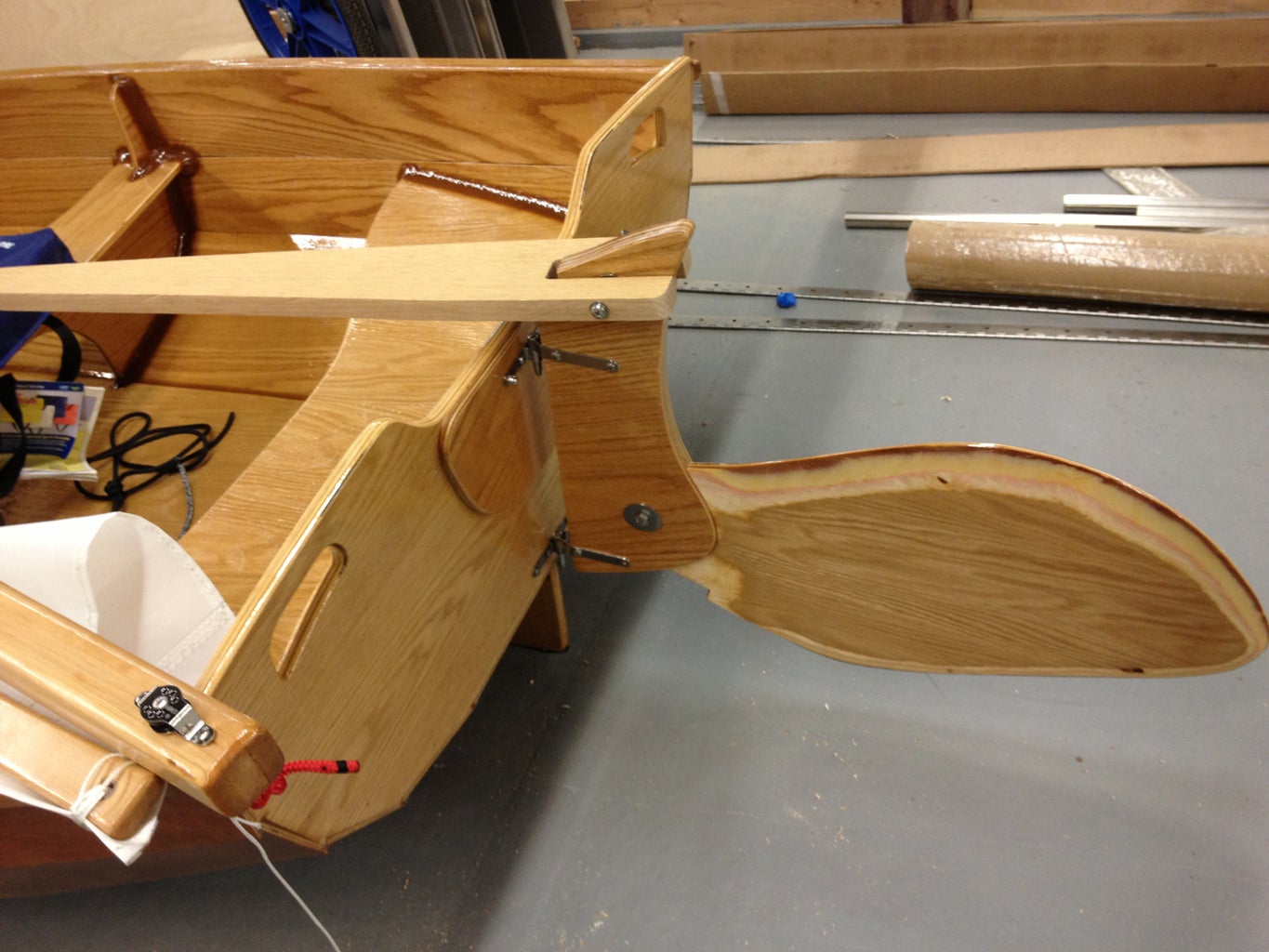
Because I wanted to be able to go sailing by myself if needed, I made a dolly out of 2x4's and large pneumatic tires (which makes the dolly float). The dolly fits securely between the center and aft thwarts when driving out to the lake. The sides on the dolly lock against the skids on the bottom of the boat so it can't twist. Roll the sail up with the spars and wrap it with the main halyard. At the designed length, the mast doesn't fit inside the boat, but it seems a bit long, so some people have cut the mast down enough so that it fits inside the boat.
Out at the lake, unload the boat, slide the dolly underneath and you're ready to roll down to the ramp. At the launch, roll the boat out into the water until it floats off the dolly, toss the dolly off to the side out of everybody else's way. Drop the daggerboard into the slot and install the rudder assembly. Facing into the wind (important), stick the mast into the receiver hole (partner), tie off the downhaul (cunningham) and hoist the sail until the downhaul is tight, then cleat off the main halyard. Reave the mainsheet (run the line through the blocks) and you're ready to go sailing.
I've found that this boat sails very well. The lug sail makes it very easy to sail upwind (weather helm), it's a little more tender for a large adult, more so than a boat with a hard chine, like an El Toro/Optimist but it's a lot more graceful looking. The payload is very reasonable for a boat this size. My wife and son can easily (and safely) go sailing with me and I don't even need anyone's help to get it rigged and launched. All in all, this is one of the best projects I've every built. I hope you too can discover the joy of building your own boat and then take her sailing. Remember, in sailing, the wind is free, but nothing else is...
This is my very first Instructable after many years of referencing this excellent site to build numerous cool projects (you should see my next post). Anyway, I hope you enjoy it and please feel free to ask any questions you may have and I'll do my best to answer them. I'm planning on building a larger boat in the near future so stay tuned...

Participated in the Wood Contest

Participated in the On a Budget Contest
Recommendations

Colors of the Rainbow Contest

Farm to Table Contest

Woodworking Contest


How to Build a Boat
Classic boat plans from a 1937 issue of Popular Mechanics , updated for the 21st century.
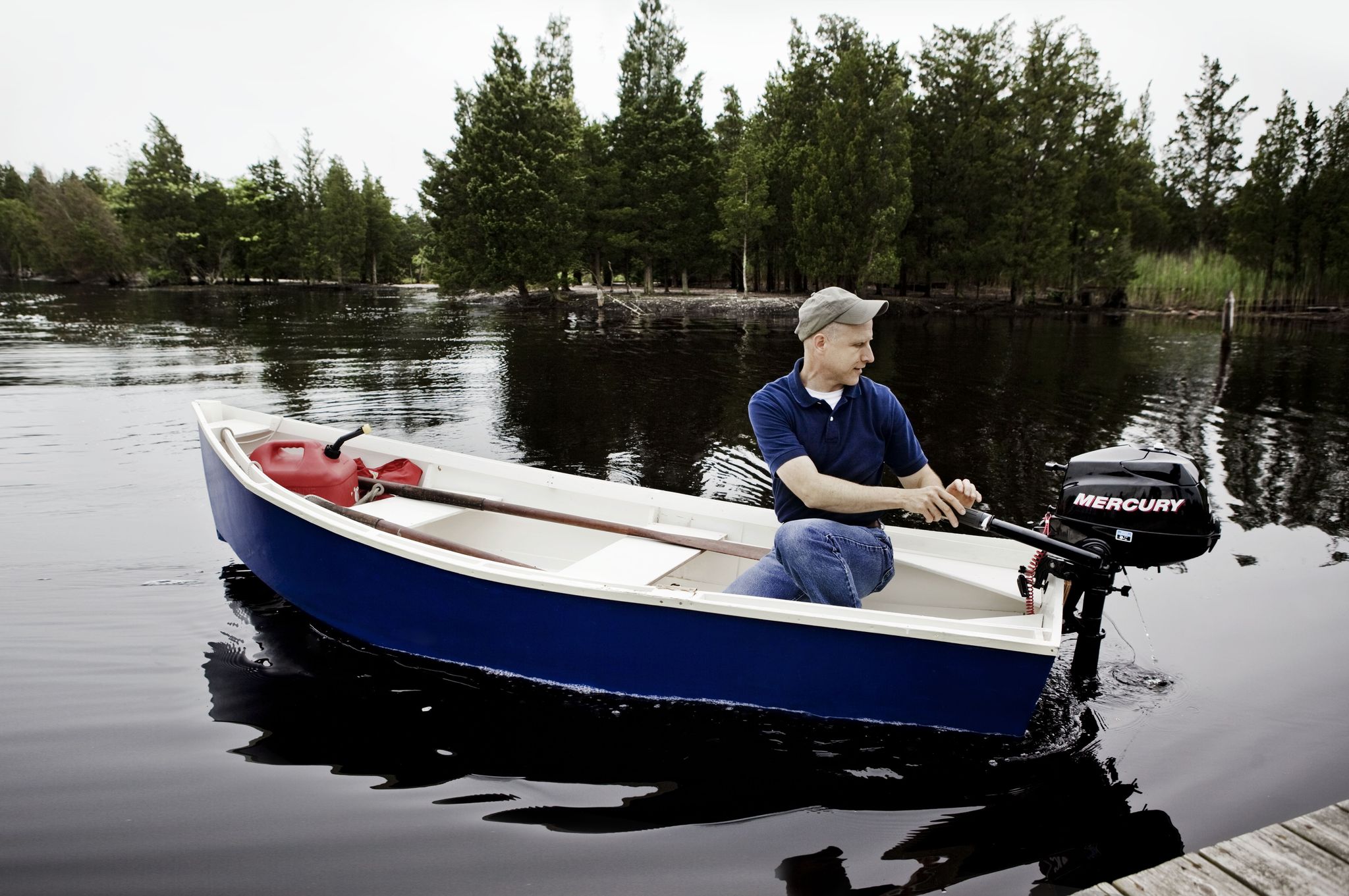
It was a long time since anyone in my family had built a boat. The last was my Uncle Paul. He was a shipbuilder who learned his trade beginning at age 14 in Hamburg, Germany. Every morning, the boy rowed from the family's dock out across the shipping lanes of the Elbe River, which flows into the North Sea.
The trip to the shipyard where he was apprenticed took an hour and a half, longer in winter, when there was fog and floating ice on the water. After three years, Paul received a journeyman's certificate and a berth aboard a gigantic four-masted windjammer named Passat—"trade wind" in English. That was in the 1920s, before the fascists confiscated his family's own small shipyard and the Berendsohns left for America.
A few months ago, I decided to try my hand at the ancestral trade. I've built everything from houses to a blacksmith's forge , but there's no more evocative project than a boat, at least to me. Since before Austronesians first gazed across the Pacific, wooden vessels have stood for craftsmanship and the drive to explore. I sifted through PM's archives looking for a classic design and eventually settled on a 10-foot dinghy from our May 1937 issue . It looked elegant, yet simple enough to build on a pair of sawhorses.
It's been many years since my Uncle Paul was around to lend advice, so I ran the drawings past Timo White, a boatbuilder at Tuckerton Seaport, a small maritime museum on the New Jersey coast. It turned out that Timo was in the midst of restoring a surfboard built from plans in the July 1937 issue of PM. (It was a big year for seafaring projects, I guess.)
He confirmed that the dinghy was a good candidate for a first-time builder and agreed to lend a hand if needed.
Shipyard in the Driveway
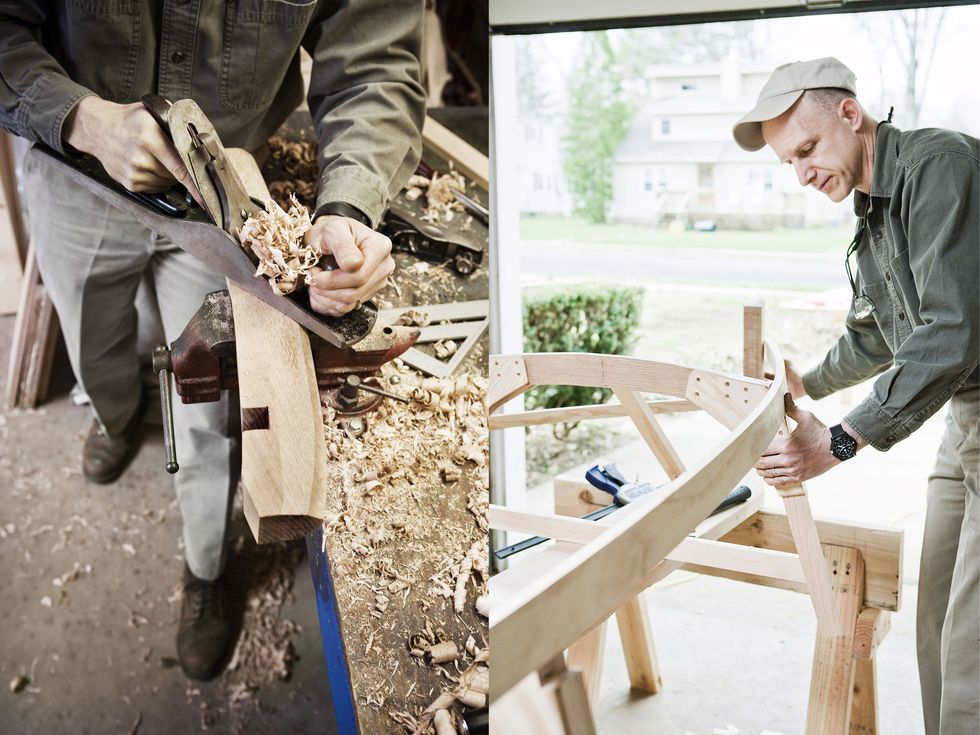
On a wintry early spring morning I set out for Willard Brothers Woodcutters, a sawmill and lumber dealer in Trenton, N.J. You can spend hours there, roaming stacks of delicious-looking walnut, cherry and oak, some of the boards as wide as your arm is long. I bought red oak for the Sea Scout's frames (that was the name of the craft in the plans, and I chose to keep it) and a 2-inch-thick slab of white oak for the wedge-shaped stem at the bow.
Back home, I started making a racket feeding planks through a table saw. My skills were creaky--I've spent too much time in recent years fixing stuff and not enough building--but over a few days my old confidence returned. The Sea Scout began to take form.
Most boats begin with the frames, the ribs that provide structure to the hull. I roughed them into shape, along with the stem and the gracefully shaped stern wall, or transom, which I cut from ¾-inch plywood. Then I braced it all to a building board--which is nothing more than a 2 x 10 with a chalk line marked down the center.

⚠️ To simplify the project, I omitted the mast and centerboard. Instead, I built the Sea Scout, named after the craft in the original article, to be rowed or powered by an outboard motor. She works well in either configuration. You can find the original plans and materials list here.
The boat's skeleton was in place, but each member still needed to be precisely beveled before I could secure the curved planks of the hull. The next step was to clamp thin strips of wood, called battens, to the frame to stand in for the planks, so I could measure and mark all those angles. Then, I took the parts off the board and finished shaping them.
Often, the weather confined me to the garage, but when the sun emerged I worked in the driveway. If you want to get to know the neighbors, start building a boat. Linda from next door asked whether the craft would be sailed, rowed or powered by an outboard motor. Others wondered where I would go with it, how I'd get it there and what I would name it. A truck driver from Tulnoy Lumber, dropping off some marine plywood, approached respectfully. "This is beautiful," he said, with an old-fashioned New York accent as broad as the hand he ran over the frames.
Anatomy of a Boat
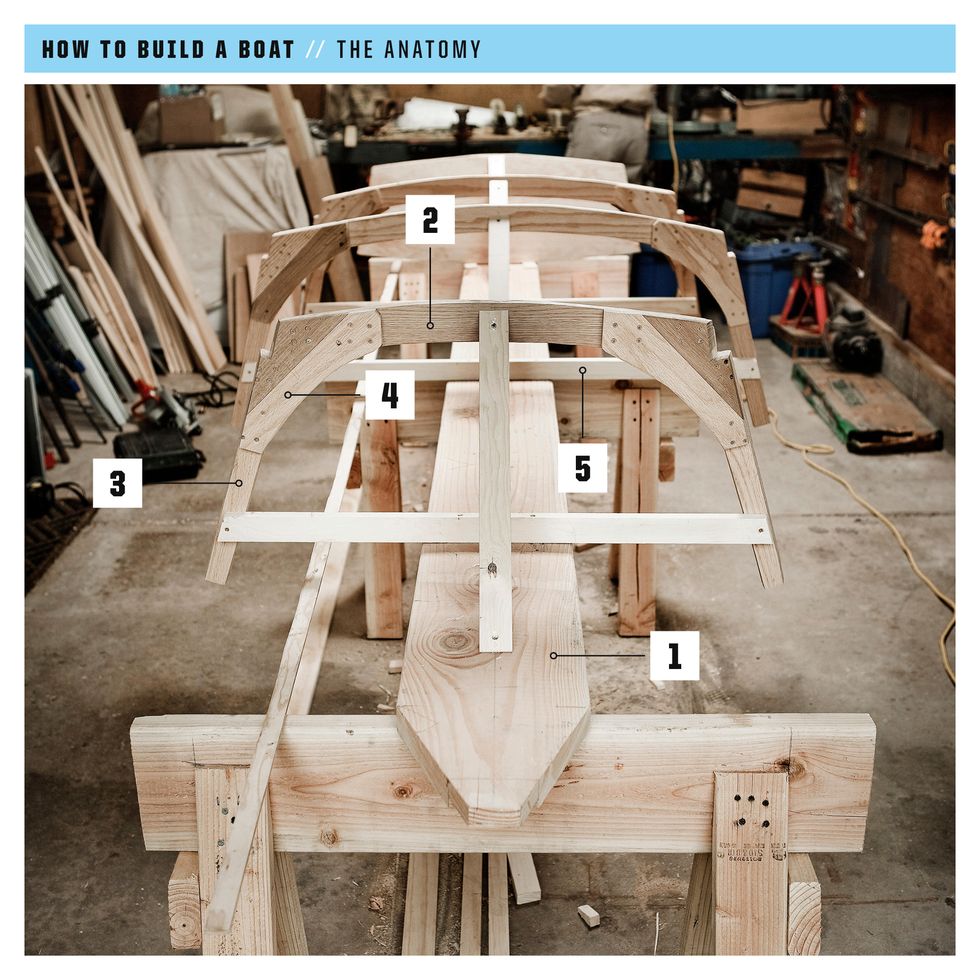
Working the Plank
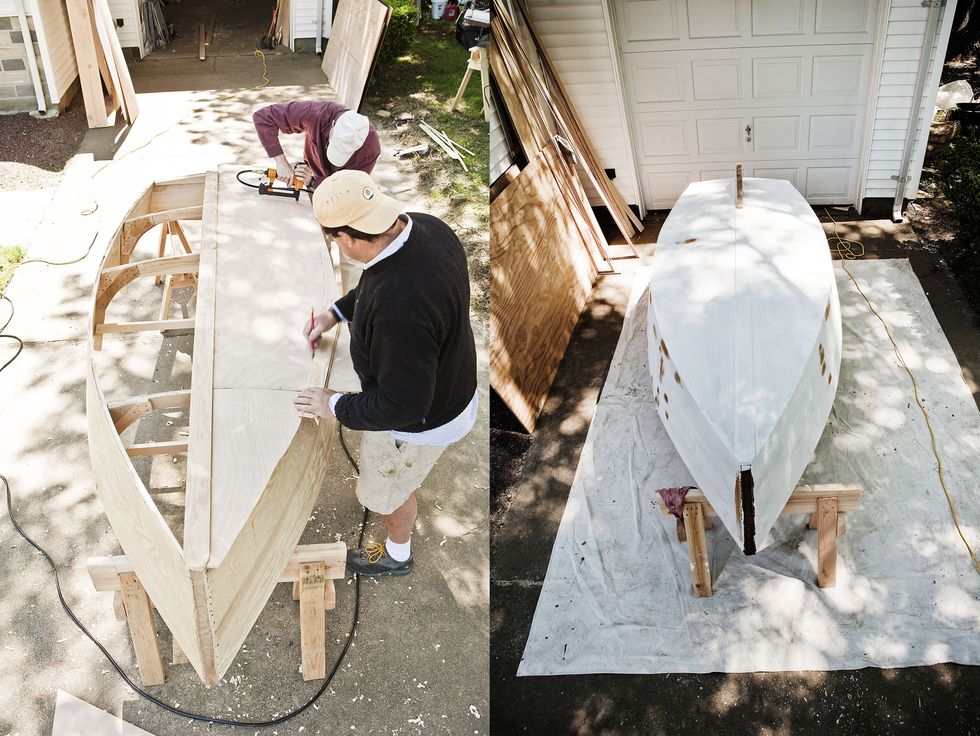
I don't know how Uncle Paul felt about it, but boatbuilding can be acutely frustrating. The bane of my weekends proved to be a small bronze screw. A No. 6 Frearson flat-head, to be exact. Like most modern DIYers, I'd been spoiled by drywall screws and other aggressive fasteners that practically plow into the lumber. Even using a specialized, tapered drill bit and a waxlike lubricant with the unlikely name of Akempucky, I managed to wreck screws by the dozen. The head on one would strip a moment before the screw was fully seated, while another would shear off on the last eighth of a turn, leaving me with a shiny Frearson-head penny.
Timo had tried to downplay the arcana I'd face--"It's more like house carpentry than fine-furniture building," he had said--but I still found myself floundering on occasion. One challenge was that the 1937 article was more an overview than a detailed set of plans. And, though it pains me to find fault with my forebears at Popular Mechanics, the sketch contained suspicious discrepancies. Timo helped me recalibrate some of the dimensions midway through the project—and I had to trim several pieces after they were assembled.
The biggest hurdle came when it was time to plank the hull. The classic way is to bend strips of solid wood to the frames. I'd chosen marine-grade fir plywood instead to save time, but now I was barely able to force the hull's 14-inch sheets into place. There was no way the half-inch plywood I'd planned for the bottom was going to work.
Timo advised me to switch to a special, wafer-thin marine-grade plywood and plank the bottom in two layers. He came swooping in one Thursday morning to show me the technique. He stepped out of his truck with a broad smile, and a block plane in each hand, and my mood lifted. He politely took a sighting down the chine logs where we'd attach the bottom, and spent a few minutes planing them to the last measure of precision. Then we got to work with staples, glue and screws--and in a couple of hours the project went from a plywood flower bed to a small craft with sensuous compound curves.
It was satisfying, but my mistakes still showed in details like the placement of screws and the shape of the stem. "You know what they say," Timo told me. "Putty and paint makes a boat what it ain't." I got out my paintbrushes.
Maiden Voyage

We launched the boat at Tuckerton Seaport on a cool, overcast day that felt more like September than June. Down at the dock, Timo produced a can of Amstel Light in lieu of champagne. "Go ahead," he said, "pour it over the bow." I popped it open and emptied the beer over the paint. "I christen thee Sea Scout," I said. Then we slid the little craft off the dock and into the water.
You might think a feeling of triumph came over me. Not so. The Sea Scout looked very small, almost helpless, as she sat bobbing at the end of the painter, the little rope that Timo had threaded across the bow. I felt humbled. A phrase from the Book of Psalms flashed in my mind: "They that go down to the sea in ships, that do business on great waters."
I wasn't aiming for any great waters myself. I eased off the dock and into the boat. Timo handed me the oars. Awkwardly, I drew the handles back, just above my hips. The craft slid forward gracefully, almost like she was on ice. As Timo watched, I braced the left oar down in the water and swept the surface with the right. The Sea Scout pivoted neatly, unexpectedly elegant and spry.
If the oars were a kick, you can imagine the thrill I felt when I mounted the 2.5-hp Mercury Marine outboard on the transom. It's a clean-running four-stroke engine, compact yet almost zippy on a boat this small. I gave the engine full throttle and cut some nice straight lines and a pleasingly tight curve complete with a crisp little wake.
With the afternoon gone, my first voyage was complete. In the end, I decided to donate the boat and engine to Tuckerton Seaport. Frankly, I needed the space in my garage and driveway: The Sea Scout was a good first foray into wooden boatbuilding, but I knew I could do better—and I'm already sifting through plans.
The Sea Scout, a Decade Later
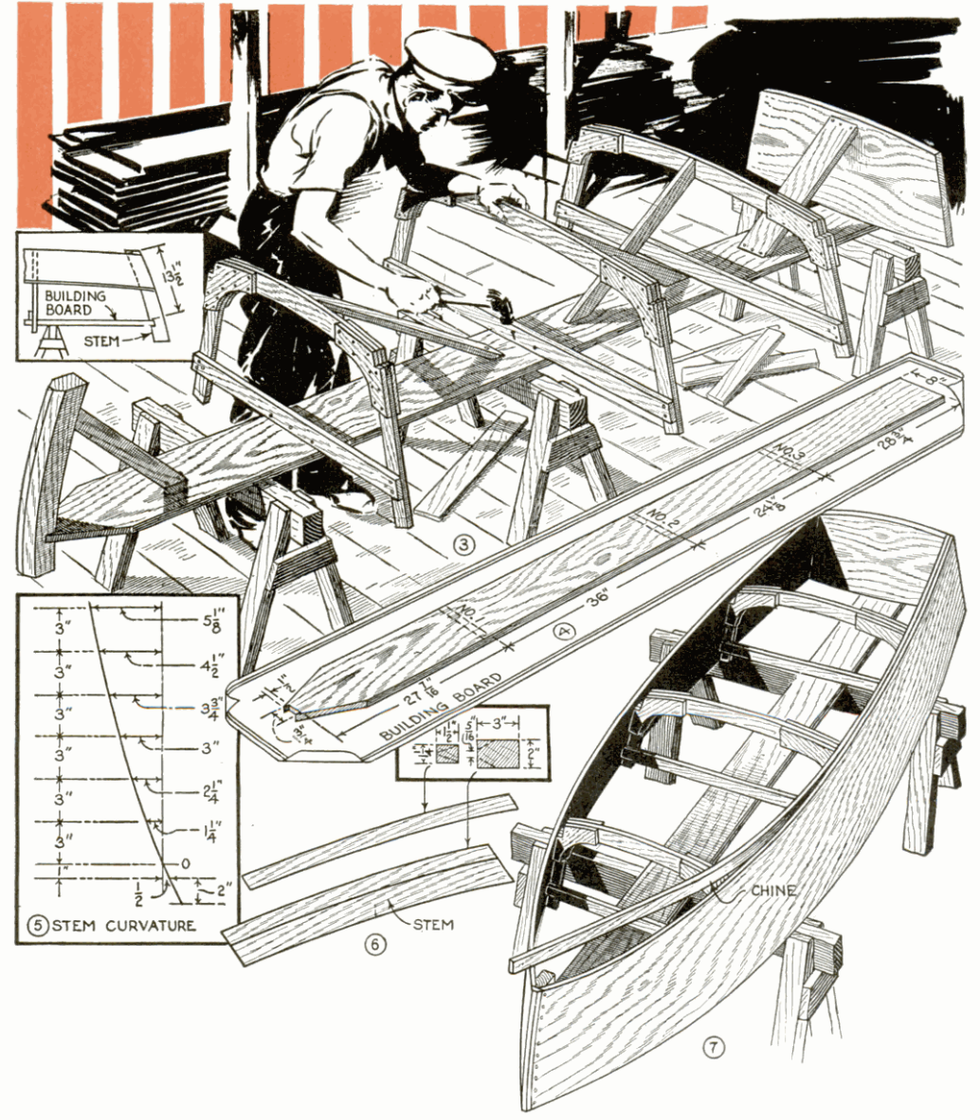
Ask anybody who’s ever built a boat, and they’ll tell you one thing about it: you’re not the same after you’ve built one. And that goes for me, too. The little boat, which I built back in 2009, shaped me as much—or perhaps more—than I shaped it.
The Sea Scout project brought a flood of mail from our readers, some of whom had built the boat or knew someone who did. One woman still had the boat that her father built. She sent a picture of it and recalled the many pleasant hours she spent with her dad as her father taught her how to sail in it. She kindly offered to donate the boat to us, thinking that perhaps we could put it in our lobby. I wish I could have taken her up on the offer.
When you build a boat, you take your place in the long line of craftspeople—professional and amateurs alike—who have plied that trade and learned about the unique burden of building a craft upon whom someone’s safety and enjoyment will depend. Building a boat is humbling, you remember every mistake you made building the thing as it bobs up and down, and waves wash over its bow or crash into it from the side.
You feel it shudder, but it doesn’t give way as you look over the side at the murky depths. And afterward, you look at every boat with a more knowing eye, a greater respect...and you wonder if you could build it.

Roy Berendsohn has worked for more than 25 years at Popular Mechanics, where he has written on carpentry, masonry, painting, plumbing, electrical, woodworking, blacksmithing, welding, lawn care, chainsaw use, and outdoor power equipment. When he’s not working on his own house, he volunteers with Sovereign Grace Church doing home repair for families in rural, suburban and urban locations throughout central and southern New Jersey.

.css-cuqpxl:before{padding-right:0.3125rem;content:'//';display:inline;} Pop Mech Pro .css-xtujxj:before{padding-left:0.3125rem;content:'//';display:inline;}

Army Sending Hypersonic Missiles to Face Russia

Warp Drives Are Possible—Aliens May Be Using Them

Teddy Roosevelt's Stolen Watch Recovered by FBI

Will NGAD Ever Actually Fly?

Humans Could Acquire a New Form of Consciousness

Q-Ships, the Weirdest Warships Ever, Are Back

Archaeologists Dig Up 1,500-Year-Old Reliquary

He Was Frozen in a Shed for 30 Years. Can He Rise?

What Doomed JFK Jr.'s Final Flight?

Why Everything We Know About Gravity May Be Wrong

The Navy is Fixing its Ship-Naming Mess

- Basic Kayaking Knowledge , Learn
15 Free Boat Plans You Can Build This Week (with PDFs)
Boatbuilding is one of the most ancient forms of craftsmanship still alive today. As long as our ancestors have had a curiosity about exploring open waters, they have been practicing and honing their boatbuilding skills.
To be honest, however, building a boat is no small task. It will require a lot of work and patience to ultimately create a finished product that you are happy with and that is actually seaworthy.
Of course, we have also included a few free boat plans. You can keep in your back pocket for the next time you are asked to build a cardboard boat as part of a contest or lakefront teambuilding adventure.
We hope that these resources help you in your journey to build your own boat!
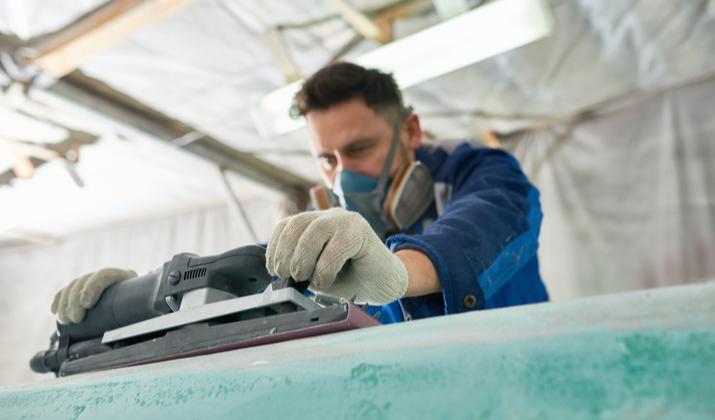
Photo by SeventyFour via Shutterstock
Free Boat Plans
- The Wanigan
- The Slipper
The Handy Andy
- The Jolly Roger
- The Hobby Kat
The White Duck
- The Sea Midge
The Crazy Cardboard Boat
Why Build Your Own Boat?
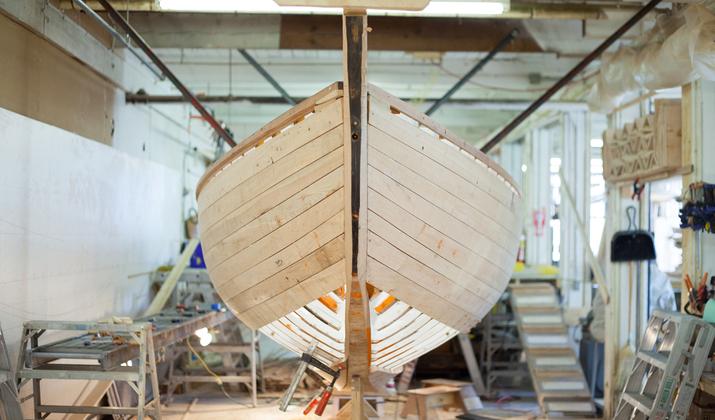
Photo by Halsey via Shutterstock
There are a lot of reasons why you should explore building your own boat versus buying a pre-made model. Here is a quick breakdown of the most obvious benefits:
- You will know the ins and outs of your finished boat better than anyone
- It can be a great project to work on with your teenage or even adult children
- You will gain valuable skills molding and shaping wood and other materials
- You can design your boat for your specific needs
- You don’t have to trust the sometimes-questionable manufacturing of mass-produced boats
- You can create a boat that functions as your second home on the water
- You can save money if you source materials mindfully
Of course, most first-time boatbuilders still experience some level of trial-and-error. With patience and perseverance, however, you can craft a one-of-a-kind vessel that has no equal anywhere in the world.
Free Boat Plans You Can Build This Week (with PDFs)
1. the wanigan.
PC Duckworks Boat Builders Supply
The Wanigan boat began as a garvey design, which is one of the older boat plans known to the Americas. Traditionally, these boats were built as work scows and were very popular among American summer camps.
The design itself is very simple, but these boats can carry heavy loads. It can also handle a trolling motor being mounted to the stern so you can cover more ground if you want to use it as a fishing boat.
The creator of this boat plan became aware of some of the downsides of the garvey design, such as the heavier weight that made it less efficient than some other designs. So he combined elements of dory and wanigan designs to create a hybrid.
The main changes include an enlarged beam, tilted lathes to provide a stiffer hull, and knocking off the top strakes to reduce the boat’s overall weight.
The Wanigan text
These additional The Wanigan drawings  may also prove useful for your build process!
2. The Mouse
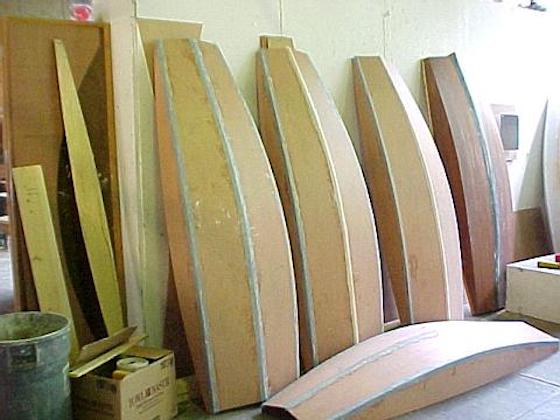
The Mouse is one of the most compact and nimble boat plans we have found for this list. It is an easy build and also a great boat for two kids or a single teenage paddler.
The original builder began with a one-sheet boat design in an effort to create the lightest and most affordable boat possible. This means it is only suited for calm waters and should not be used in high winds or wavy conditions.
That said, it was built in roughly 12 to 24 hours of work time and doesn’t require a full workshop to construct. The main material that is required for building this boat is quarter-inch plywood. But the builder recommends using one-inch by half-inch pine or something a little sturdier.
The plywood and pine components are held together using a method called ”˜stitch and glue’. This method requires choosing one of the best glues for kayak outfitting , which are typically made of epoxy and glass tape rather than something cheaper like polyurethane.
The Mouse Instructions
Also, here are a few extra useful The Mouse Notes for builders
3. The Slipper
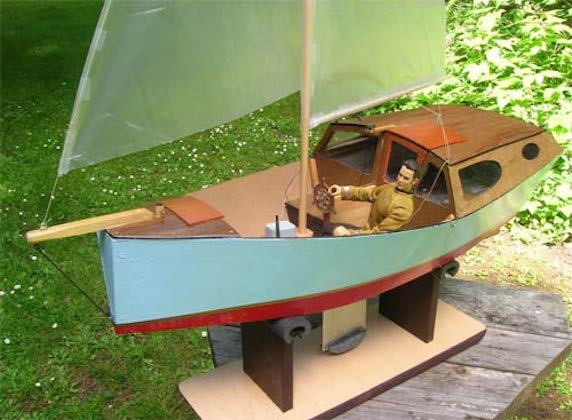
The Slipper is the first of many sailboat plans on our list and it is faster, easier, and cheaper to build than most. It also features a deeper cockpit than many other sailboat designs, which makes it safer for intermediate sailors.
This sailboat plan features dual steering stations so that you can sail from inside or outside of the helm. It also includes a centerboard trunk that hardly intrudes into the cabin at all. So that, it is easier to work around while you are in the cockpit.
The exterior hull and cabin of this sailboat feature a modified dory design using two sheets of plywood ripped to three feet wide before being joined together. The resulting hull is a modified V-shape that reduces drag.
The centerboard of this boat can also be winched up to the level of the top of the cabin or lowered down to alter the draft. This allows you to customize the boat design for a stiffer and more weather-worthy vessel if you need it.
The Slipper was also intentionally designed with an aft cabin that naturally helps to keep the bow pointed into the wind whether you are underway or the boat is anchored in the port.
The Building Slipper
4. The Handy Andy

PC DIY Wood Boat
The Handy Andy is a great little 10-foot portable rowboat for hunting, camping, fishing, and other recreational uses. It is actually the only folding boat design on our list, which makes it best for folks that need the most portable boat plan possible.
This boat features a 42-inch beam and a depth of about 15 inches at the mid-section. It also weighs roughly 80 pounds when assembled and can handle up to three average-sized human passengers.
The design boasts a flat bottom with canvas-bound edges and the primary material used for construction is ⅜-inch marine-grade plywood. Despite its lightweight nature, this rowboat can handle trolling motors or even outboard motors with a maximum of five horsepower.
Once finished, the hull can be folded or unfolded in less than a minute’s time.
This design makes it one of the only boats on this list that can be stored in a truck bed or easily carried by two people to be launched at more remote locations.
5. The Junior

If you are looking for an all-purpose dinghy that can handle almost any use you might imagine, look no further than The Junior free boat plan. It can carry three or four average-sized adults and is much easier to row than a traditional dinghy.
It is also durable enough to be equipped with a small outboard motor. You could even set it up with sailing equipment if you want to use it as a sailing vessel. As we said, this is truly an all-around boat design!
This boat plan requires constructing three frames that will provide the majority of the load-bearing support. The builder recommends using ¾-inch framing with ⅜-inch plywood as the exterior material for this boat build.
Resin glue and flathead screws are also required to hold this boat together. But there is a full list of materials included in the plans we have linked to below. Sticking to that plan should also give you enough leftover materials to construct two six-foot oars for rowing this boat until you install a trolling motor or outboard motor down the line!
6. The Jolly Roger

Channel your inner Captain Morgan when you are following these plans to build your very own Jolly Roger boat. This flat bottom boat design is designed for pond fishing . It can also be a useful yacht dinghy for getting from your dock to a larger vessel anchored offshore.
The plan follows conventional dinghy construction methods but also includes a few modifications that will save you time and energy. The wide design is super stable for boaters of all ages.
The keel, frame, chines, and risers are all cut from ¾-inch oak, ash, or any other trusted hardwood you can get your hands on. For the smaller components, the builder recommends using cedar, cypress, fir, or white or yellow pine.
Because this boat plan is also sturdy enough to handle a small motor, it includes important points for protecting the wooden hull from spark plug damage.
Be careful to follow these guidelines to build the safest boat possible if you imagine installing a motor down the line.
The Jollyroger
7. The Cork

The Cork is another simple rowboat design. This one trends away from the flat bottom plans that we have included thus far. Instead, it features a deeper, V-shaped hull that makes it better suited to more efficient rowing and easier maneuverability.
It can be rowed easily from either seating position and is durable enough to handle up to three average-sized adult passengers. The ends of the boat are identical, which allows for multi-directional rowing.
The list of materials required for this boat plan should cost you between $30 and $50, depending on your location and hardware costs there. The resulting build is lightweight enough for two people to be carried and also to be transported on top of a vehicle .
Inside the boat, the builders use aluminum tubing to secure the struts that hold the seats. This material choice keeps the overall weight of the boat down while still adding the necessary rigidity across the beam of the boat.
8. The Hobby Kat

The Hobie Cat is one of the most iconic and recognizable small sailing vessels ever made. This Hobby Kat plan is your answer to building your own iconic sailboat without spending thousands of dollars.
Your finished boat will be able to handle speeds of up to 20 miles per hour. It will be a super fun vessel for windy days on the lake or bay. The builder was able to construct the hulls, decking, and rudder for this boat while spending little more than $200.
From there, they purchased and installed the mast, boom, sail, and rigging, which brought the total amount spent to roughly $650 (still much less than a name-brand Hobie!). Without the mast and sail, this boat weighs roughly 165 pounds and is constructed using primarily 3/16-inch marine plywood.
You can also elect to build your own mast, boom, and sail if you have the time and skills to do so.
Those elements are not included in this boat plan, but they do offer some recommendations for where to buy these components!
The HobbyKat
9. The Tern

Named after the common seabird found around the world, the Tern is a lightweight and nimble sailboat with a 72 square foot base design. She is made for inland sailing and planes very well in moderate breezes.
The hull design also provides minimal water resistance and the small floor plan makes this boat easier for intermediate sailors to handle. Even though it offers a small footprint, this boat is sturdy enough to handle up to four adult passengers.
One of the best things about this boat plan is that it can be built almost entirely by using only common hand tools.
Of course, you can speed things up if you have power tools and you are skilled enough to use them correctly.
The Tern boat plan includes a 20-foot mast, but you can shorten that length if you desire. The plan includes a complete list of materials and step-by-step instructions on how to plane and assemble each element.
10. The Falcon

As you might expect from its name alone, the Falcon is an incredibly speedy sailboat for its size. It boasts a 14-foot centerboard and can handle two to four passengers, depending on its size and weight.
In tests of the original build, the creators claim that this boat out-distanced many Snipe and Comet sailing vessels as well as pacing evenly alongside longer 18-foot sailboats. When finished, your boat will have a six-foot beam and a total weight of roughly 475 pounds.
For the main framing components, they recommend using white oak and plywood will be the main material used in the hull construction. The hull features a V-shaped that was inspired by larger schooners.
The Falcon is best suited to sailing on bays, lakes, and wide rivers. It is also a boat plan with just under 120 square feet of deck space and it is a great build for amateur craftsmen and sailors.
11. The White Duck

The White Duck is a flat-bottomed rowboat with a total length of 13’6” and a four-foot beam. The cockpit is approximately 15 inches deep all the way around and this boat can handle up to five passengers while maintaining buoyancy and stability.
When fully constructed, it will weigh roughly 200 pounds, but the final weight will depend on the type of lumber you choose for your build. This boat plan features plywood planking over solid wooden frames.
The White Duck is built with a pointed bow that cuts nicely through the water. The flat stern of this boat design will make it easy to attach a small outboard motor with a maximum of six horsepower.
As you might expect from its name, this rowboat is a great option for duck hunting trips. That being said, it is a highly versatile craft that can also be used for pond fishing or casual rowing on your nearby lake.
12. The Sea Midge

The Sea Midge is one of the smallest rowboats on our list and it is ideally suited for one average-sized rower or two small paddlers. It is only about 8 feet in length and offers a 52-inch beam at its widest point.
The Midge’s small dimensions make her ideal for navigating narrower creeks and streams. With an approximate weight of 62 pounds, she is easy to maneuver on the water and can also be much more easily transported than some of the larger boat plans on our list
The Seamidge
13. The Zephyr

The Zephyr is a compact and speedy dinghy sailboat that measures roughly 14 feet long and approximately five feet across. This boat style was originally developed for safely crossing the English Channel. This means it can stand up well in rough waters.
When finished, it is also light enough to be transported on a small trailer or on top of a larger vehicle.
The boat plan calls for using hemlock or fir for the framing and oak or Douglas fir for the keel and chines.
14. The Gypsy

The Gypsy is a small cruising sailboat that is meant to be equipped with an outboard motor for powered locomotion. The original design resulted in an incredibly seaworthy vessel that logged more than 6,000 nautical miles in her lifetime.
It includes a comfortable cabin that makes it well-suited for multi-day sailing adventures. This boat plan includes improvements on the original design that will help you build an extremely durable and long-lasting sailboat.
The Gypsy boat design will help you construct a vessel that can handle a motor up to 25 horsepower so that you can enjoy cruising speeds of up to nine miles per hour.
While it may require a bit more of an investment in time and money, it will also help you produce one of the best boats you can build with a free boat plan!
15. The Crazy Cardboard Boat

PC Saint Dominic Catholic School
Finally, let’s talk about a crazy cardboard boat plan that you can build in less than a day. This is a great boat plan to bookmark for your next teambuilding project so that you can earn bragging rights with your coworkers.
The plan calls for using 1.5 sheets of cardboard. But you can use the remaining half sheet to build your own boat paddle if you want to get creative.
Triple-thick cardboard is best for this boat plan. But you can always double up thinner sheets if that is all you can find.
These plans include an easy-to-follow diagram for marking, cutting, and folding the cardboard sheets to create the hull of your boat. From there, it calls for using contact cement and construction adhesive to seal the edges and corners.
If you are looking to save a little money on this build you could also use duct tape and then wrap the entire design in plastic sheeting to provide waterproof qualities.
Overall, this build is one of the cheapest and easiest on our list. It is also a great project for hot summer camp days on the lake or river!
15 Free Boat Plans You Can Build This Week (with PDFs) – Final Thoughts
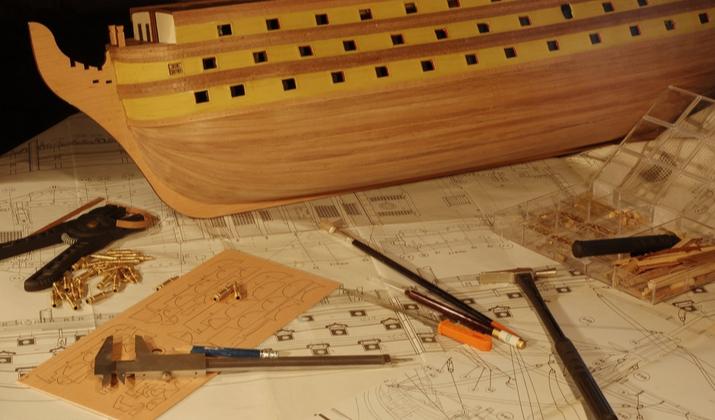
Photo by Alexandra Soloviova via Shutterstock
We hope that you now have a couple of free boat plans to inspire you to begin your own construction project.
Don’t hesitate to check out YouTube for some useful boat-building videos when you are getting into the nitty-gritty of these build processes!
Enjoyed 15 Free Boat Plans You Can Build This Week (with PDFs)? Share it with your friends so they too can follow the Kayakhelp journey.
Share on pinterest.
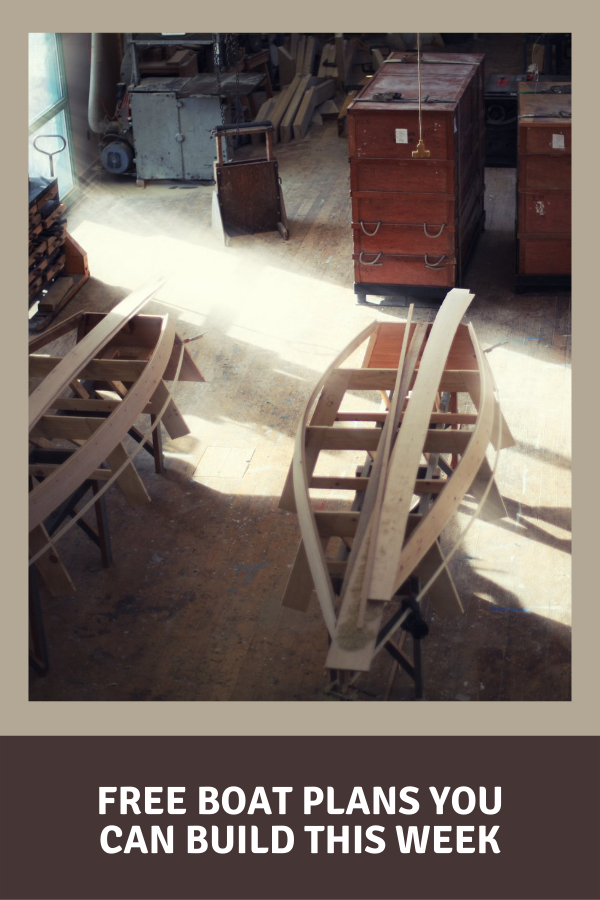
Peter Salisbury
Pete is the Owner of KayakHelp.com. Born and raised in Cleveland, Ohio, he grew up kayaking, fishing, sailing, and partaking in outdoor adventures around the Great Lakes. When he’s not out on the water, you can find him skiing in the mountains, reading his favorite books, and spending time with his family.

WOODEN BOW TIES
How to build a wooden sailboat: a beginner's guide.
Are you interested in building your own sailboat? If so, building a wooden sailboat can be a rewarding and fulfilling experience. Not only will you have a unique vessel to call your own, but you’ll also learn valuable woodworking skills along the way.
To get started, you’ll need to gather the necessary materials and tools. This may include oak plywood, epoxy resin and hardener, thickener, brad nails, masking tape, a pull-saw, and a table saw. Once you have everything you need, you can begin the process of building your sailboat. From creating a jig and frame assembly to making the mast, there are many steps involved in building a wooden sailboat. But with patience and attention to detail, you can create a beautiful and functional vessel that will bring you joy for years to come.
Understanding the Basics of a Wooden Sailboat
If you are interested in building a wooden sailboat, it’s important to understand the basics of how a sailboat is constructed. In this section, we’ll cover the parts of a wooden sailboat and the different types of wooden sailboats.
Parts of a Wooden Sailboat
A wooden sailboat is made up of several parts, each with its own unique function. Here are some of the most important parts:
- Hull : The hull is the main body of the boat. It is the part of the boat that sits in the water and provides buoyancy.
- Keel : The keel is a long, narrow fin that extends down from the bottom of the hull. It helps to keep the boat from capsizing by providing stability.
- Rudder : The rudder is a flat piece of wood or metal that is attached to the back of the boat. It helps to steer the boat.
- Mast : The mast is a tall, vertical pole that supports the sails.
- Sails : The sails are large pieces of fabric that are attached to the mast and other parts of the boat. They catch the wind and propel the boat forward.
- Boom : The boom is a horizontal pole that is attached to the bottom of the mast. It helps to control the shape of the sail.
Types of Wooden Sailboats
There are many different types of wooden sailboats, each with its own unique characteristics. Here are some of the most common types:
- Dinghy : A dinghy is a small sailboat that is typically used for recreational sailing or racing.
- Sloop : A sloop is a sailboat with a single mast and a fore-and-aft rig.
- Ketch : A ketch is a sailboat with two masts, with the main mast taller than the mizzen mast.
- Yawl : A yawl is a sailboat with two masts, with the mizzen mast located aft of the rudder post.
When choosing a type of wooden sailboat to build, it’s important to consider your needs and experience level. A dinghy is a good choice for beginners, while a ketch or yawl may be more suitable for experienced sailors.
By understanding the basics of a wooden sailboat and the different types available, you can make an informed decision about which type of boat to build.
Choosing the Right Materials
When building a wooden sailboat, choosing the right materials is crucial to ensure the boat’s durability and performance. In this section, we will discuss the two most important materials you’ll need to choose: wood and sails/rigging materials.
Selecting the Right Wood
Choosing the right type of wood for your sailboat is critical. You want a wood that is strong, lightweight, and resistant to rot and decay. Some of the most popular types of wood used in sailboat building include:
- Cedar: Lightweight and easy to work with, cedar is an excellent choice for planking and decking.
- Mahogany: Strong and durable, mahogany is often used for building frames and keels.
- Oak: A dense and hard wood, oak is commonly used for building frames and planking.
When selecting your wood, make sure it is free of knots, cracks, and other defects that could weaken the boat’s structure. You should also consider the wood’s grain pattern, as this can affect the boat’s strength and appearance.
Choosing Sails and Rigging Materials
The type of sails and rigging materials you choose will depend on the type of sailboat you’re building and your sailing needs. Some of the most common materials used in sail and rigging construction include:
- Dacron: A strong and durable synthetic material, dacron is commonly used for sailcloth.
- Nylon: Lightweight and flexible, nylon is often used for spinnaker sails.
- Stainless Steel: Strong and corrosion-resistant, stainless steel is commonly used for rigging hardware.
When selecting your sails and rigging materials, consider the conditions you’ll be sailing in and the type of sailing you’ll be doing. For example, if you’ll be racing, you may want to choose lightweight sails and rigging materials that will help you achieve maximum speed. On the other hand, if you’ll be cruising, you may want to choose more durable materials that can withstand rougher conditions.
By choosing the right materials for your wooden sailboat, you can ensure that your boat is strong, durable, and performs well on the water.
Designing Your Sailboat
Before you start building your wooden sailboat, you need to design it. This will involve creating a blueprint and determining the size and shape of your boat.
Creating a Blueprint
Creating a blueprint is an essential step in designing your sailboat. It will help you visualize your boat and ensure that you have all the necessary components in place. You can create a blueprint using software such as AutoCAD or SketchUp, or you can draw it by hand.
When creating your blueprint, consider the following:
- The length, width, and height of your boat
- The position of the mast and sails
- The location of the rudder and keel
- The number of cabins and their layout
- The placement of any storage compartments or equipment
Determining the Size and Shape
The size and shape of your sailboat will depend on several factors, including your budget, the type of sailing you plan to do, and the number of people who will be on board.
Consider the following when determining the size and shape of your sailboat:
- The type of sailing you plan to do (coastal cruising, racing, etc.)
- The number of people who will be on board
- The amount of storage space you will need
- The amount of deck space you will need
- Your budget
Once you have determined the size and shape of your sailboat, you can start gathering materials and building your boat.
Building the Hull
When building a wooden sailboat, the hull is the most important part of the boat. It is the main structure that holds everything together and keeps the boat afloat. Building the hull requires cutting and assembling the wooden frame.
Cutting the Wood
To begin building the hull, you will need to cut the wood into the appropriate sizes and shapes. The wood should be cut according to the plans or blueprints that you have created. You can use a saw or a jigsaw to make the cuts.
It is important to use high-quality wood that is free of knots or other defects. The wood should be strong enough to withstand the pressure and weight of the water. Common types of wood used for building a wooden sailboat include cedar, oak, and mahogany.
Assembling the Frame
Once you have cut the wood, you can begin assembling the frame of the hull. The frame is made up of vertical pieces of wood called frames, which hold the shape of the boat. The frames are attached to the keel, which is the main structure that runs down the center of the boat.
To assemble the frame, you will need to use a sawhorse or other support to hold the lumber in place. You can then use screws or bolts to attach the frames to the keel. It is important to ensure that the frames are level and straight.
After the frames are attached to the keel, you can add the planks to the hull. The planks are attached to the frames and keel using screws or nails. It is important to ensure that the planks are properly aligned and spaced.
Once the planks are attached, you can sand and finish the hull to give it a smooth and polished look. This will also help to protect the wood from the elements.
Building the hull of a wooden sailboat requires patience and attention to detail. With the right tools and materials, you can create a strong and beautiful hull that will last for years to come.
Installing the Deck and Cabin
Installing the deck and cabin of your wooden sailboat is a crucial step in the construction process. It not only adds to the aesthetics of your boat but also provides structural support. Here are some tips to help you through the process.
Deck Installation
The deck of your wooden sailboat should be installed after the hull has been completed and before the cabin is built. It is important to ensure that the deck is watertight to prevent any leaks. Here are the steps to follow when installing the deck:
- Cut the deck to fit the hull and sand the edges to ensure a tight fit.
- Apply a layer of epoxy to the hull and deck joint to seal it.
- Secure the deck to the hull using screws or bolts.
- Apply a layer of fiberglass cloth and epoxy to the deck to make it watertight.
- Sand the surface of the deck to prepare it for painting or varnishing.
Cabin Installation
The cabin of your wooden sailboat provides shelter and storage space. It is important to ensure that it is properly installed to prevent any leaks. Here are the steps to follow when installing the cabin:
- Build the cabin on a flat surface using marine-grade plywood.
- Cut the cabin to fit the deck and hull and sand the edges to ensure a tight fit.
- Apply a layer of epoxy to the cabin and deck joint to seal it.
- Secure the cabin to the deck using screws or bolts.
- Apply a layer of fiberglass cloth and epoxy to the cabin to make it watertight.
- Install any windows, hatches, or doors in the cabin.
- Sand the surface of the cabin to prepare it for painting or varnishing.
By following these steps, you can ensure that your wooden sailboat’s deck and cabin are properly installed and watertight. This will not only make your boat look great but also ensure that you have a safe and enjoyable sailing experience.
Setting Up the Mast and Sails
Now that you have built your wooden sailboat, it is time to set up the mast and sails. This process may seem daunting, but with a little patience and attention to detail, you can have your boat ready to sail in no time.
Step 1: Install the Mast
The first step is to install the mast. Depending on the design of your boat, the mast may be a single piece or assembled from multiple sections. Make sure the mast is secured properly and is straight. Use a level to ensure the mast is vertical in both directions.
Step 2: Prepare the Sails
Next, prepare the sails. Make sure the sails are clean and free of any debris or damage. Attach the sail to the mast using the halyard, which is a rope used to raise and lower the sail. Make sure the sail is hoisted all the way to the top of the mast.

Step 3: Attach the Boom
Attach the boom to the mast and secure it with a boom vang, which is a rope used to control the angle of the boom. The boom is the horizontal spar that holds the bottom edge of the sail.
Step 4: Set the Sail
Once the boom is attached, set the sail. Adjust the angle of the boom and the sail to catch the wind and start moving. You can use the main sheet to control the angle of the sail and the boat’s speed.
Step 5: Trim the Sail
Finally, trim the sail to optimize its performance. This involves adjusting the sail’s shape and position to maximize its power and minimize drag. Use the sail controls, such as the cunningham and outhaul, to adjust the sail’s shape. Use the main sheet to control the sail’s position relative to the wind.
Congratulations! You have successfully set up the mast and sails of your wooden sailboat. Now it’s time to hit the water and enjoy the thrill of sailing.
Applying Finishing Touches
When it comes to building a wooden sailboat, applying the finishing touches is a crucial step that can make all the difference in the final product. Here are some tips and tricks to help you get the perfect finish.
Sanding and Finishing
Before you can apply any finish, you need to make sure the surface is smooth and free of imperfections. This means sanding the wood with progressively finer grits of sandpaper until you achieve the desired smoothness. Once you’ve finished sanding, you can apply a wood conditioner to help the wood absorb the finish more evenly.
When it comes to choosing a finish, you have several options. Some popular choices include varnish, paint, and oil. Varnish is a popular choice for wooden boats because it provides a durable, glossy finish that can withstand the harsh marine environment. Paint is another option, but it requires more maintenance than varnish and may not provide as much protection against the elements. Oil is a good choice if you want a more natural look, but it may not provide as much protection as varnish or paint.
Painting and Varnishing
If you decide to go with paint or varnish, there are a few things to keep in mind. First, make sure you apply the finish in a well-ventilated area to avoid inhaling fumes. Second, make sure you apply thin, even coats and allow each coat to dry completely before applying the next. This will help prevent drips and ensure a smooth finish.
When it comes to varnishing, it’s important to use a high-quality brush and work quickly to avoid brush marks. You may also want to consider using a foam brush for hard-to-reach areas. Once you’ve applied the final coat of varnish, you can buff the surface with a soft cloth to achieve a high-gloss finish.
Painting requires a different approach. You’ll need to choose the right type of paint for your boat and make sure you apply it evenly. If you’re painting a large area, you may want to consider using a paint sprayer to achieve a smooth, even finish. Once the paint has dried, you can apply a clear coat to protect the paint and give it a glossy finish.
In conclusion, applying the finishing touches to your wooden sailboat is an important step that requires careful attention to detail. By following these tips and using the right tools and materials, you can achieve a beautiful, long-lasting finish that will protect your boat and make it stand out on the water.
Safety Measures
When building a wooden sailboat, safety should always be your top priority. Here are some safety measures you should take to ensure a safe and successful build.
Installing Safety Equipment
Before you start building, make sure you have all the necessary safety equipment installed in your workshop. This includes fire extinguishers, smoke detectors, and first aid kits. You should also have a clear and unobstructed path to the exit in case of an emergency.
When working with power tools, always wear eye and ear protection, as well as a dust mask to protect your lungs. If you are using chemicals, make sure you are working in a well-ventilated area and wear gloves and a respirator if necessary.
Conducting a Safety Check
Before you start working on your sailboat, conduct a safety check to make sure everything is in order. Check that all tools and equipment are in good working order and that there are no loose or damaged parts. Make sure your work area is clean and free of clutter, and that all cords and cables are properly secured.
When working with wood, be aware of any knots or cracks in the wood that could weaken the structure of your sailboat. Use only high-quality marine-grade wood and be sure to follow the plans carefully to ensure a strong and safe boat.
By following these safety measures, you can ensure that your wooden sailboat build is a safe and enjoyable experience.
Maintaining Your Wooden Sailboat
Congratulations on building your own wooden sailboat! Now that you have a beautiful vessel, it’s important to keep it well-maintained to ensure its longevity and safety on the water.
Regular Maintenance
Regular maintenance is essential to keep your wooden sailboat in top condition. Here are some tips to keep in mind:
- Clean your boat regularly with a mild soap and water to prevent dirt and grime buildup.
- Check for any signs of damage, such as cracks, rot, or loose fittings, and address them promptly.
- Apply a fresh coat of varnish or paint every few years to protect the wood from the elements.
- Keep your boat covered when not in use to protect it from the sun and rain.
Seasonal Maintenance
In addition to regular maintenance, there are also some seasonal tasks that you should perform to keep your wooden sailboat in top condition:
- At the beginning of the season, inspect the hull for any damage or wear and make any necessary repairs.
- Check the rigging and sails to make sure they are in good condition and make any necessary repairs or replacements.
- Before storing your boat for the winter, make sure to properly winterize it to protect it from the cold and moisture.
Additional Tips
Here are some additional tips to keep in mind when maintaining your wooden sailboat:
- Use high-quality marine-grade products when cleaning and maintaining your boat.
- Avoid using harsh chemicals or abrasive materials that can damage the wood.
- Regularly check the bilge for any water buildup and pump it out as needed.
- Keep your boat well-ventilated to prevent moisture buildup and mold growth.
By following these tips, you can keep your wooden sailboat in top condition and enjoy many years of safe and fun sailing.
Leave a Reply Cancel reply
You must be logged in to post a comment.

Your shopping cart is empty!

Featured Categories

Sailboat Plans 18-30ft

Sailboat Plans 30-40ft
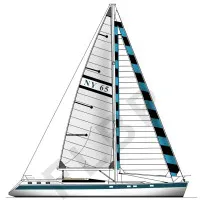
Sailboat Plans 40-65ft

Spray Plans 22-55ft
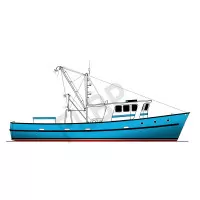
Powerboat Plans 21-65ft

Photo Gallery

Boat Building Information
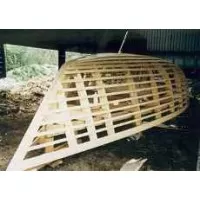
Boat Building Methods
Bruce roberts sailboat and powerboat designs, & boat plans for the diy boat builder, bruce roberts international, the original bruce roberts design office began life in 1968 in, queensland, australia. we are still located in queensland, australia and in 2010 had a name change to fine line boat plans and designs. read more on our history on about us ..
For over forty five years the Bruce Roberts Group, with input from many designers, shipwrights, builders and owners, have been drawing detailed boat plans for sailboats and powerboats with the DIY boat builder specially in mind. These boatplans & designs range in size from 5.8 mts to 20 mts and can be built in many different materials. We have boat plans & designs for building in steel or aluminium in either multichine, radius chine or round bilge hull forms. Most boat plans & designs are also in fibreglass using either c-flex, foam sandwich or single skin hull construction methods or in cold moulded ply or strip plank using what is commonly know as wood epoxy boatbuilding. Thousands of boats marketed as Roberts designs have been built in backyards and successfully sailed around the world.
Our range of boat plans & designs include the:- Roberts, Waverunner, Trader, Spray, Centennial Spray, Coastworker, New York, Adventurer, Tom Thumb, Henry Morgan, Offshore, PCF, Mauritius / Norfolk, Classic, Power Cat, Trawler Yacht and the Longboat.
In our archives are nearly all the boat plans & designs that we have designed over the years. If you are resurrecting an older Roberts boat then it is very likely we will still have the drawings to help.
The emphasis has always been on safety and the fact that when building your own boat you can not only build for less but can build what you want, not what a boat salesman tells you you need . The boat plans come with full size frame patterns and detailed construction drawings as well as information on building one's own tools, fitting self steering vane, mast, trailers (for trailerable boats) etc.
Featured Boat Plans
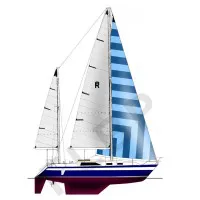
Roberts 370 Boat Plan
Roberts 370 Such has been the response to this design that plans for it's construction are availa..
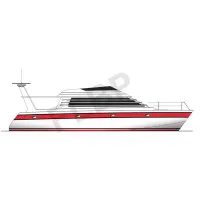
Power Catamaran 46 Boat Plan
Roberts Power Catamaran 46 These catamarans, the Cat 39 and Cat 46, were designed to be built usi..
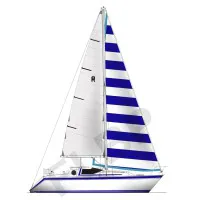
Roberts 310 Boat Plan
Roberts 310 This design may be built with either a regular trunk cabin or a pilot house. It is al..
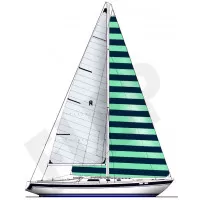
Offshore 38 Boat Plan
Roberts Offshore 38 Full plans for this design are available for building in round bilge Fibergla..
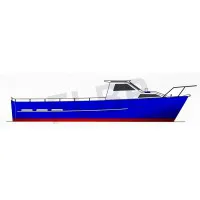
Coastworker 25 Boat Plan
Roberts Coastworker 25 Powerboat Designed for construction in either steel or aluminium, this mak..
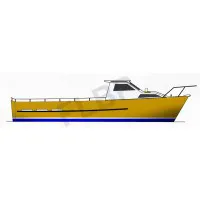
Coastworker 30 MK2 Boat Plan
Roberts Coastworker 30 MK2 Powerboat This design is for steel or aluminium construction. It comes..

New York 46 Boat Plan
Roberts New York 46 The choice of keel types, combined with various draft options and alternate s..
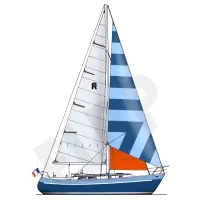
Canoe Stern 341 Boat Plan
Roberts Canoe Stern 341 Designed by Graham Shannon this is for those of you that are looking for ..
- For Sale/Wanted
- Readers Tips
- Your Yarns.
- Restoration
- Miscellaneous
- DIY Boat Yards
- Boat Building
- Cabin Cruisers
Free Boat Plans
- Begin Boating
- Boating Terms
- Ropes and Rigs
- Just for Fun
- Celestial Navigation
- Passage Planning
- VHF Marine Radio
- Boatbuilding Tips
- Stitch and Glue
- Epoxy Resin
A selection of Free Boat Plans that can be viewed and / or downloaded.
These free to download wooden boat plans (pdf) were first published in magazines such as "Popular Mechanics", "Popular Science" and the "Boat Builder's Handbook".
- Rowing Boats
- Sailing Boats

Back Issues for Sale
"Popular Science" magazine and "Popular Mechanics" back issues can be viewed online at Google Books.
All these free boat plans can be built by anyone with a common sense modicum and a few basic woodworking skills and tools. However, if you have not got the skills and tools yet, this is a great way to acquire them.
One of the beauties of building yourself is that you do not have to buy everything at once, just get what you need when you can afford it.
While some of the instructions suggest using exterior plywood, I would always recommend using marine grade.
If you need help with lofting out the plans click here for an article here which should help.
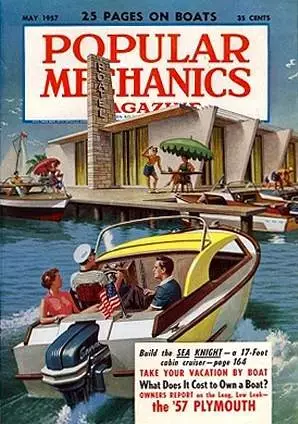
Canoe Free Boat Plans
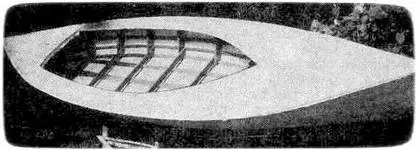
Combining the features of both kayak and canoe, "Blue Bill" is for those out-of-doors-men who hunt or the sportsmen who need an ultra-light-weight portable boat for use upon any waters.
Besides being usable to build a double-end paddling model, a few changes permit the plans to be used for making a canoe that will accommodate outboard motors up to 6 hp. for swift, speedy transportation on any stream or waterway.
Weighing only 75 lbs. complete, "Blue Bill" is easily transported atop an auto anywhere.
Click Here for the Plans
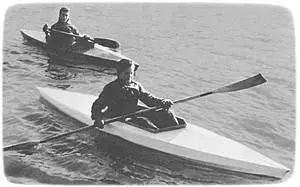
This kayak is the answer for young people who want to build an inexpensive boat for summer fun. A shop full of power tools is not necessary, either. All the work can be done with ordinary hand tools and a few C clamps. This Free Boat Plan will carry one adult but it's handiest when paddled by a youngster. The boat is stable in the water and, even though it can be turned over, it will not sink. It's also light enough to be carried with ease. Building is so simple that the 'Jig' consists of only two blocks and a few bricks.
Hunting Kayak
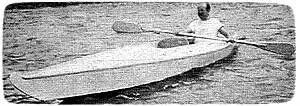
For many years a favorite of hunters, trappers and traders the kayak now is as popular with Europeans as the outboard boat is with Americans.
Although this boat was designed to carry two people, it will accommodate three in a pinch and gear may be stowed under fore and after decks.
A few strokes with the double paddle will send it gliding across the water with the minimum of effort on your part.
Kayaks are surprisingly seaworthy, too — more stable than a canoe, in fact, because the occupants sit on the bottom of the hull which lowers the center of gravity.
Pintail and 10ft Duck Boat
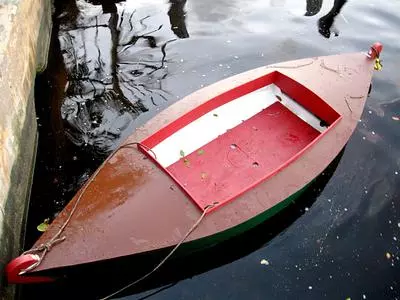
'Pintail' drawn from plans by Wm D Jackson is another of the Free Boat Plans from the 'Boat Builder Handbook'. This one is being built by Greg Allore .
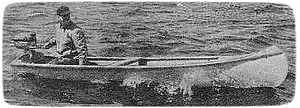
If you have ever struggled with the oars of a heavy, slow-moving rowboat and then paddled a swift, high maneuverable canoe you can appreciate why many true sportsmen prefer canoes.
But, too often, the multi-ribbed conventional canoe is not only hard to build but too thin-skinned for hard usage.
This Free Boat Plan teams up plywood and fiberglass to produce a tough, scrape-proof canoe you can build in one-tenth the time it would take you to turn out a conventional canoe.
The use of only one frame offsets the extra weight of using plywood, so that this canoe is still light enough for comfortable portage.
Little Chief
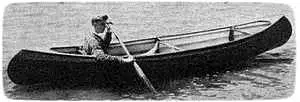
Little Chief is a canoe with many virtues, ideally adapted to quick, easy construction.
Canoes are not easy to build, but here is one Free Boat Plan that can be made of ordinary materials for a fraction of the cost of conventional canoes.
It has attractive molded lines and may be built either as a paddling model or, with slight changes, adapted for use with small outboard motors.
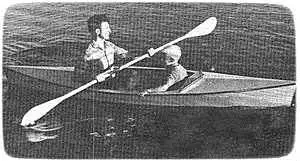
In all countries of the world, particularly the United States, the kayak is enjoying newfound popularity.
Here's a nimble, lightweight craft that has its roots in the Arctic as a basic instrument of survival, yet is branching out as a modern outdoor sport on our own rivers and lakes.
To the Eskimo, a kayak is more than a boat.
When he's laced into his whale-bone and walrus-hide craft, he's ready for anything in the way of water or weather.
To most of us, however, a kayak is pure adventure and fun.
It's perfect for poking around uninhabited Islands, exploring the bends of a lazy, winding river, or just breaking the peaceful surface of a placid lake at sunset.
Redwood Canoe
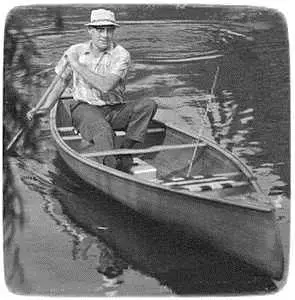
You can build this 74lb, 16 foot canoe using redwood strips, an old boat-building technique.
Two persons can sit side by side in the center with one person at each end and plenty of room for gear.
This canoe is formed around plywood templates using redwood strips glued edge to edge.
You lay up the strips, remove the form, and the canoe is complete, except for fiberglassing and putting in the seats.
The plans can also be used to build a 13-foot version of this strip planked canoe.
or Click Here for the Free Plans
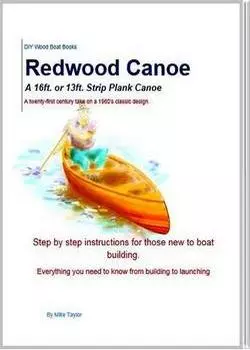
Houseboat Free boat Plans
Budget houseboat (trailerable).
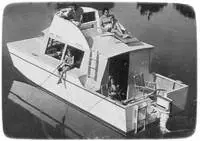
The Budget Houseboat is like a camper that goes on water.
She's 20 ft. long with a 9-ft. beam, containing 300 sq. ft. of usable floor area.
This means that while she can accommodate two in outrageous comfort, she can easily take a family of four on an extended vacation and be entirely self-contained.
There are two full-size permanent bunks in the forward section of the cabin.
The dining table, in the rear section of the cabin, seats four and then drops down to convert into an extra bunk 6 ft. 4 in. long and 38 in. wide.
Cabin headroom is 6 ft. 2 in., and two cots can be stationed to the rear of the cabin area.
Bayou Belle
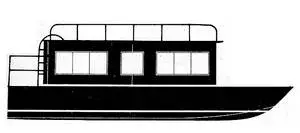
Bayou Belle is a 25' scow that can be built as a sports utility, a fishing boat, or a houseboat, depending on your requirements for pleasure offshore.
As a sports utility, she can be used for towing water skiers and for cruising, as a fishing boat, she offers a stable platform with plenty of elbow room and stowage space.
As a houseboat, she has roomy interior accommodations for a leisurely life afloat.
Construction of Bayou Belle makes use of prefabricated sections, which means that much of the work can be done indoors in the average garage during the cold winter months, and the boat completed outdoors in time for launching in late spring.
Float-A-Home
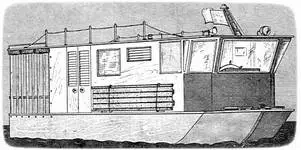
A houseboat is a unique water craft in that it combines most of the comforts of home with the mobility of a boat.
Of course, use is limited to sheltered waters, and speeds are slow in comparison to more sea worthy vessels.
Float-A-Home is a 21-footer that provides plenty of living space for three or four persons.
An extremely simple houseboat to build, the free boat plans feature a strong hull with a heavy keel and close-spaced framing.
This, coupled with a relatively low profile, makes it a very stable craft.
Click Here for the free Plans
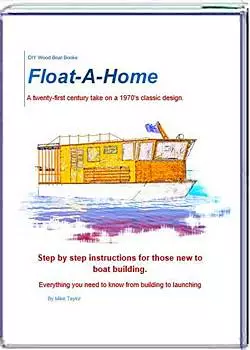
Previous posts
See What Others Have Posted

Recent Articles
Boat Winches
Jun 21, 24 04:18 AM
- Boat Plan Books
- Glass Cloth
- Strip Plank
You might like these

Knotty wood, problems with boat building timber.
Knotty wood, how to avoid structural problems with knots in lumber when using softwood timber for fitting out and boat joinery

Build a Boat, tips for the DIY Wooden Boat Builder.
How to Build a Boat, Wooden Boat Building methods for the DIY, backyard, self-builders explained, carvel, lapstrake and plywood

Wood Screws for Boat Building and Repair.
Wood Screws are the most widely used and versatile fasteners used on wooden boats. Which type to use and how to use them

Wood, Environmentally Friendly Boat Building Lumber.
Make sure that the Wood that you buy and use is sustainably grown and harvested.
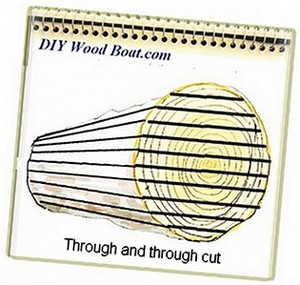
Timber, Lumber for Boat Building.
A brief description of the most common Timber used for building Wooden Boats how to choose wood for your project boat

Timber Properties
A brief guide to timber properties and wood, characteristics such as strength, stiffness and elasticity for choosing lumber for wooden boat building and restoration.
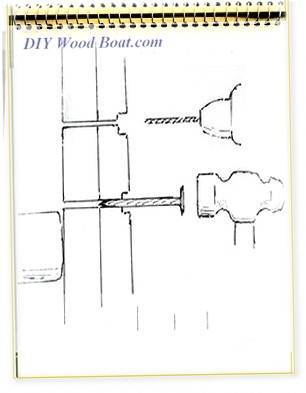
Rivets and Copper Rove Wood Boat Fastenings.
How to use Copper Rivets and Roves construction guide to fasteners on your wooden boat.

Ring Nails for Marine Fastening.
Ring Nails sometimes call Gripfast or ring shank, silicon bronze boat nails are renowned for their holding power. but how to get them out?

Plywood and Veneer Guide for Marine use.
A guide to plywood for boat building and why you should use the best marine grade you can afford.

Glue for Wooden Boat Building
Which Wood Glue to use when building or restoring a wooden boat, resorcinol to epoxy.
Owens Boats
Jun 05, 24 12:14 PM
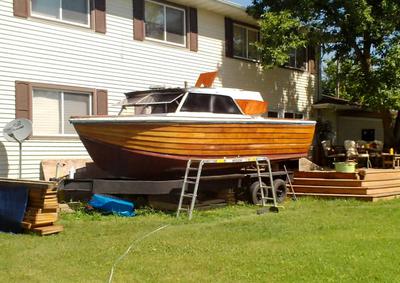
Penn Yan Boats
May 28, 24 07:51 AM
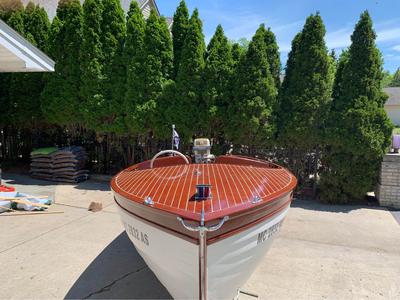
Wooden Boat Restoration, Repair and Maintainence.
Wooden boat restoration, how to fix up an old wooden boat, one of the cheapest ways to get afloat and have a boat to be proud of.

Epoxy Resin for DIY Wooden Boat Building.
A guide to the epoxy resins and sustainable enrtopy resins to use when building wooden boats with marine plywood.

Wood Rot Repair and Treatment
Wood rot in wooden boats, how to treat, repair and replace rotten timbers in a wooden boat

Vintage wood Boat Bottom Replacement
The ultimate bottom repair for a vintage wood boat, when re-caulking the planking on your classic antique boat

Surveying a wood boat
The problem areas to look out for when surveying an old wooden boat.

Initial Boat Survey Checklist
The initial survey questions to ask when looking at a Wooden Boat with a view to restoring or renovating
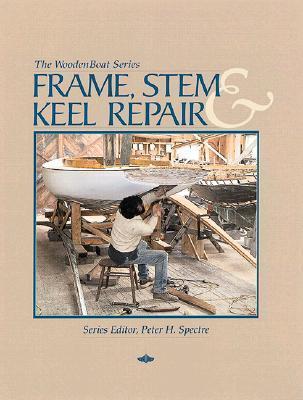
Stem and Stern Post Rebuilding
Repairs to the Stem of a wooden boat can be undertaken by the amateur with a little care and attention.

Planking a Carvel Boat
How to replace damaged or unsound carvel Planking, a guide for any reasonably competent amateur.

Iron Keel Rust Removal
Keel rust, how to remove rust from an iron keel and treat it prior to repainting your wooden boat restoration project.
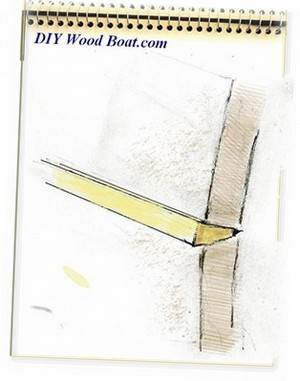
Wedge Seam Construction
Wedge Seam Construction method for wooden boat building and glued wedging or ‘splining’ as a restoration technique for restoring old carvel planking seams.
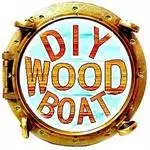
Privacy Policy
Advertising Policy
Cookie Policy

I am perfectly aware that the majority of Wooden Boat aficionados are sensible folk. However, I need to point out that I am an amateur wooden boat enthusiast simply writing in order to try to help other amateur wooden boat enthusiasts. And while I take every care to ensure that the information in DIY Wood Boat.com is correct, anyone acting on the information on this website does so at their own risk.

- $ 0.00 0 items
Build Your Own Boat!
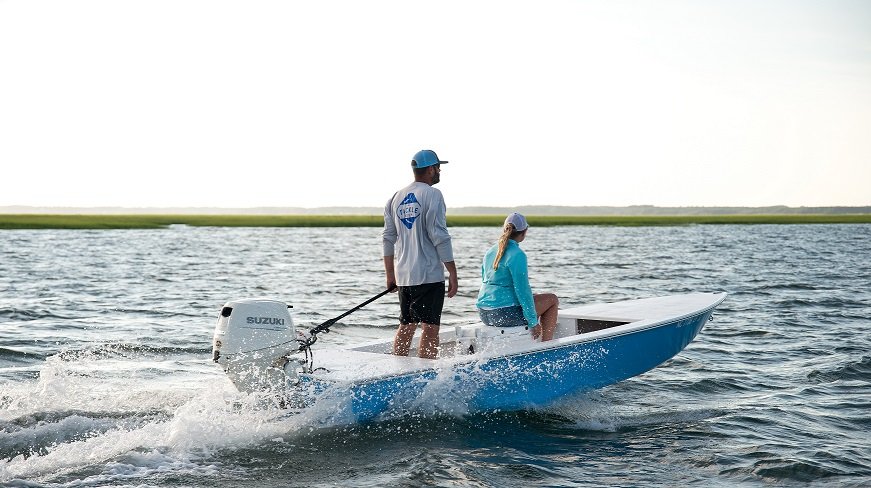
Stitch & Glue Designs

The Flats River Skiff 12 is a light, compact and stable solo skiff to access shallow water.
- 2″ – 4″ draft
- 1 person max
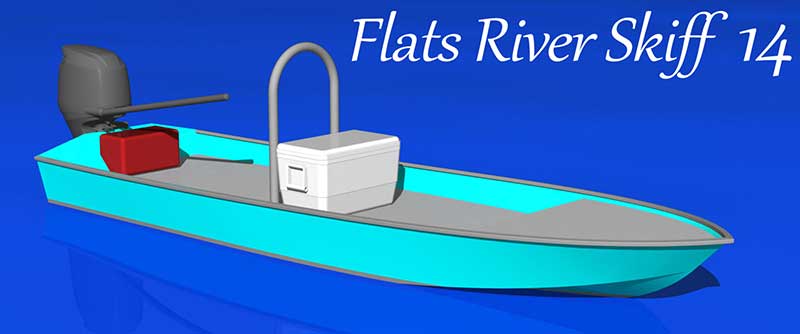
The Flats River Skiff 14 is the big sister to the FRS-12 , a light weight 2 person solo style skiff.
- 4′2″ beam
- 3″ – 6″ draft @ 825 lbs
- 2 people max
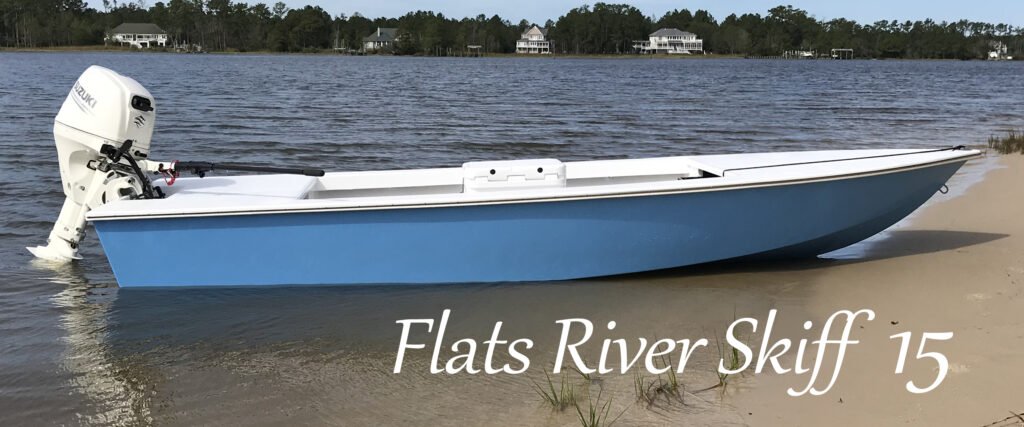
The Flats River Skiff 15 is a flats style 2 person shallow water hunting & fishing boat.
- 15′ LOA
- 5’4″ beam
- 5″ – 7″ draft
- 3 people max
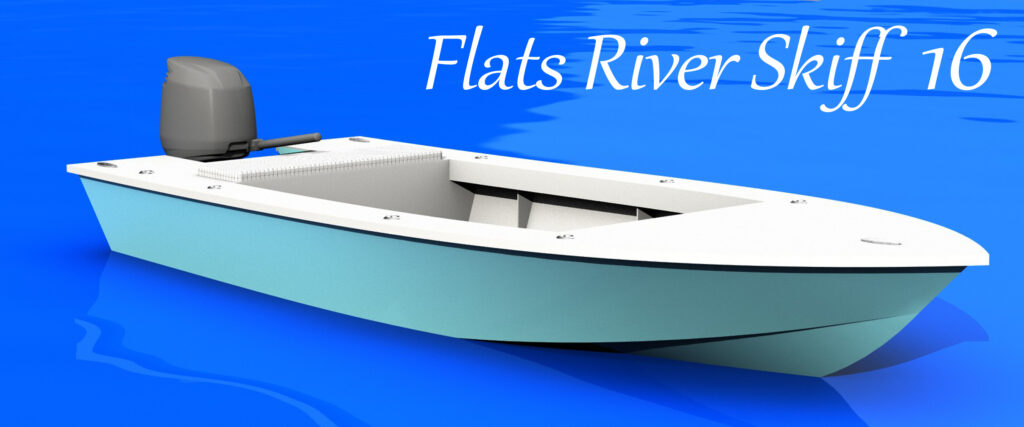
The Flats River Skiff 16 hits the sweet spot for a 3-4 person shallow water fishing boat.
- 16’7″ LOA
- 6’3″ beam
- 8″ – 10″ draft
- 4 people max
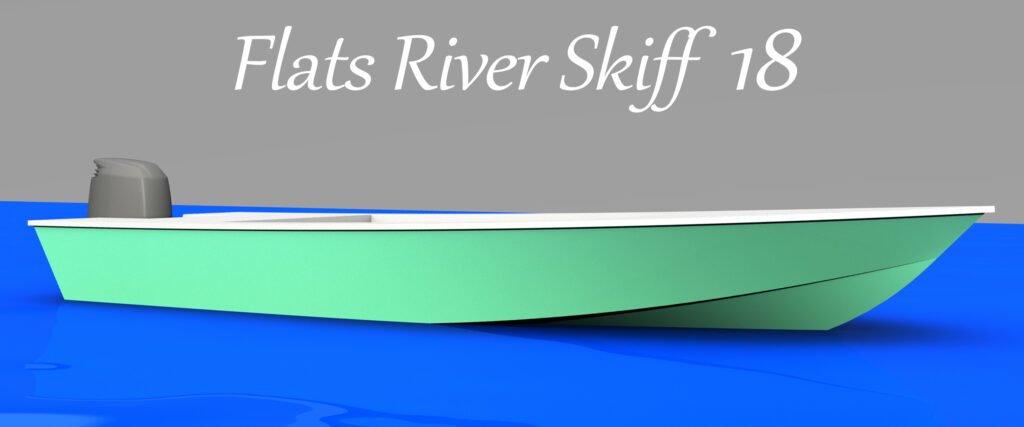
The Flats River Skiff 18 is the perfect bay and flats fishing boat.
- 18’6″ LOA
- 7’3″ beam
- 8″ – 11″ draft
- 5 people max
Cold Molded Designs

The CS-18 is a smaller version of our original CS-21 for those looking for a smaller boat with lower freeboard to inshore waters.
- Cruise 25-30mph
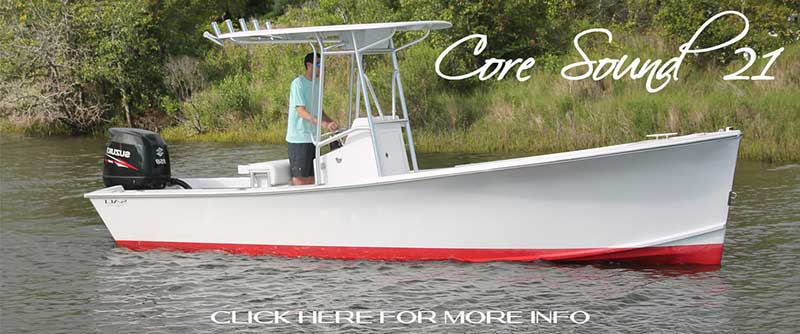
The CS-21 was inspired by the iconic Harkers Island style work boats. This center console design features unmistakable lines, a Carolina flared bow and a modified V bottom.
- 10″ – 12″ draft
- Cruise 30mph
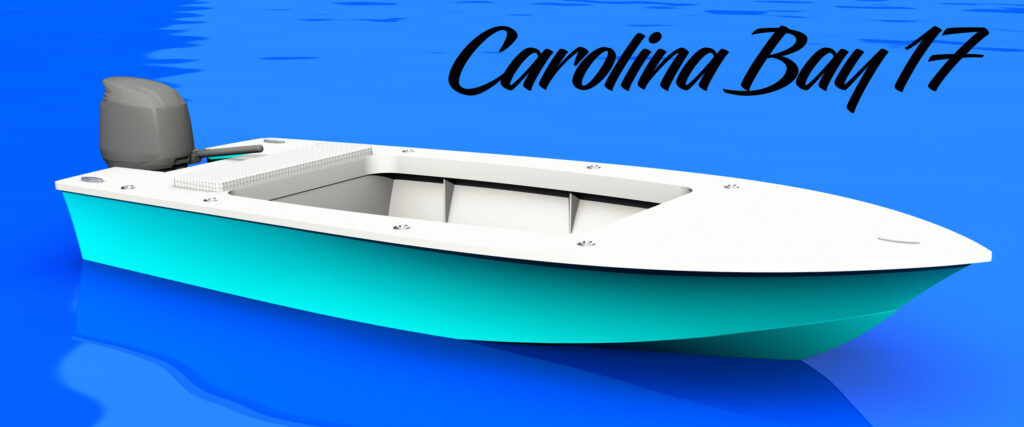
The CB-17 is the sister design to the FRS-16. She stands out as a custom flats boat with Carolina flare and rounded transom.
- 17′ LOA
- Cruise 25mph
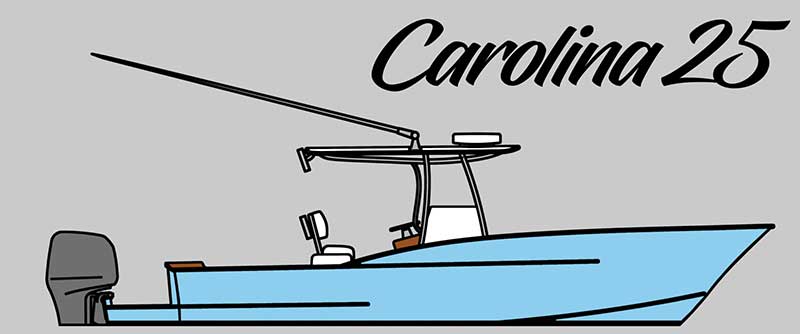
The C-25 is a North Carolina sport fishing boat in a trailerable center console layout. With Carolina flared bow, broken shear and tumblehome she is an iconic design.
- 28′ LOA (25’2″ hull)
- 8′6″ beam
- 16″ – 18″ draft
- 350hp single or twin 200hp max
- Cruise 30-35mph
More Info and Helpful Links
How to videos, plans & kits.
Become the Confident Skipper of Your Own Sailboat
How to make a small sailboat.
- Post author: Anns
- Post published: October 11, 2022
- Post category: Uncategorized
- Post comments: 0 Comments
Introduction
Are you looking for a fun and rewarding hobby? Making your own sailboat is a great way to spend your free time, and it can also be a very rewarding experience. A small sailboat takes about six months to complete, but if you have the right materials and tools on hand, it’s not too difficult.
Getting Started
In this series, we’ll be going through the entire process of making a small sailboat. This will cover everything from ideas and plans to building and launching.
By the end of the series, you should have all the knowledge required to build your own boat.
Buying the Materials You Need
When you are building a small sailboat, it’s best to buy the materials you need from an online store. That way, you can be sure that the parts will fit together correctly and that everything is of high quality. The following list includes all of the materials needed for this boat:
- Wood for framing (plywood)
- Planking (plywood)
- Balsa wood sheets or blocks for covering the hull with fiberglass resin and cloth tape
Constructing the Hull
When constructing your boat, it is important to consider all aspects of the hull. You want it to be strong enough for rough seas, able to withstand collisions with rocks and other boats, and watertight so that you don’t sink into the ocean. The hull will also have a significant effect on how long it takes you to build your boat—if it’s too heavy or difficult to transport, you’ll need more time than if you built one out of lightweight materials like carbon fiber or aluminum.
In addition to shaping its overall form, keep in mind that there are many different ways to construct a hull: some boats use wooden planks while others use composite materials such as carbon fiber or Kevlar; some have flat bottoms while others have rounded bottoms (rounded bottoms make fast sailing possible); some are made from metal sheets riveted together while others are molded together using plastic resin such as epoxy resin glue. The construction method that works best for you depends on what type of material(s) you’re using—and even then it may be necessary to experiment before finding optimal results!
Constructing the Sailboat’s Keel
Once you have the hull and deck formed, it’s time to attach the keel. The keel is one of the most important parts of your sailboat because it:
- Is heavy. The keel is usually made from fiberglass or wood, so it will be very heavy and add a lot of stability to your boat.
- Keeps the hull straight while sailing downwind at high speeds (called point-to-point sailing). It prevents wobbling around in circles when you’re using all that power!
The Deckhouse
The deckhouse is the cabin of your sailboat. It should be large enough for you to comfortably stand up in, and it needs to keep out water when it’s raining or when you’re going through waves. Also, if you want your sailboat to have a nice aesthetic, then you’ll want your deckhouse to look good!
The shape of your hull will determine the shape of your deckhouse. For example, if you have a round-hulled sailboat with no keel (a flat bottom), then there’s no reason why you shouldn’t make your deckhouse rectangular or square-shaped instead of attempting something more complex like an L-shaped design with rounded edges along each side because this would just waste materials without providing any functional benefit whatsoever compared against just using straight lines instead which are easier both financially as well as physically speaking since they don’t require any additional tools than what’s already available whereas curved lines do require special tools such those used by carpenters who work with wood frames such as saws designed specifically for cutting curves into wood pieces rather than straight lines which can be done easily without fancy equipment at all).
If however you were building this same boat using plywood sheeting rather than solid lumber boards though then different considerations might apply depending on whether or not there was sufficient space within those sheets’ thicknesses (they could only handle so much weight before breaking apart) versus their widths (how wide each sheet would need be before splitting along its lengthwise edge). In either case though I’d recommend sticking with simple geometric shapes unless absolutely necessary due to space limitations; otherwise stick with simple rectangles/squares since these tend
Fitting the Sailboat Together
Now that the hull, keel and mast are in place and secured, it’s time to make sure your boat is ready for water. First things first: check that your boat is watertight by testing it with a bucket of water. If any leaks appear, tighten the screws or add more glue before continuing on.
Next, turn your attention to the rigging and rudder. The rigging should be secure at all times; however if you feel like something is loose or if there are sharp edges poking out somewhere then feel free to trim them down as needed with scissors or sandpaper while they’re still attached to their respective parts (you can always cut off extra threads later).
If you haven’t already done so earlier this week, now would also be an ideal time for me for me test out my rudder on land before attaching it permanently into place on our sailboat!
Finishing and Painting Your Small Sailboat
Now that you have your boat, you can paint it. You’ll want to make sure that the paint is dry before using it. Make sure you are happy with the color before applying a second coat! If the paintbrush feels good on your hand and has a good point, then it will be easy to apply the paint evenly. If not, replace it with one that does so (be sure not to use an old one because then you might get some unwanted colors). Good luck!
Learn how to make your own sailboat
Learning how to make your own sailboat is one of those activities that can be a real eye-opener. It’s not for everyone, but for those who are interested in taking on such an endeavor, it can be a rewarding and enjoyable experience. There are many advantages to building your own sailboat; for example, you can choose the type of boat you want and customize it as much as possible based on your personal preferences.
The first step in learning how to make your own sailboat involves choosing a design that suits both your needs and abilities as well as finding the right materials needed for construction. You might find yourself working with wood or fiberglass if the project calls for either one of these materials (or both). If so, there are several ways this may be done including using traditional woodworking tools like saws while others prefer using power tools instead which speeds up production time greatly compared with hand tools but requires more investment upfront since these types require expensive equipment purchases before starting any projects needing them such as sanding machines used when finishing off surfaces after applying paint coats or varnishes coatings onto finished pieces made from different materials such as metal sections which may need buffing out after being painted over twice during initial stages before final touches were added later down line depending on type work being done which could range anywhere from weeks months depending size job being tackled at time being completed
In this article, we’ve covered everything you need to know about building your own small sailboat. We hope that by following these steps and examples, you will be able to design and construct your own boat!
You Might Also Like
How can we prevent cruise ship buffet rage a blog about cruise ship etiquette and behavior., top ways to stay fit in february, mos, leave a reply cancel reply.
Save my name, email, and website in this browser for the next time I comment.
- Activities for Kids
- Arts & Crafts
How to Build & Float Your Own Mini Sailboat

Crafting and outdoor exploration come together with this project—learn how to build a boat that floats and sails. The best part? You’ll only need to buy a couple of supplies because the main part of this barge is made from sticks that you find outside. Read on for the step-by-step instructions and you’ll soon have a ship to sail the high seas (or slow streams).
What You’ll Need
1 piece of paper (patterned scrapbook paper is nice, but plain construction paper also works)
2 craft sticks
string or twine
hot glue gun
14 sticks in similar sizes (5-6 inches long works well)
How to Make the Boat
1. Start by wrapping 12 the sticks together with your twine. We used Kid Made Modern Craft Twine ( target.com , $9.99) to add a pop of color, but white string would also work just fine. Tie one end of the twine to the end of one stick and wrap the string around a few more times, then move on to the next stick. Wrap the twine around that stick a few times and then use the same piece of twine to wrap the third stick and so on and so on until 12 of your sticks are connected. (You’ll use two elsewhere.) Don’t worry too much about how many times you loop around or how perfect your wrapping is. Knot off the twine on the last stick. Then, do the same thing on the opposite side of your sticks.
2. Wrap two sticks onto the bottom. Now add two more sticks, one on each end of your boat, to the bottom of your group of sticks. Again, tie a knot on one end of the stick then weave your twine in and out of the connected sticks, looping the twine around each stick and then around the stick on the bottom. Repeat for the second stick.
3. Cut 2 triangles out of your paper. Ours measured 5-inches along the side and bottom, but you may want to adjust based on the length of your sticks. We used Kid Made Modern Print Palooza patterned paper ( target.com , $7.99 for 150 sheets). However, if you have plain construction paper, ask your child to decorate it with stickers, crayons, markers, or any other way you like.
4. Add the craft sticks as your mast. Line up the craft sticks along the edge of the triangle to create your mast. Use a hot glue to secure the craft sticks.
5. Glue the triangles together. Ask your child to cover the two triangles with glue, using the glue stick. Then, press them together to complete your sail.
6. Connect the sail to the raft. Slip the craft stick in between two of the sticks in the middle of your boat. Use a piece of twine to wrap around the craft stick and around the two middle sticks until it feels fairly secure. To give it extra support, add hot glue all around the area where the craft stick and twigs come together.
7. Sail your boat. Once the glue has cooled and dried, your craft is ready for its first voyage. Fill a baby pool or other vessel (even the bath tub!) with water and watch your homemade schooner float.
8. Create some wind. Want to get your boat moving faster? Use a straw to blow it across the water.
9. Take it to the park. For further experimentation, we took our model to the park so it could sail in a real stream. Even after several sails and a few capsizes, our sailboat has held up.
Happy sailing!
Project inspired by Minieco’s handmade boats .
Have you crafted any boats with your kid? Tell us about your design in a comment.
–Julie Seguss
Need some fresh ideas?
Subscribe to our weekly newsletter for expert parenting tips and simple solutions that make life instantly better.
By subscribing you agree to Tinybeans Terms and Privacy Policy
Related reads

Why Are Gen Z Kids Covering Their Noses in Family Photos?

Screen Time for Babies Linked to Sensory Differences in Toddlerhood, Study Shows

Kids Shouldn’t Have to Finish Dinner to Get Dessert, Dietitian Explains

The Questions Parents Should Be Asking Their Pediatrician—but Aren’t

6 Better Phrases to Say Instead of ‘Be Careful’ When Kids Are Taking Risks
- your daily dose

- and connection

- Your daily dose

DIY Sailboat Kit: How To Impress Your Wife By Saying You Are Building A Boat From Scratch
Sure, you can always just buy a little sailboat for taking with you during the summer’s weekend trips. But why not impress the wife and kids by pretending to build one from scratch? That’s exactly what you can do with the DIY Sailboat Kit.
Made by the Balmain Boat Company, it’s a DIY sailboat kit that includes everything you need to assemble your own little sailer. Everything is pre-cut, too, so you don’t have to do any difficult cutting work (not that you have to admit that to anybody else) — just follow the instructions to put the individual parts together and you’ve got yourself a real boat you can take down the waters.
The DIY Sailboat Kit includes all the individual plywood pieces, screws, nails, glue, and even marine sealants for building your boat, as well as the mast, boom, gaff, sail and rope for catching the winds during your boat rides. You’ll need a hammer, a caulking gun and a drill, though, so make sure you have those ready if you’re trying to impress the wife and kids with your crazy boatbuilding skills. It ships in a flat-packed box measuring 3,000 x 700 x 230 mm that turns into a 3,000 x 1,300 x 515 mm boat once completely put together.
According to the product page, the boat takes approximately 30 hours to complete, so it will probably take you about 60, which still sounds awesome. You’ll need to give the epoxy and sealant two weeks to set, though, so don’t just drive down to the beach as soon as you finish the thing.
You can order the DIY Sailboat Kit directly from the BBCo website, priced at $2,590.

18 Homemade Wood Boat Plans You Can DIY Easily
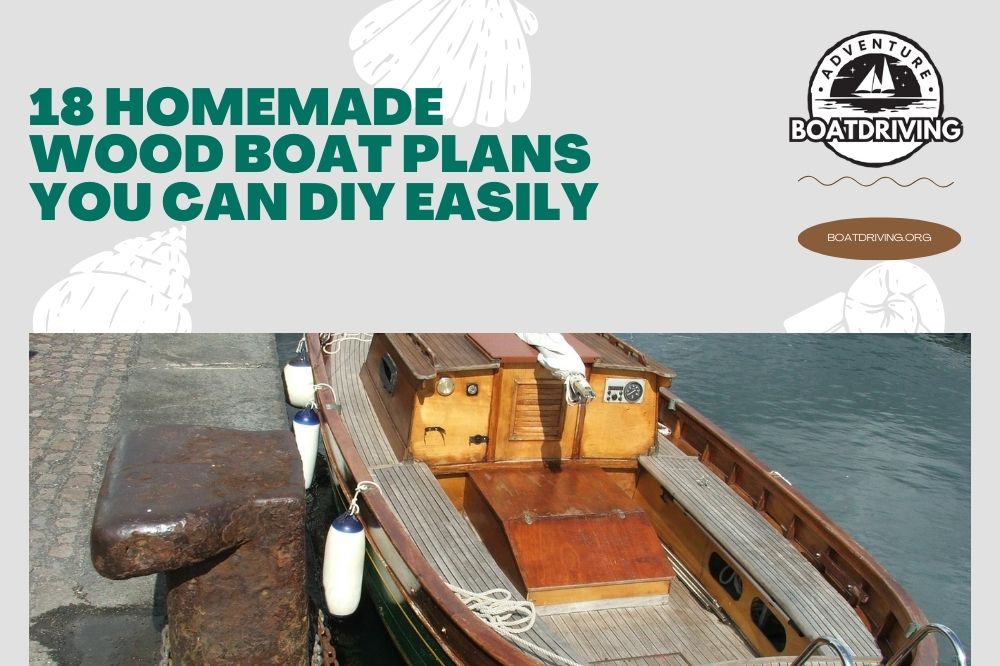
While the blissful and fun feeling a wooden boat offers while cruising in the calm waters is unparalleled, it is sometimes a luxury we cannot afford. Yes, quality wooden boats can cost a fortune!
How’d you like it if we say you can DIY a fantastic wooden boat from scratch all by yourself and for much cheaper?
It is an unmentioned fact that you’ll need a couple of pairs of helping hands and at least a basic woodworking skill, but the trouble you go through is so worth it in the end. We cannot wait any longer! Read on to find out 18 brilliant DIY wood boat ideas.
Table of Contents
1. Build a Boat Out Of Pine Wood
2. how to build a wooden boat, 3. 10 minute boat build || boat build start to finish, 4. how to build a wooden boat, 5. building a cedar strip canoe (full montage), 6. the ultimate 5-day diy plywood boat build, 7. wooden boat build (part 1), 8. how to build a wooden boat step by step, 9. fastest wooden big boat modern technology, 10. diy balloon-powered wooden toy boat, 11. wooden boat build – 17ft flat bottom skiff, 12. build a wooden boat, 13. to build a wooden boat: chapter one, 14. building a wooden boat, 15. amazing modern technology skill wooden boat building process, 16. how to build a boat, 17. building a wooden boat in my garage, 18. building a wooden deep v skiff.
Woodworking Tools in this video demonstrates a fast-forwarded tutorial on building a small wooden boat using pine wood.
On the downside, if you’re a beginner, you might find this tutorial hard to follow, as no specific instructions or step-by-step elaboration is given in this tutorial. Nevertheless, if you’re a fantastic observant, the DIY process is quite clearly demonstrated.
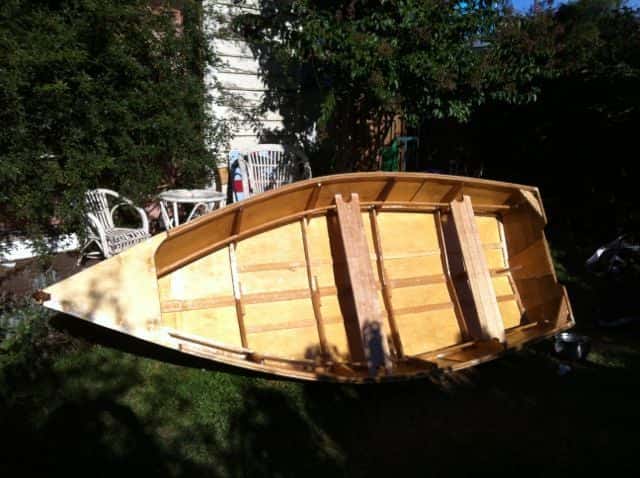
Are you a DIY noob when it comes to boatbuilding? If yes, we’d highly recommend this guide by Deep Sailing . A major decision one has to make while DIYing a wooden boat is to select the type of wood you want to work with.
Luckily, you’ll not only find step-by-step DIY instructions in this post but will also be provided with details on types of wood and different DIY boatbuilding methods . This post is a gem!
With proper tools and mediocre handyman skills, one can easily replicate what the Youtuber from Bourbon Moth Woodworking has accomplished in this video.
The end product is fantastic. So are the comments in this video. What’s more, this channel features plenty of other fascinating DIYs. Do check them out!
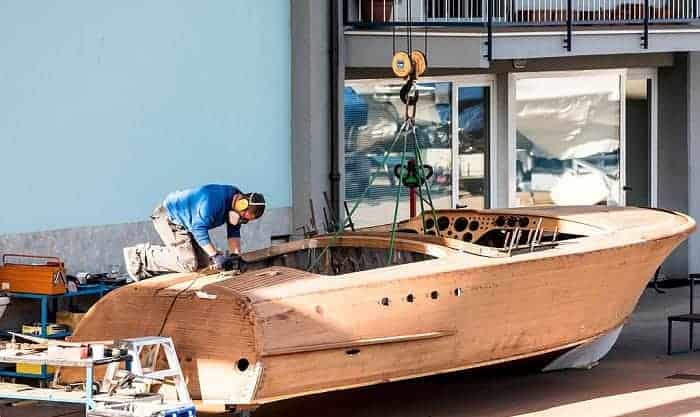
So, you’ve decided to build a wooden boat from scratch but don’t know where to start? Well, we’d say right here!
Gather supplies as per the list at the beginning of the post, buy a plan or design one yourself if you’re capable, and follow these seven well-organized steps to build a fantastic wooden boat for yourself. If you do, do share your experience with us!
What are your thoughts on building a cedar strip canoe? If your response is positive, here’s a fantastic DIY cedar strip canoe build video by A Guy Doing Stuff .
What we liked the most about this channel is that the Youtuber has further linked a few other topic-related resources in the description box from where his viewers can benefit. If this build has fascinated you, here are the 18 videos of this DIY series.
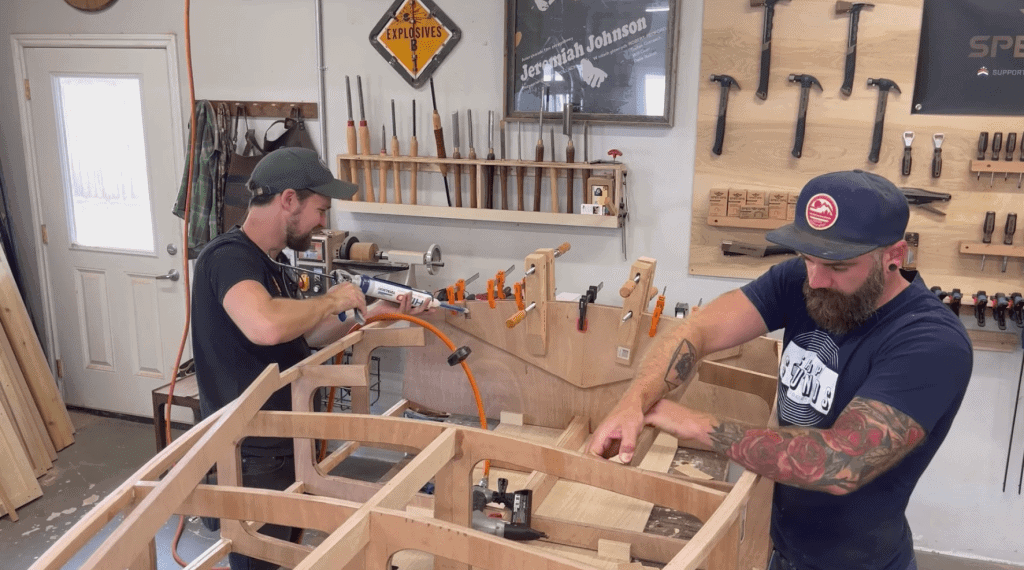
This short blog by Totalboat provides its readers with a brief insight on how Jason Hibbs from Bobon Moth Woodworking and Michael Alm from Alm Fabrications DIYed a wooden boat in a span of 5 days.
What’s amusing is that they didn’t even have a plan to start with. Watch the videos attached at the end of this post if you want to see how his DIY process went.
The Youtuber from Teys Cocset has presented a sequence of DIY images from his plywood boat build. He has used the stitch and glue method for this project. If this design is what you’d like to replicate, here is the second part of the boat build.
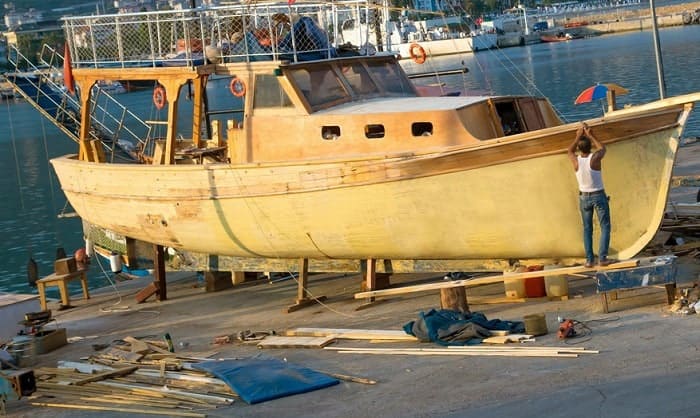
Here’s another step-by-step tutorial on how to build a wooden boat from Ride the Ducks of Seattle . The post features tools and a supply list, followed by 15 organized steps on the DIY process.
What’s more, there are a few solid tips the blogger would like to share with you regarding the project such that it becomes a major success in the first go. Don’t miss out on them!
The Youtuber from DIY Wooden Boat demonstrates to his viewers how to build a plywood boat. Unfortunately, the explanation in the video is not in English. Nevertheless, all the steps are clearly shown, and you can definitely take this video as an inspiration.
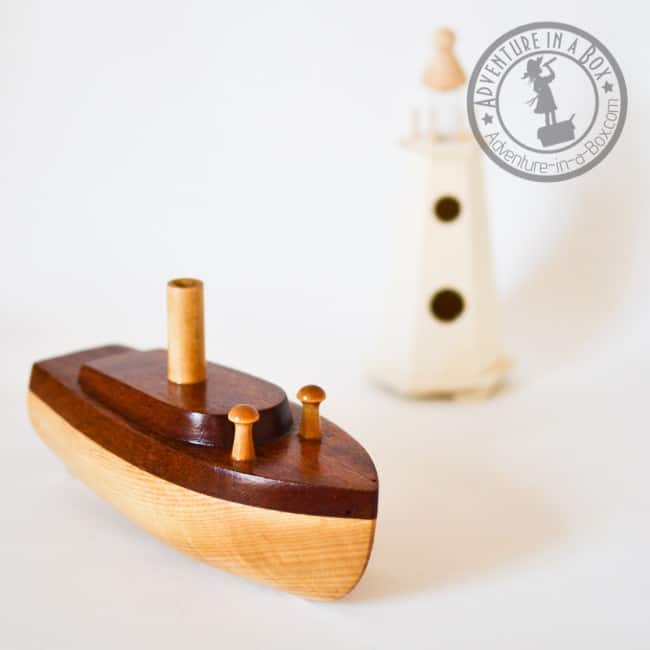
The blogger from Adventure in a Box shares with his readers how his family is crazy about ships and boats. Sounds relatable?
If yes, you’ll definitely love this brilliant ballon-powered DIY wood boat idea . If you have children, bring a smile to their faces with this project, and if you don’t, you always have your inner child who’s desperate for fun, playful times. This project looks so fun that we cannot wait to to DIY one for ourselves!
Here’s a video tutorial on building a 17 ft flat-bottom skiff by World boat skiff !
This tutorial video features a step-by-step explanation of the process accompanied by documented images from throughout the process. The attention to detail is excellent, and you’ll definitely be able to replicate this design.
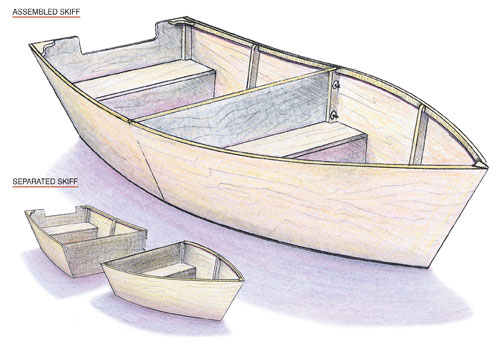
Now, if you don’t have a plan and are in the dark regarding the supplies and dimensions you need to build a wooden boat, look no further! We’ve got a perfect tutorial for you.
Will Shelton from Mother Earth News decided to clone a skiff his father built and has shared with his readers all the plans, designs, and dimensions for the project.
This is definitely one of the most detailed written tutorials for both DIY noobs and experts to follow. We hope Mr. Shelton’s tutorial will be a great help to you.
The description of the video says – This is not a ‘How-to’ series but a ‘Why you should’ series. To all the boating and boat DIY fanatics, you shouldn’t sleep on this content put out by Matt Dean Films .
This is just ‘Chapter one’ of the series, and the further chapters are expected to be published throughout 2022. Stay tuned!
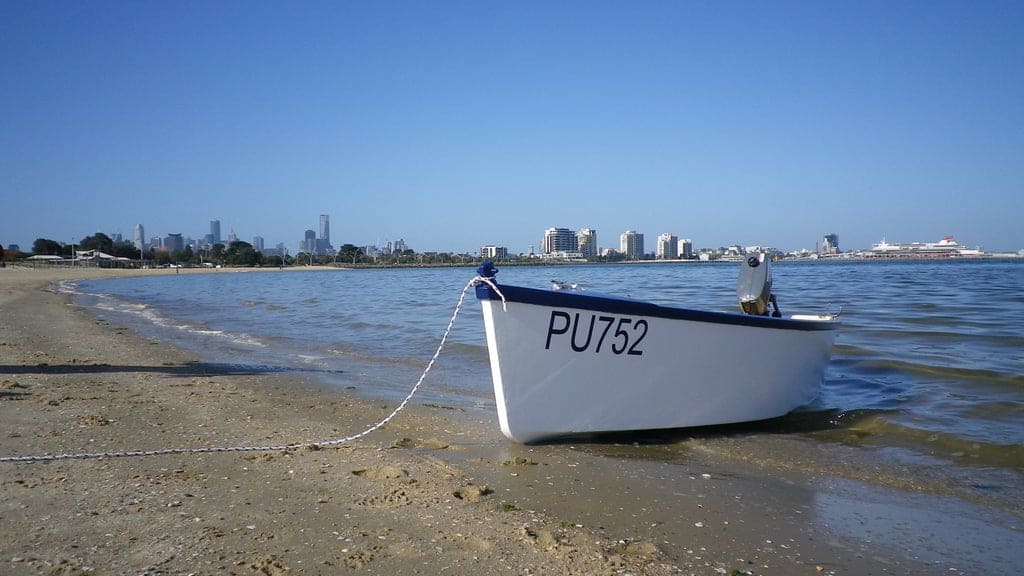
For his fellow boat DIY enthusiasts, Msil3070 has shared all his plans and his entire DIY process in detail in this post on Instructables .
You can find all the materials, their dimensions , and tools required for the DIY at the beginning of the tutorial. The project took 4 months for Msil3070 to complete. Let us know how long it took for you!
The Youtubers from DIY Wooden Boat have built a professional-looking sleek wooden boat in this video. This DIY features a cold-molded hull.
While this is not a serious tutorial per se, you can definitely take ideas and inspiration from this video. What’s more, this channel features plenty of wooden boat DIYs and other boat-related videos. Boat fanatics will surely find them fascinating.
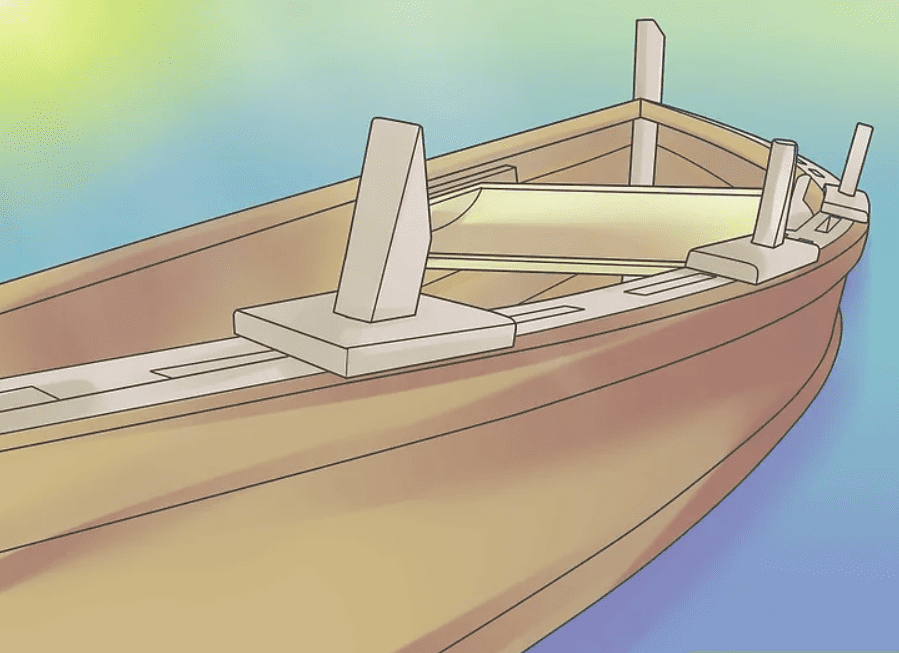
When it comes to ‘How-tos’, Wikihow never fails to deliver. If you’re a beginner in woodworking DIYs, this 12 ft by 30 inch and 11-inch deep canoe build tutorial using the stitch and glue method is perfect for your first boatbuilding project.
As always, every step of the process is elaborated in detail with clear illustrations. Also, don’t forget to check the tips and warning section at the end of the blog.
Clint Hauger, in this video, DIYs a 19ft Albion Skiff designed by Jeff Spira. The tutorial is in a slideshow format accompanied by a brief explanation of each step.
Everyone in the comment section is raving about how great the build is. This video is short yet extremely informative!
Learn how to build a 14’6’’ wooden V skiff by watching this video tutorial by Robin Hodgkinson. The original plan of this build was ‘Little Moby’ by Charles Wittholz to which many changes were made.
The Youtuber elaborates on steps involved, tips, tricks, successes, failures, and warnings in this video. He also shares the plans and designs at the beginning of the video. Overall, this video is surely worth the watch!
So, which among these 18 wood boat DIY ideas did you find most easy to replicate?
While it is important to be honest to yourself regarding your handyman skills while attempting DIYs like these, you can always start small to gain skill and confidence. Also, you can always request a pair of helping hands for the project.
Have you ever DIYed a boat? If yes, what was your experience? What are the Dos and Don’ts? Help fellow DIY enthusiasts out!
Related posts:
- 27 Homemade Boat Plans You Can DIY Easily
16 Homemade Plywood Boats Plans You Can DIY Easily
- 17 Homemade RC Boat Plans You Can DIY Easily
- 15 Homemade Dog Dock & Boat Ramp Plans
Similar Posts

16 Homemade Boat Console Plans You Can DIY Easily
Is your boat console old, damaged, in short, a total wreck? If yes, you might be rightfully worried about the money you’ll have to invest in over-priced consoles available commercially? Luckily, building a boat console is a completely DIY-friendly project. In fact, we’ve prepared a list of 16 DIY boat console ideas for you. Install…

18 Homemade Boat Trailer Plans You Can DIY Easily
To watercraft enthusiasts, owning a boat trailer is non-negotiable. If you want to protect your invaluable crafts from harsh weather, you need to carry and store them in weather-protected facilities. And the great news is that those handy with metalworking tools don’t find it difficult to DIY a boat trailer all by themselves. So, if…

17 Homemade Jet Boat Plans You Can DIY Easily
Okay, so you’ve decided to DIY a fun and functional jet boat! But where do you start? Do you buy a kit? Do you build it from scratch? What are the Dos and Don’ts of the project? Well, hundreds of such questions are probably roaming around your head. To your rescue, we’ve created this fantastic…

18 Homemade Aluminum Boat Plans You Can DIY Easily
For many boat enthusiasts, building their first DIY boat is a dream come true. It’s not only about the money you save avoiding the commercial route but also about the sheer joy you experience while boating on the craft you built. So, are you looking forward to building your first DIY aluminum boat? If yes,…

18 Homemade Boat Anchor Plans You Can DIY Easily
Losing an anchor is not surprising news in the field of boating, is it? In fact, for this reason alone, many recommend going on a voyage with two anchors on the boat. Unfortunately, anchors can be pretty expensive. So, why not DIY your own homemade boat anchor? Whatever your handyman expertise is, we’ve got your…

DIYing a plywood boat is not just about saving money. It’s about utilizing your craft to create something meaningful that you’ll utilize with pride and joy and savor the memories even if the product is no longer with you. If you’ve found your new passion in boating and fishing, you’ll definitely want to DIY at…
Leave a Reply Cancel reply
Your email address will not be published. Required fields are marked *
Save my name, email, and website in this browser for the next time I comment.
- Privacy Policy
- Terms Of Service
The Self-Sufficient Living Is about simple living,growing your own food,raising livestock,Do It By Yourself,off grid living,gardening,homemade products
13 free boat plans you can build for cheap.
Farhan Ahsan April 12, 2023 Camping & Survival , DIY 9,934 Views
Imagine being the captain of your very own boat that you built yourself! I remember the excitement of building DIY boats with my family. We found some free boat plans online and got to work. It was a great bonding experience and saved us a lot of money.
With these free boat plans, you can build your own water vessel without breaking the bank. Whether you love sailing, rowing, or just relaxing on the water, there’s a DIY boat for you. And the best part is, they’re small enough to easily take to the lake or river.
I remember thinking about all the fun we’d have on the water once our boats were finished. We could go fishing, have races, or simply enjoy the scenery together. It was exciting to think about all the adventures we’d have as a family with our homemade boats. Think of all the fun afternoons you can spend with your family enjoying water sports and get busy building some of these cheap watercrafts.
Quick Navigation
1- Flat Bottom Punt
If you’re looking for a DIY boat that’s both affordable and spacious enough for 2-3 people, I suggest trying out this free plan for a flat bottom punt by hvartial . I remember when I built one of these with my friends, and it was perfect for our fishing trips on the nearby lake.
This flat bottom punt is great for shallow waters, making it ideal for fishing or even duck hunting. We found it really sturdy, especially when we added a small outboard motor. And if you prefer a quieter experience, you can easily propel it with a pole or oars. It was so versatile!

2- Classic Boat Plans
A boat gives you freedom on the water so you can explore areas that are not accessible by land. As we know boats are an expensive luxury items unless you build one yourself. These free plans by popularmechanics will show you how to build a classic boat that will give you freedom on the water for many years.
You can download and print out the detailed instructions from the PDF manual. The printed instructions can be taken outside to the building site so you can build this boat with ease.
A classic boat like this one will allow you to fish, hunt, explore, or just relax on the water.

3- Woodworkers Dream Boat
Building a wooden boat from YouTube is an exciting project, especially if you’re into woodworking like I am. I remember the satisfaction of creating something with my own hands, knowing it would bring joy for years to come on the water.
The free boat plans on YouTube guide you through crafting a wooden boat that comfortably fits 3-4 people. It’s perfect for a day of fishing with loved ones. I’ve found that these homemade boats are not only sturdy but also spacious enough to carry fishing, hunting, or camping gear. With a boat like this, you can embark on weekend getaways, exploring new areas and enjoying nature to the fullest.
4- Mouseboat Plans
Coming in at number four is a simple DIY boat design that resembles a kayak but offers better stability on the water with its squared hull. I remember building one of these mouseboats using plywood and zip ties, following the instructions from Instructables . It was a breeze to put together, resulting in a lightweight and secure boat perfect for solo adventures.
The squared end and semi-flat bottom design make this boat ideal for fishing, ensuring safety and stability on the water. With enough space for one person and a bit of fishing gear, it’s a cost-effective way to enjoy the water without breaking the bank. Plus, its lightweight nature allows for easy transportation, whether carrying it upstairs or securing it on the top luggage rack of your vehicle.

5- Plywood Boat Plans
Building your own boat can be a wonderful bonding experience with your kids. I remember when my dad and I built a small sailboat together; it was a project filled with learning and laughter. Watching a YouTube video for guidance can simplify the process, making it accessible for both beginners and experienced builders alike.
Plywood boats are practical and manageable projects, especially if you have limited space like I did in my small apartment. The detailed plans provided in the video ensure that you have clear instructions every step of the way. Plus, working with plywood keeps the cost down while still producing a sturdy and reliable vessel for your adventures on the water.
6- Stitch And Glue Kayak
Creating your own boat can be a rewarding journey, blending craftsmanship with adventure. I recall when I built my first kayak using similar free plans like this one by instructables ; it was a process of trial and error that ultimately led to a vessel I was proud to call my own.
Following these freeboat plans opens up a world of possibilities. From selecting the perfect wood to mastering the art of stitching and gluing, each step brings you closer to your own custom kayak . Not only is kayaking a fantastic way to stay active and explore nature, but building your own kayak also adds a sense of accomplishment and connection to your watercraft. Whether you’re paddling solo or with loved ones, the memories you create on the water will be priceless.

7- Little Boat
Crafting your own boat evokes a sense of adventure and fulfillment, reminiscent of the time I stumbled upon plans on Wikihow for a compact wooden vessel. Its size perfectly suited for car-top transport, it promised boundless fishing and hunting escapades without the hassle of towing.
The detailed guidance provided in these complimentary plywood boat blueprints streamlined the construction process, transforming a modest investment into a seaworthy craft. Owning a pair of these boats expanded the joy of water exploration, allowing for shared experiences with friends or loved ones, doubling the excitement on our aquatic outings.

8- Two Piece Wooden Boat
Building your own boat can be a fulfilling adventure, much like when I discovered plans for a two-piece wooden vessel. Its size and sturdiness were enticing, but what intrigued me most was its clever design, allowing for effortless disassembly and storage.
These fishing boat plans from motherearthnews offer versatility for various water activities. Whether you’re angling with friends or cruising with family, the spacious design accommodates your needs. The convenience of disassembling the boat means you can easily transport it on a small trailer, opening up possibilities for exploration in distant waters.
When not in use, the compact storage of the two-piece boat ensures it won’t clutter your space, leaving room for other adventures. With your homemade watercraft at the ready, you can embark on fishing trips, duck hunts, or simply unwind on tranquil waters, creating memories to cherish for years to come.

9- Pontoon Boat
This YouTube video will provide you with pontoon boat plans so you can easily and cheaply build one for yourself.
This homemade pontoon boat on youtube has plenty of seating for the whole family and is covered so everyone will be protected from the burning rays of the sun. A deck surrounds the seating so there is plenty of space for fishing, jumping into the water, sunbathing, and picnicking.
The recycled 55-gallons drums keep the pontoon boat buoyant and the small outboard motor keeps the boat on course to your chosen destination.
10- Blow Up Raft Boat
Transforming an ordinary blow-up raft into a fully equipped fishing boat is not only affordable but also a rewarding endeavor, much like my own experience of creating a customized watercraft from unconventional materials. These free boat plans offer a practical solution for anglers on a budget, allowing you to craft a fishing boat complete with seating and entertainment amenities.
The DIY boat featured by littlethings ensures a safe and enjoyable fishing experience for two, boasting ample space and comfort for a full day of angling. Equipped with essential features like fishing rod holders, a trolling motor, and paddles, this makeshift vessel is ready for adventure with minimal investment. By adding personal touches like a cooler, bait, and fishing tackle, you can tailor your boat to suit your specific needs, guaranteeing countless hours of fun on the water.

11- PVC Pipe Pontoon Boat
Crafting your own boat can lead to inventive solutions, much like when I stumbled upon plans for a flat top pontoon utilizing PVC pipes. Its unique design promised affordability and quick assembly, allowing for spontaneous lake outings without delay.
Watching a YouTube video demonstrating the propulsion of the pontoon by a small outboard motor sparked my imagination for future adventures. The lightweight construction of the watercraft made it easily transportable, whether on the roof rack of a vehicle or a compact camper trailer . With free boat plans available online, you too can embark on the journey of building your own PVC pipe pontoon boat, offering endless possibilities for leisurely activities on the water.
12- $200 Pontoon Boat
You can build a pontoon boat for $200 with these free boat plans on YouTube. It’s a low budget DIY project that uses 55-gallon drums as the floatation device and treated lumber for the decking. Great for fishing or trolling around the lake with a small outboard motor.
The platform is large enough for the whole family so this cheap pontoon boat on youtube video will provide hours of fun for everyone. Use it to go fishing, swimming, picnicking, and exploring. Good cheap family fun from this $200 wooden pontoon boat that you can build yourself.
13- Electric Motor Boat
Crafting your own boat opens doors to creativity and innovation, much like when I delved into building a DIY boat resembling a surfboard, but with the added twist of a small electric motor. Inspired by similar projects showcased in YouTube instructions , I envisioned the potential for free-sailing adventures by incorporating a sail into the design.
Utilizing foam akin to that used in surfboards for the boat’s bottom provided not only buoyancy but also enhanced stability on the water. The inclusion of a comfortable seat ensured leisurely outings, whether fishing or exploring the lake’s tranquil waters.
The lightweight nature of the foam rendered the boat effortlessly portable, facilitating easy transport to any desired destination. Its compact size allowed it to snugly fit atop most vehicles, offering convenience for spontaneous excursions. With detailed plans available on YouTube, constructing this electric motor boat became a straightforward endeavor, requiring just a few hours of dedication to bring the vision to life.
Having your own boat is quite expensive as compared to the one you made yourself. Enjoy time on water, sail, or hunting fish with your friends and family with these easy to make boats . You can select from any of these free boat plans to build your boat that suits your skills and budget.
References:
JSTOR, The Journal of Educational Thought, Vol. 39, No. 1 (Spring, 2005), Published By: Werklund School of Education, University of Calgary, “Boat Building: A Metaphor for Teaching as a Creative Enterprise” , https://www.jstor.org/stable/23767484
Web.archive.org, International Journal of Online Pedagogy and Course Design, 3(3), 43-61, July-September 2013, “A Study on Project-Based Learning in a Boat Design and Building University Course” https://web.archive.org/web/20190307033244id_/http://pdfs.semanticscholar.org/d9f6/cee1e5a83de34c8eb23c960c67b6c9a69bc3.pdf
Education Royal Society Of Chemistry, “Building a chemically powered boat” , https://edu.rsc.org/in-search-of-solutions/building-a-chemically-powered-boat/1170.article
About Farhan Ahsan
12 DIY Garden Rooms You Can Build Yourself To Work from Home
A DIY garden room is a new trend for creating more space in your existing …
Leave a Reply Cancel reply
Your email address will not be published. Required fields are marked *

How to Build a Boat: 25 Designs and Experiments for Kids
If you subscribe to the Inspiration Laboratories newsletter , you know we had fun making boats a while back. I’ve been collecting ideas for how to build a boat ever since. You’ll love these ideas. They are kid-friendly, doable, and you probably have the supplies for most of them on hand. I get commissions for purchases made through the affiliate links in this post.

How to Build a Boat
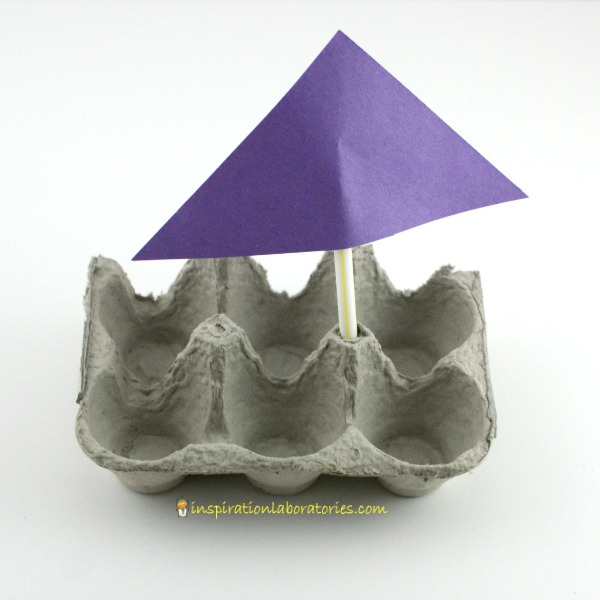
Materials to Consider
What materials can you use to make a boat that actually floats? Here’s a list to get you started:
- Paper (will it need to be waterproofed?)
- Plastic container
- Egg cartons
- Cardboard (will it need to be waterproofed?)
- Orange peel
- Craft sticks
- Sticks from a tree or other pieces of wood
What other materials am I leaving out? Comment below and let me know.
More to Consider
What else do you need to construct the boat? String or something to fasten pieces together? Glue or tape? Will the boat fall apart once it’s placed in the water?
Our egg carton boat was simply made by placing a straw into the egg carton and taping on a piece of paper. It floated in the bathtub pretty easily. We didn’t test the sail. Would it actually work?
Who will the passengers be? What will the boat carry?
After building the boat, see how much weight it can hold. (Pennies are a good option for older kids to use.)
Ways to Build a Boat
Create a boat building challenge.
- Try this Cork Raft Building Challenge from Kitchen Counter Chronicles.
- Discover which materials make the best boats . Science Sparks shows you how.
- Design a speedboat and test to see if it will float like Creative Family Fun.
- Teach Preschool set up two boat building stations with different materials. Compare the designs and see how they’ll float.
- Allow your child to decide on the materials they’ll need to build a boat that floats as well as how they’ll design the boats. Planet Smarty Plants tells of their design process.
- Here’s a simple boat science experiment from East Coast Mommy. Build boats, test their buoyancy, and predict how many rocks it will take to sink them. Check out their materials and design.
- What unique materials could you use? The Craft Train made their boats using sponges and duct tape .
- Craftulate has 5 boat designs . I especially like the way they made the speedboats out of foam.
- Challenge your child to build a hydrofoil . How much weight can it hold before sinking? Kids Activities Blog has the instructions.
- Let you child be in charge of investigating different boat designs . Will a shell work for a boat? Fantastic Fun and Learning finds out.
Design a Boat Powered by Wind
- Learn how to make a paper boat from My Little 3 and Me. What types of paper work best?
- NurtureStore shows us 3 ways to make a sail boat . Pay attention to the design of the sail.
- Add some sparkle to your design. Mama Pappa Bubba made cork sail boats with sparkly sails .
- Create a boat from a juice box . hands on : as we grow has the plan.
- Make pool noodle boats like Frogs and Snails and Puppy Dog Tails.
- Build wax boats like these from Housing a Forest.
- Race duck tape boats across the water. Mess for Less tells us how.
- These ice boats made of natural materials from Reading Confetti are simply lovely.
Build a Boat Powered by Something Other Than Wind
- Make a self-propelled tug boat . Red Ted Art has the tutorial.
- Make a balloon powered egg boat . Capri+3 has instructions and a video to show you how.
- Or try this balloon powered boat from Life with Moore Babies.
- This baking soda powered boat from Science Sparks is sure to be a hit.
- Adventure in a Box builds a toy wooden paddle boat .
- Sail a boat down a homemade river like Gift of Curiosity.
Share a picture of your boats with me on Inspiration Laboratories on Facebook !
More Hands-On Science Ideas for Kids
- 20 Ways to Build a Rocket: Experiments and Crafts for Kids
- 10 Ways to Make a Volcano with Kids
- 8 Egg Drop Experiments plus ideas and tips for designing your own
Subscribe to our newsletter and get exclusive science explorations for young scientists in each issue.
This post was originally published on April, 28 2015.
Leave a Reply Cancel reply
Your email address will not be published. Required fields are marked *
Save my name, email, and website in this browser for the next time I comment.
© 2024 Inspiration Laboratories
- PRO Courses Guides New Tech Help Pro Expert Videos About wikiHow Pro Upgrade Sign In
- EDIT Edit this Article
- EXPLORE Tech Help Pro About Us Random Article Quizzes Request a New Article Community Dashboard This Or That Game Happiness Hub Popular Categories Arts and Entertainment Artwork Books Movies Computers and Electronics Computers Phone Skills Technology Hacks Health Men's Health Mental Health Women's Health Relationships Dating Love Relationship Issues Hobbies and Crafts Crafts Drawing Games Education & Communication Communication Skills Personal Development Studying Personal Care and Style Fashion Hair Care Personal Hygiene Youth Personal Care School Stuff Dating All Categories Arts and Entertainment Finance and Business Home and Garden Relationship Quizzes Cars & Other Vehicles Food and Entertaining Personal Care and Style Sports and Fitness Computers and Electronics Health Pets and Animals Travel Education & Communication Hobbies and Crafts Philosophy and Religion Work World Family Life Holidays and Traditions Relationships Youth
- Browse Articles
- Learn Something New
- Quizzes Hot
- Happiness Hub
- This Or That Game
- Train Your Brain
- Explore More
- Support wikiHow
- About wikiHow
- Log in / Sign up
- Cars & Other Vehicles
- Boat Building
How to Make a Sail
Last Updated: November 8, 2023
This article was co-authored by Nitzan Levy . Captain Nitzan Levy is a Sailor, Social Entrepreneur, and the Founder of Sailors NYC, a recreational sailors’ club based in Jersey City, New Jersey that specializes in cruising boats and a variety of community programs. Capt. Levy has over 20 years of sailing experience and has sailed in many places around the world including: the Atlantic Ocean, the Mediterranean Sea, The Caribbean, and the Indian Ocean. Capt. Levy is a U.S. Coast Guard Licensed Master of vessels up to 50 Tons with Auxiliary Sail and Assistance Towing Endorsements. Capt. Levy is also a NauticEd Level V Captain Rank Chief Instructor, an American National Standards Assessor, an SLC instructor, an ASA (American Sailing Association) Certified Instructor Bareboat Chartering, and an Israeli licensed skipper on Boats for International Voyages. This article has been viewed 111,661 times.
Ships and boats of all sizes have harnessed the power of wind for centuries. Sailing boats have continued to use sails to this day for recreational sports and hobbies. Whether you’re looking for a calm day on the water or to compete in a race, making your own sail can be a beneficial skill.
Getting Started

- Research the dimensions of similar sails and have an idea of what kind of sailing you’d like to do. This gives basic reference points to research and execute.

- If you are planning to sew the sail yourself, you will also need a special sewing table to be able to support the industrial sewing machine. This table needs to be about twice the size of a table tennis table in order to support the size of the sail.

- Shorter booms give you more maneuverability.
Designing the Sail

- The luff curve won’t match the curve of the mast. The top third of the luff curve will be slight and the bottom of the curve, close to the boom, will be greater than the mast curve. There are different theories on what the perfect luff curve should be so research how to optimize the luff curve for your prefered type of sailing.

- If you want more stability, add more battens; however, use less battens to make your boat easier to manoeuvre and more lightweight.

- Use heavier materials near the bottom of the sail. Seams also help to optimize the amount of material you use.

- Tape fabric or newspaper together for more surface area when creating a large sail.
- The luff curve and shaping the seam will create a three dimensional sail so don’t worry if your sail lies flat as you construct your pattern.

- Ensure that the material you choose resist stretching and can withstand rips.
- Heavy monofilm and woven sailcloth are common choices.
Assembling the Sail

- Stick and sew two panels at a time until the sail is all in one piece. You can now trim it to your design on the table and draw on the batten pockets.

- Create an adjustable head for your sleeve if this is your first attempt at a sail.
- Use pulleys from old sails or get them from a sail maker.
Expert Q&A

- Know what shape you want and rig your sail until it takes that exact shape. Thanks Helpful 0 Not Helpful 0
- Learn what type of sails work best for your vessel relative to the sailing conditions. Thanks Helpful 0 Not Helpful 0

- Create a budget to ensure you optimize your resources. Thanks Helpful 1 Not Helpful 1
- Design with safety first, do not cut corners to favor aesthetics or cost. Thanks Helpful 0 Not Helpful 0
Things You'll Need
- Sailcloth, polytarp, nylon or Dacron sail material
- Industrial sewing machine
- Measuring tape
- Sail pattern
- Double sided adhesive tape
- Dacron tape or reinforced monofilm tape
You Might Also Like

- ↑ http://www.startedsailing.com/sail-battens.html
- ↑ http://jezebel.com/5916905/how-to-turn-your-dress-idea-into-reality-by-making-your-very-own-custom-pattern
- ↑ Nitzan Levy. Sailing Instructor. Expert Interview. 24 April 2020.
About This Article

To make a sail, first sketch the luff curve using your boom and mast measurements. Next, choose a scratch-resistant material that works best for your budget and sailing needs, such as Monofilm or Pentex taffeta scrim laminate. Then, place your pattern onto your material and outline the panel, battens, and seams. Once you have your sail’s shape, cut out the panels, and stitch them together, leaving extra cloth at the edges for seams. For more tips from our Nautical co-author, such as how to reinforce your sail against the elements, read on! Did this summary help you? Yes No
- Send fan mail to authors
Did this article help you?

Featured Articles

Trending Articles

Watch Articles

- Terms of Use
- Privacy Policy
- Do Not Sell or Share My Info
- Not Selling Info
Get all the best how-tos!
Sign up for wikiHow's weekly email newsletter
5 DIY Boat Bimini Top Ideas & Expert Tips to Master the Wave!

Welcome aboard, fellow boat enthusiasts! Are you ready to embark on a DIY adventure that will take your boat game to the next level? Well, shiver me timbers, because we’ve got just the thing for you! In this article, we’re diving headfirst into the exciting world of boat bimini tops. Whether you’re a landlubber or an experienced sailor, we’ve got expert tips and five homemade boat bimini top ideas that will make your boat the envy of all the marinas.
Before we set sail, let us introduce you to our secret weapon: tinktube’s building material. This innovative building system will make your DIY projects a breeze, providing you with sturdy, reliable materials to bring all your designs to life. But wait, there’s more! If you have questions along the way, we’ve got your back. You can book a free call with our technical expert extraordinaire, Esteban. He knows the ins and outs of building with tinktube like nobody else, and he’s more than happy to lend a helping hand.
So, whether you’re a novice or a seasoned pro, it’s time to hoist the anchor and set sail towards boat bimini top greatness. Get ready to be amazed as we unveil these fantastic ideas that will transform your boat into a floating paradise. Let’s dive in, me hearties!
But first, what is the difference between 3-bow and 4-bow bimini?
The 3-bow bimini top, my friend, is the tried and true classic. It’s the go-to option for V-hull runabouts, ski boats, performance boats, and most center consoles. This beauty provides just the right amount of shade without compromising style. It’s like having a trusty first mate by your side, always ready to shield you from the sun’s relentless glare.
But hold your sea horses, because we’re not done yet! If you happen to be the proud captain of a larger vessel, like a pontoon or a deck boat, then the 4-bow bimini top is what you need. This bad boy is built to handle the bigger boats, offering even more shade and coverage. It’s like having a giant parasol for your boat, ensuring that you and your crew can lounge in cool comfort, sipping your favourite refreshments without a worry in the world.
So, there you have it: you are now armed with the knowledge to choose the perfect shade provider for your vessel. Remember, it’s all about finding the right match for your boat, so you can sail in style and comfort!
1. Bimini top for Jon boat
This Jon boat bimini top is a true masterpiece of DIY: you’ll have the freedom to customize the size and shape to perfectly fit your Jon boat, ensuring seamless integration with your vessel.
But here’s where the magic truly happens – this bimini top is foldable! Yes, you heard it right. With a clever design and the use of the right connectors, you’ll be able to easily collapse and fold the top whenever you need some open sky above. It’s like having the best of both worlds: shade and protection when you desire it, and a clear view of the blue skies whenever you’re in the mood for an unobstructed experience!

2. DIY Jon boat bimini top
Picture this: you’re cruising on the open water, the wind in your hair, and the sun shining down on your boat. But wait, you need some shade to protect your skin from those scorching rays. That’s where a bimini top like this one comes in handy!
If you decide to build a similar project with tinktube, know that you can bend the tubes to avoid using fittings in some areas of your build!
3. Bimini top for pontoon boat
Like the first 2 examples, it can be created with high-quality steel tubes and connectors, ensuring durability and reliability. The main difference between 3-bow and 4-bow bimini boat tops is we’re adding a few more tubes and connectors to create a heavy-duty structure that can handle anything you throw its way!
With a 4-bow bimini top, you’ll have the perfect shelter from the sun’s rays. This extra bow adds even more coverage, providing ample shade for you and your fellow passengers.
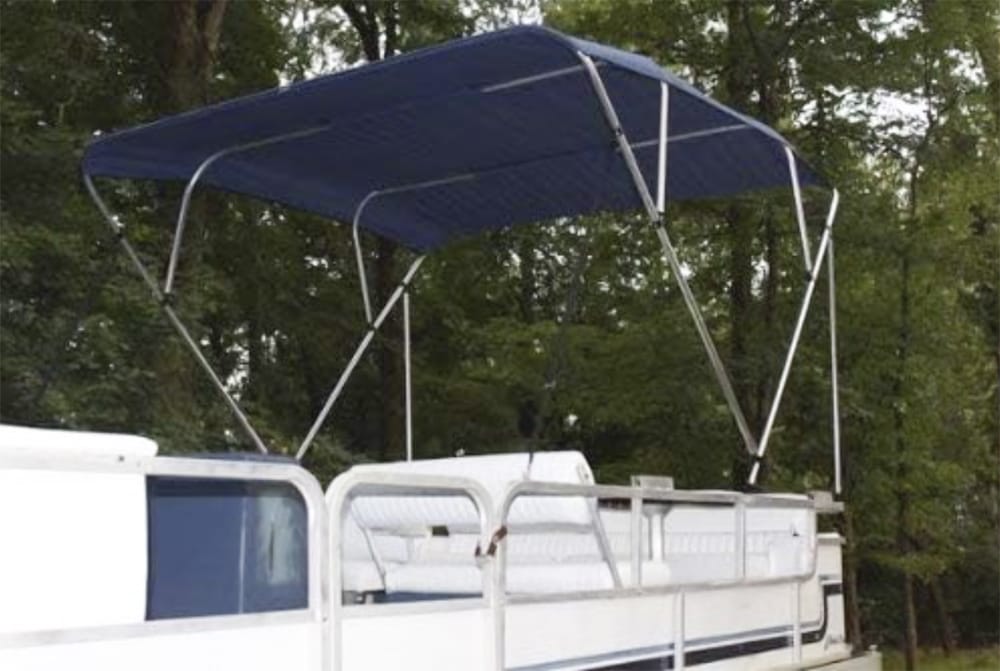
What size tubing is used for bimini top?
When it comes to bimini top frames, you need tubing that can withstand the wildest waves and the fiercest winds. And that’s where tinktube’s steel tubes enter the picture. Made of galvanized steel and painted in a variety of colours, they are the perfect match for your bimini top DIY. Let’s dive into the specs, shall we?
tinktube’s steel tubes specs
Our galvanized steel pipes come in a diameter of 1-1/16″ (that’s 28 mm for you metric-minded sailors), making them sturdy enough to handle whatever the open water throws at you. And here’s the best part: they come in a convenient length of 92″.
How to cut a steel pipe
Need a custom length? No problemo! With a handy-dandy pipe cutter , you can slice through those pipes like a swashbuckling hero, adjusting them to the desired length in just a few seconds. All you’ll have to do once the pipes are cut is assemble them together with our fittings !
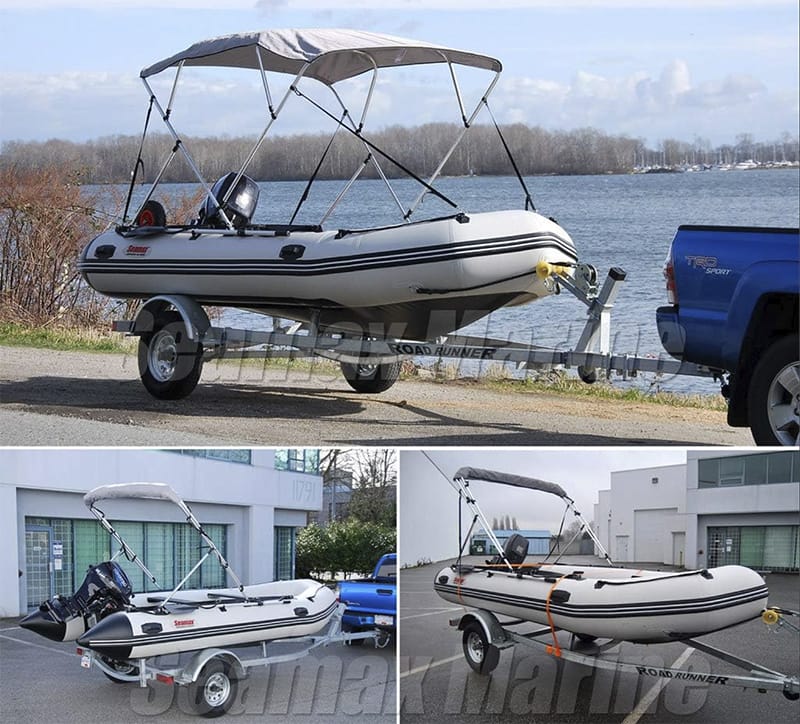
4. DIY boat bimini top
When building your own boat bimini top project, you have the power to customize the dimensions and style to fit your boat’s exact specifications. Once you’ve constructed the sturdy frame, it’s time to focus on the next crucial step: choosing a high-quality fabric to ensure maximum comfort and durability.
Selecting the right fabric is essential to enhance your boating experience. You’ll want a fabric that not only provides excellent shade but also withstands the elements and offers long-lasting performance. Look for fabrics that are UV-resistant, water-repellent, and have excellent tensile strength to ensure they can withstand the rigors of boating.
What is the best marine fabric for bimini top?
There’s a fabric that reigns supreme in the realm of bimini tops, and its name is vinyl. Yes, vinyl is the superhero fabric that saves the day. But not just any vinyl, mind you. We’re talking about vinyl-coated fabrics, typically made of trusty polyesters, such as the legendary Stamoid.
Why is vinyl the chosen one, you ask? Well, let us enlighten you. This magical fabric is not only waterproof but also has the superpower to divert water to the sides of the top for a perfect runoff. Say goodbye to pesky water pooling on your bimini top. With vinyl, you’ll stay dry and ready to conquer the seven seas!
But wait, there’s more! Vinyl is not just a water-repelling wizard; it’s also a durable and long-lasting companion for your bimini top. It’s like having a sturdy shipmate who can withstand the harshest of conditions, from sun rays to fierce winds and salty spray. Vinyl’s got your back, keeping your bimini top looking shipshape for years to come.
5. Custom boat bimini top
With a custom DIY boat bimini top, the possibilities are endless. As you can see, this idea has a completely different design, which makes it easier to cover a bigger part of the boat with shade. Even though it’s not foldable, it can be an interesting option for some people, as it is also simpler and easier to build!
Tailor it to fit your boat perfectly and let your creativity run wild! Your bimini top should reflect your style, enhance your boating experience, and make a statement on the water!
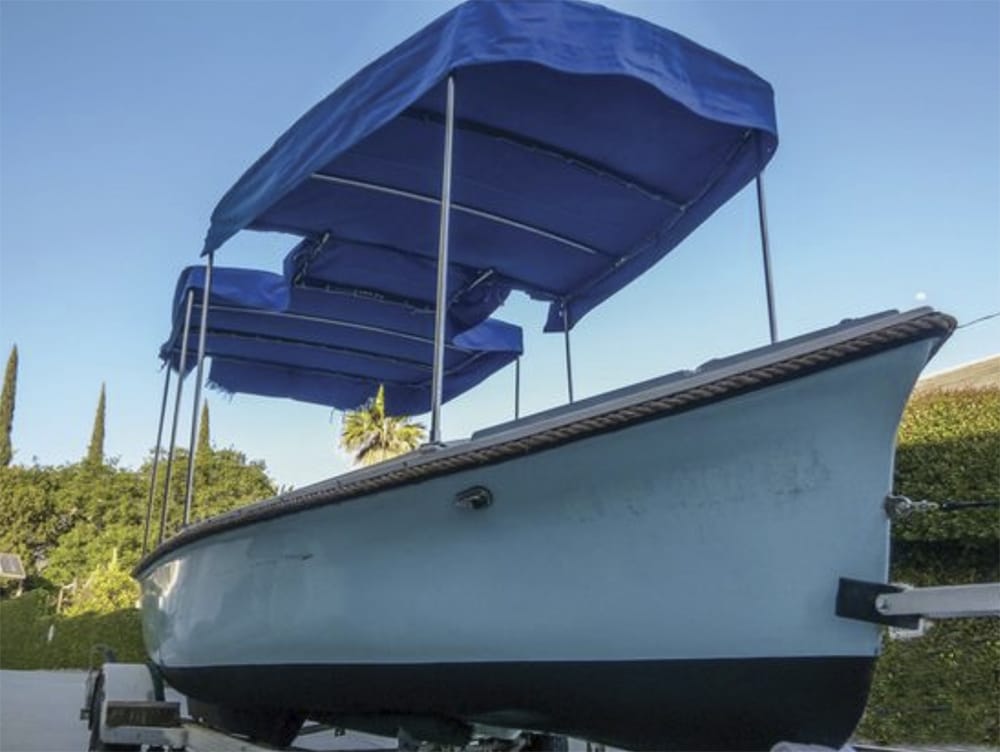
Raise the Bar with these Game-Changing Bimini Top Ideas
We’ve explored a world of DIY possibilities for boat owners looking to elevate their boating experience with a homemade bimini boat top. We’ve showcased the versatility and adaptability of tinktube’s building materials, which provide a strong foundation for your DIY project. The galvanized steel pipes offer not only durability but also a touch of style to your creation. And whether you opt for the classic 3-bow bimini top or the spacious 4-bow for larger boats, you now have the knowledge and inspiration to embark on this exciting DIY adventure.
We hope these ideas will help you create a custom shade and shelter solution that perfectly suits your needs! By building your own bimini top, you not only save money but also gain a sense of accomplishment and customization. Imagine the satisfaction of taking your boat out on the water, knowing that the shade and comfort above are products of your own ingenuity and craftsmanship…!

Arbor made by Ian
Ian built an arbor for his frontyard path.

Metal or Wood: The Ultimate Showdown of Materials for DIY Railings

DIY Portable Duck Blinds: Quacking Your Way to Hunting

DIY Gate Plans: Fence Gate for Gardens and Backyards

Cover frame by Thomas

Garden trellis by Destin
About the author, éloïse sirois, leave a comment cancel reply.
You must be logged in to post a comment.
Got more questions? Schedule a 15 minute call with Esteban!
Or visit our FAQ and Tutorials

Share your project and get 10% !
Our team is always looking for new project ideas to share in the DIY world!
Share pictures of your projects with us and we’ll send you a 10% coupon code to use on your next purchase!
Lawyer for megachurch pastor blamed 12-year-old for initiating ‘inappropriate’ sexual conduct
In 1982, pastor Robert Morris was a 21-year-old husband and father who traveled the country telling young people about Jesus.
Cindy Clemishire was a 12-year-old girl who dressed in flowery pink pajamas and still liked to play with Barbie dolls.
On Christmas that year, Morris — who would go on to found Gateway Church in Southlake, Texas, and become a leading figure in the American evangelical movement — began what he would later describe as “inappropriate sexual behavior” with Clemishire while he was staying at her parents’ home in Oklahoma. Clemishire said Morris told her to come see him in his room before bed, and she was the type of girl who listened to instructions from trusted adults.
But 25 years later, when Clemishire hired an attorney and threatened to sue Morris, accusing him of repeatedly molesting her as a child, a lawyer representing Morris responded by blaming Clemishire for what happened to her, according to 2007 correspondence obtained by NBC News.
“It was your client,” wrote lawyer J. Shelby Sharpe, referring to Clemishire at age 12, “who initiated inappropriate behavior by coming into my client’s bedroom and getting in bed with him, which my client should not have allowed to happen.”

The Feb. 6, 2007, letter was one in a series of exchanges that year between Sharpe and Gentner Drummond, a lawyer who represented Clemishire at the time. Clemishire said in an interview last week she had been seeking $50,000 in restitution from Morris to cover the cost of counseling. Morris, through his lawyer, instead offered to pay $25,000, but the talks fell apart, Clemishire said, because she was not willing to sign a nondisclosure agreement.
Drummond, who is now Oklahoma’s attorney general, confirmed Clemishire’s description of the 2007 negotiations and declined to comment further.
Reached by phone Monday, Sharpe said that he had no recollection of the $25,000 settlement offer or NDA demand and that he no longer represents Morris. He denied knowing at the time that Clemishire had been a child when Morris began engaging in sexual behavior with her. However, the initial correspondence Drummond sent to him stated clearly that Clemishire was “twelve years old” when the abuse began.
“I don’t ever remember seeing that,” Sharpe said after a reporter read the document to him. After a reporter offered to share a copy of the messages, Sharpe said he did not have time to read them and declined to share an email address.
“I can tell you that the letters that you’ve seen, they speak for themselves,” said Sharpe, who has also served as a personal attorney to Paige Patterson , a Southern Baptist Convention leader accused of mishandling or concealing sexual assaults that date back to the late 1980s. “I will not amplify beyond those letters, because they speak for themselves.”
Morris did not respond to messages.

Clemishire went public with her accusations last month in a post published by the church watchdog site The Wartburg Watch . Morris responded with a statement admitting to “inappropriate sexual behavior” and saying he had long ago confessed and repented. Gateway Church leaders initially said Morris had been “open and forthright about a moral failure he had over 35 years ago” but later said they did not know Clemishire was a child at the time.
Within days, Morris resigned as senior pastor of the megachurch he started in 2000, and Gateway elders hired an outside law firm to investigate the matter.
Lawrence Swicegood, a Gateway spokesperson, said church leaders had not seen the 2007 letters between Drummond and Sharpe. Swicegood said that before Clemishire went public with her story last month, “the current Elders did not have all the facts.”
Gateway sex abuse scandal
- Pastor Robert Morris confesses to "inappropriate sexual behavior" after Cindy Clemishire accuses him of molesting her as a child in the 1980s.
- Morris resigns as senior pastor of Gateway Church.
- In secret recording , a Gateway elder says accepting Morris' resignation was "one of the most difficult decisions in my life.”
- Emails reveal Clemishire's attempts to seek restitution from Morris in 2005.
- Morris asked his accuser how much her silence would cost , a phone transcript shows.
While the internal review is underway, four Gateway officials have agreed to take leaves of absence from the board of elders, the church announced last month . One is pastor James Morris, Robert Morris’ son. The three others served on the board of elders during the critical period from 2005 to 2007 when Clemishire was seeking damages.
“Gateway Church is committed to protecting people — first and foremost children and the most vulnerable,” Swicegood said in an email. “Abuse simply cannot be tolerated.”
Clemishire, now 54, sees the 2007 letter from Sharpe as part of a pattern of Morris and his associates’ attempting to make her feel guilt and shame for what he did to her.
“They don’t look at a child as someone to protect,” Clemishire said.
Clemishire said she struggled for years with “profound confusion” over what Morris did, believing for nearly two decades that she was to blame. She said Morris molested her more than 100 times over 4½ years. After the first encounter on Christmas in 1982, Clemishire said, “it just progressed to a lot of kissing and touching and inserting fingers into my body.” She said Morris pressured her to have intercourse, but she refused. Morris has acknowledged “kissing and petting” and argued that the number of incidents was a fraction of what Clemishire alleges.

Clemishire said that in the mid-2000s, after years of counseling and after having watched a television interview about grooming and sex abuse, she realized what happened to her was a crime.
She began writing to Morris at his Gateway Church email address in 2005, asking that he compensate her for the trauma she says he inflicted. In 2007, she hired Drummond to make a formal demand, according to documents provided to NBC News by Boz Tchividjian, the lawyer she hired last month.
On Jan. 30, 2007, Drummond wrote to Sharpe on behalf of Clemishire, using her legal name at the time, Cindy Clemishire McCaleb. Drummond detailed the sexual abuse Clemishire says she suffered from 1982 to 1987 and how Morris “led her to believe that they were having a special relationship that had to remain secret.”
“Morris convinced Ms. McCaleb that she was responsible for what he did to her,” Drummond wrote, “and he convinced her that she was the offender.”
Drummond attached a draft of a lawsuit he said Clemishire planned to file if Morris failed to respond within 15 days.
"Reverend Morris began sexually assaulting Ms. McCaleb, who was then twelve years old." Gentner Drummond, Jan. 30, 2007
Sharpe responded a week later, on Feb. 6, 2007, with his letter casting Clemishire as the one who initiated sexual contact with Morris.
"It was your client who initiated inappropriate behavior by coming into my client's bedroom and getting in bed with him, which my client should not have allowed to happen." J. Shelby Sharpe, Feb. 6, 2007
Sharpe also claimed in the letter that Clemishire “acted inappropriately with two other men who stayed in her home between 1982 and 1987,” when she was between the ages of 12 and 17. And Sharpe wrote that Clemishire had “confessed her conduct” to Glenda Faulkner, a woman who attended Shady Grove Church near Fort Worth, Texas, in the 1980s, when Morris was a pastor there.
Faulkner, now Glenda Faulkner-Woodliff — a licensed counselor who later attended Gateway — did not respond to messages requesting comment.
In an interview, Clemishire disputed Sharpe’s characterizations. She said two other men touched her inappropriately at her home when she was a child, but she said she did not initiate those interactions. In one instance, Clemishire said, it was Morris who instructed her, when she was 13, to go into a bedroom at her childhood home where another traveling evangelist was staying. Once she was inside, she said, the man, whom she declined to name, began to kiss her but eventually pulled away and told her she was too young.
In another instance, in 1986, Clemishire said, another man who was staying with her family climbed on top of her while she was sleeping on a sofa bed next to his 3-year-old daughter. She believed he planned to rape her, but she said the man suddenly got off of her.
“I really think God intervened,” Clemishire said. “God made him feel like someone was walking by, and he just rolled off of me and left.”
It was that incident, Clemishire said, that eventually led her to confide in Faulkner-Woodliff, also a family friend. Faulkner-Woodliff asked whether anyone else had ever touched her that way, Clemishire said. Clemishire then reluctantly explained what Morris had done to her, she said. Afterward, Clemishire said, Faulkner-Woodliff insisted that she tell her parents.
That’s how, in March 1987, her father learned that Morris had been sexually abusing her, Clemishire said. She said her father was enraged and contacted Olen Griffing, the senior pastor at Shady Grove Church, to demand that Morris step out of ministry.
Clemishire remembers getting a call from Morris’ wife, Debbie, a few days later.
Debbie told her, “I forgive you,” she said.
“I’ll never forget that,” Clemishire said. “They wanted me to believe that I — me, the child — was responsible for what happened. And they’ve never stopped trying to make me believe that.”

Griffing, now in his 80s, later served as a pastor and elder under Morris at Gateway Church. He did not respond to messages.
Clemishire’s older sister was living with her family in 1987 and corroborated Clemishire’s account of conversations that took place that year among her sister, her parents, Faulkner-Woodliff, Griffing and the Morris family.
In the years since then, Morris has repeatedly told a sanitized and, at times, distorted version of the story. He has spoken often from the pulpit of struggling with sexual immorality and having to step out of ministry in 1987. But in public tellings, he says sinful pride was the reason, omitting mention of his years of sexual contact with a child.
In a sermon at Gateway on June 10, 2017 , in a message titled “The Principle of Honesty,” Morris described going through a “restoration process” about seven years into his marriage — which would have been in 1987. Morris said God told him he needed to confess “everything that I’ve ever done” to two people: Griffing, the former Shady Grove senior pastor, and his wife, Debbie.
He said he told Debbie, “I need to tell you who you really married.”
The confession took several hours, Morris said in the 2017 sermon, but he did not mention specific sins from the pulpit.
“I’ll never forget what she said,” Morris said, setting up a line that drew laughter from the Gateway congregation. “She said, ‘Robert, I knew you were bad when I married you. I didn’t know you were that bad.’”
When he told that story again on Aug. 28, 2022 , in a sermon titled “Passing the Purity Test,” Morris presented his openness about his past failings as something congregants should emulate.
In that sermon, he recounted the Old Testament story of King David’s son Amnon, who is said to have raped his half-sister Tamar when she was a teenager. After he raped her, the Scripture says, Amnon’s love for Tamar turned to intense hatred, Morris said.
Morris presented the passage as a cautionary tale for “young ladies” in his congregation — a warning about what can happen when girls allow men to have sex with them before marriage.
“When love turns to lust and lust is fulfilled, then love can turn to hate, and here’s why,” Morris said. “One of the reasons, young ladies, that he loves you is he respects you. The very thing that the world tells you to give him so you can keep him could be the very thing that causes you to lose him.”
Because, he said, “you can’t love someone you don’t respect.”

As she has watched Morris grow in power, prominence and wealth over the years, Clemishire said, she has always believed none of it would have been possible had he not hidden the truth of what he did to her.
On Feb. 16, 2007, Sharpe, Morris’ lawyer, sent a follow-up letter to Drummond indicating a desire to keep her allegations out of court. He proposed settling the matter through “Christian arbitration consistent with 1 Corinthians 6:1-8,” referring to a Bible passage evangelicals often cite to argue it is immoral to sue other Christians.
Sharpe said he had one goal with the suggestion: “I was at the time trying to reach a good resolution for everybody.”
But Clemishire, who did not agree to the arbitration, believes the true goal had been to keep her quiet and protect Morris from the types of repercussions he has faced since she went public last month.
“I don’t think there was any true repentance or sorrow for what happened,” Clemishire said.
Otherwise, she said, “that would not have been the response.”
Mike Hixenbaugh is a senior investigative reporter for NBC News, based in Maryland, and author of "They Came for the Schools."
Antonia Hylton is a correspondent for NBC News.
- Cast & crew
A high-powered CEO puts her career and family on the line when she begins a torrid affair with her much younger intern. A high-powered CEO puts her career and family on the line when she begins a torrid affair with her much younger intern. A high-powered CEO puts her career and family on the line when she begins a torrid affair with her much younger intern.
- Halina Reijn
- Nicole Kidman
- Harris Dickinson
- Antonio Banderas

- Intern Rose

- Uber Driver

- All cast & crew
- Production, box office & more at IMDbPro
More like this

- December 20, 2024 (United States)
- United States
- New York City, New York, USA (street scenes)
- Man Up Film
- See more company credits at IMDbPro
Technical specs
Related news, contribute to this page.
- See more gaps
- Learn more about contributing
More to explore
Recently viewed.

IMAGES
VIDEO
COMMENTS
Check out my Patreon to help support the boat build! - https://www.patreon.com/jackwood25Guten Morgen! After months of building and filming, I'm finally post...
Sailboats that you can build from home will likely be a small boat under 20 feet. These could be from many different boat suppliers such as B&B Yachts, Brooks Boat Designs, and Chase Small Craft. Boat plans will vary based on your budget and how much time you have on your hands. Based on my previous experience, building your own boat will take ...
6. DIY Foldable Boat for Only 30$! Fits in Car Backseat! Making a DIY boat doesn't need to cost a fortune, and if you're on a limited budget, this is the plan for you. In it, you'll learn how to make a small foldable boat that you'll be able to fit in the back seat of your car - without spending more than about $30.
For example, the 21ft gaff-rigged cutter I'm currently building will end up costing between $33,000 and $35,000, fully outfitted—several thousand dollars more than the new prices of a couple of popular fiberglass boats near the same size. And yes, since it's wood, it will demand more maintenance.
15. Zip Tie and Ply Mini Boat. If you'd like to get out on the water for a fun day of fishing or sight-seeing, consider building this unique mini-boat. It's made from zip ties and plywood. Though it may sound a little sketchy on the surface, it seems quite buoyant and inexpensive too.
When building a wooden sailboat, it is important to pay attention to every step, including the installation of the cabin and interior features. To install these features, follow the following steps: 1. First, measure and cut the materials for the cabin walls, floor, and ceiling. 2.
Build a Short Dragon (16 Foot 3-Board Outrigger Sailing Canoe) 20 Boats You Can Build Yourself: It's getting warm again, so why not build yourself a boat for some summer adventures? The authors on Instructables have you covered with all sorts of amazing boats you can build yourself!These boats range from easy to advanced, and some can be built….
More sailboat parts you can make while waiting for other parts to cure are the spars, the structural parts that support the sail. The mast is another glue up. I used 3 - 1x3's of hemlock. A relatively soft wood, but with a nice tight grain with no knots. A mast would break at a knot, regardless of how strong the wood is.
The next step was to clamp thin strips of wood, called battens, to the frame to stand in for the planks, so I could measure and mark all those angles. Then, I took the parts off the board and ...
Free Boat Plans You Can Build This Week (with PDFs) 1. The Wanigan. PC Duckworks Boat Builders Supply. The Wanigan boat began as a garvey design, which is one of the older boat plans known to the Americas. Traditionally, these boats were built as work scows and were very popular among American summer camps.
Here are the steps to follow when installing the cabin: Build the cabin on a flat surface using marine-grade plywood. Cut the cabin to fit the deck and hull and sand the edges to ensure a tight fit. Apply a layer of epoxy to the cabin and deck joint to seal it. Secure the cabin to the deck using screws or bolts.
These boatplans & designs range in size from 5.8 mts to 20 mts and can be built in many different materials. We have boat plans & designs for building in steel or aluminium in either multichine, radius chine or round bilge hull forms. Most boat plans & designs are also in fibreglass using either c-flex, foam sandwich or single skin hull ...
Free Boat Plans. A selection of Free Boat Plans that can be viewed and / or downloaded. These free to download wooden boat plans (pdf) were first published in magazines such as "Popular Mechanics", "Popular Science" and the "Boat Builder's Handbook". "Popular Science" magazine and "Popular Mechanics" back issues can be viewed online at Google ...
4. A Plywood Box. The simplest and fastest way to build your own boat is to craft a glorified plywood box with a pointy or up-turned end. Plenty of examples and how-to videos can be found on YouTube, including one which costs less than $200 to put together called "Boat Built in Two Days."
Learn More - Buy Plans / Jig. The C-25 is a North Carolina sport fishing boat in a trailerable center console layout. With Carolina flared bow, broken shear and tumblehome she is an iconic design. 28′ LOA (25'2″ hull) 8′6″ beam. 16″ - 18″ draft. 350hp single or twin 200hp max. Cruise 30-35mph.
Fitting the Sailboat Together. Now that the hull, keel and mast are in place and secured, it's time to make sure your boat is ready for water. First things first: check that your boat is watertight by testing it with a bucket of water. If any leaks appear, tighten the screws or add more glue before continuing on.
Use a hot glue to secure the craft sticks. 5. Glue the triangles together. Ask your child to cover the two triangles with glue, using the glue stick. Then, press them together to complete your sail. 6. Connect the sail to the raft. Slip the craft stick in between two of the sticks in the middle of your boat.
The DIY Sailboat Kit includes all the individual plywood pieces, screws, nails, glue, and even marine sealants for building your boat, as well as the mast, boom, gaff, sail and rope for catching the winds during your boat rides. You'll need a hammer, a caulking gun and a drill, though, so make sure you have those ready if you're trying to ...
Read More 16 Homemade Boat Dock Plans You Can DIY Easily. Diy. 18 Homemade Aluminum Boat Plans You Can DIY Easily. By BoatDriving.org March 21, 2024 March 22, 2024. For many boat enthusiasts, building their first DIY boat is a dream come true. It's not only about the money you save avoiding the commercial route but also about the sheer joy ...
12- $200 Pontoon Boat. You can build a pontoon boat for $200 with these free boat plans on YouTube. It's a low budget DIY project that uses 55-gallon drums as the floatation device and treated lumber for the decking. Great for fishing or trolling around the lake with a small outboard motor.
Adventure in a Box builds a toy wooden paddle boat. Sail a boat down a homemade river like Gift of Curiosity. Your Turn. Share a picture of your boats with me on Inspiration Laboratories on Facebook! More Hands-On Science Ideas for Kids. 20 Ways to Build a Rocket: Experiments and Crafts for Kids; 10 Ways to Make a Volcano with Kids
1. Draw the front of the sail. The front of the sail is called the luff curve. The luff curve is the most important part of the sail because the rest of the sail's integrity depends on it. The luff curve at front of the sail relates to how your mast will bend. The luff curve won't match the curve of the mast.
1. Bimini top for Jon boat. This Jon boat bimini top is a true masterpiece of DIY: you'll have the freedom to customize the size and shape to perfectly fit your Jon boat, ensuring seamless integration with your vessel. But here's where the magic truly happens - this bimini top is foldable! Yes, you heard it right.
Letters sent in 2007 by a lawyer for Robert Morris shed light on how the pastor explained his past sexual behavior with a child — and who else might have known about it.
Babygirl: Directed by Halina Reijn. With Nicole Kidman, Harris Dickinson, Antonio Banderas, Jean Reno. A high-powered CEO puts her career and family on the line when she begins a torrid affair with her much younger intern.